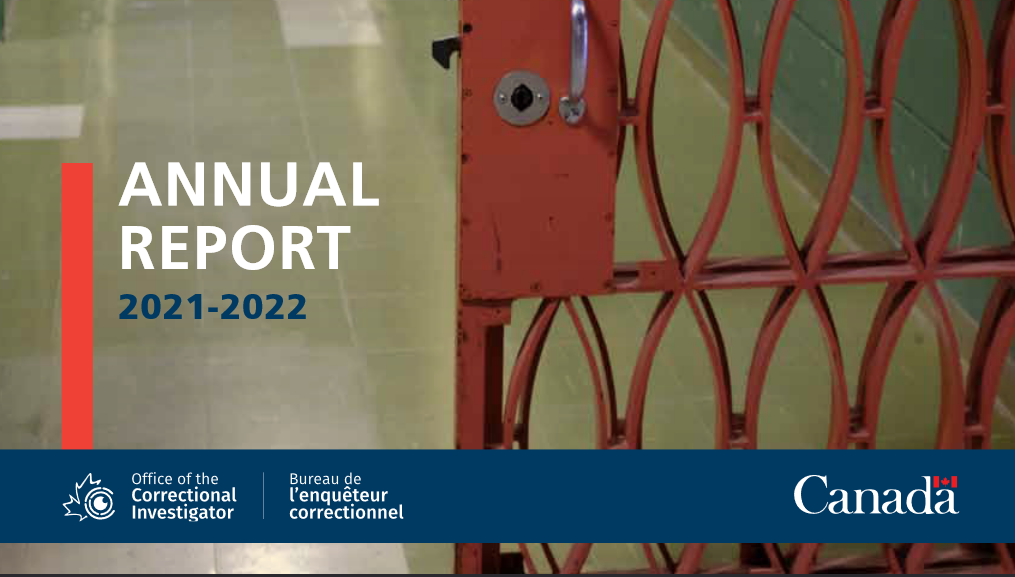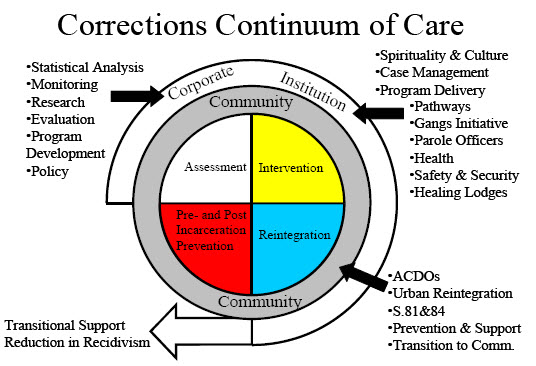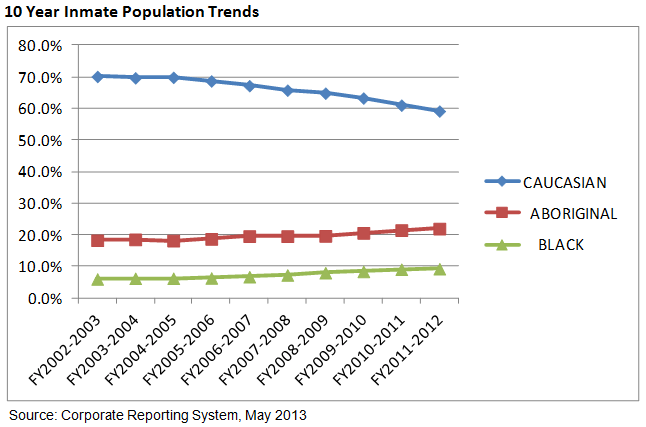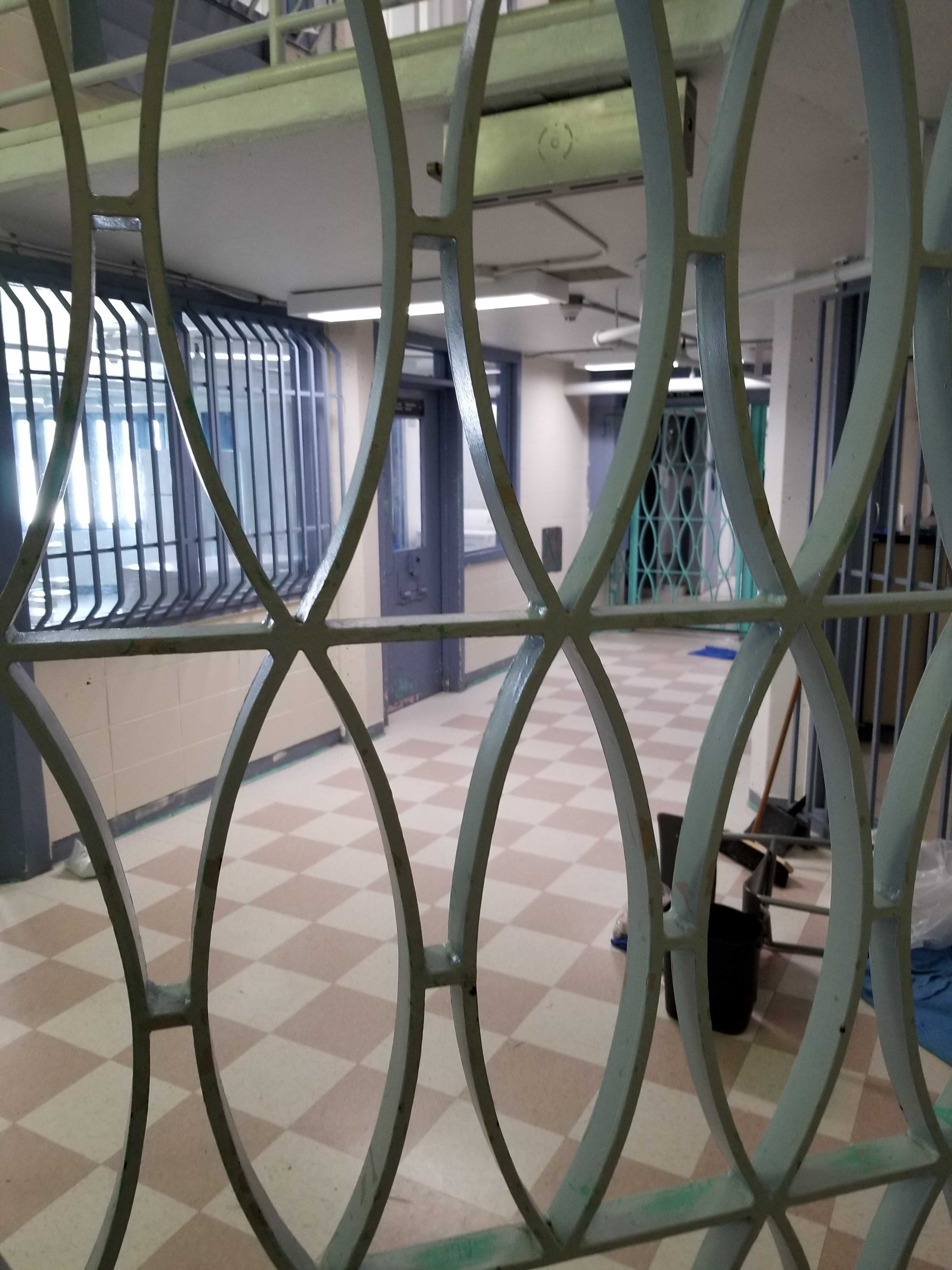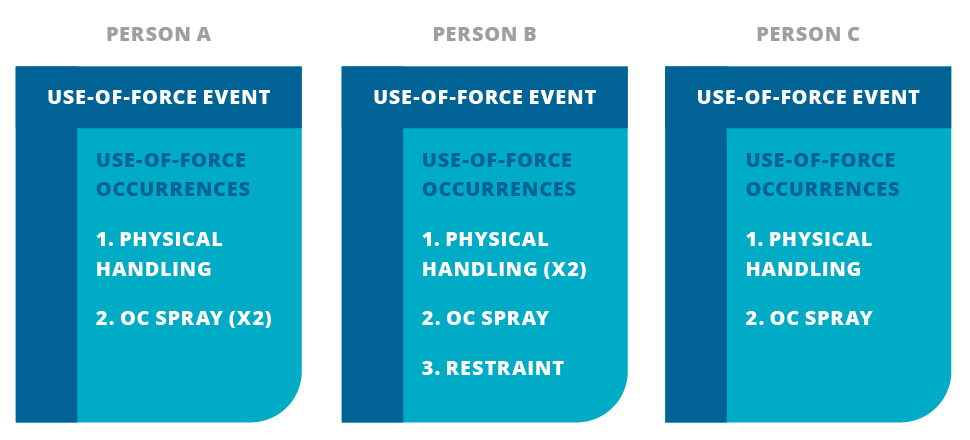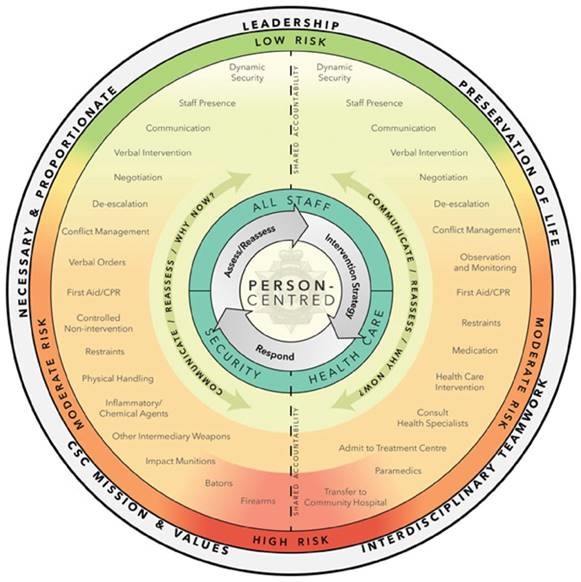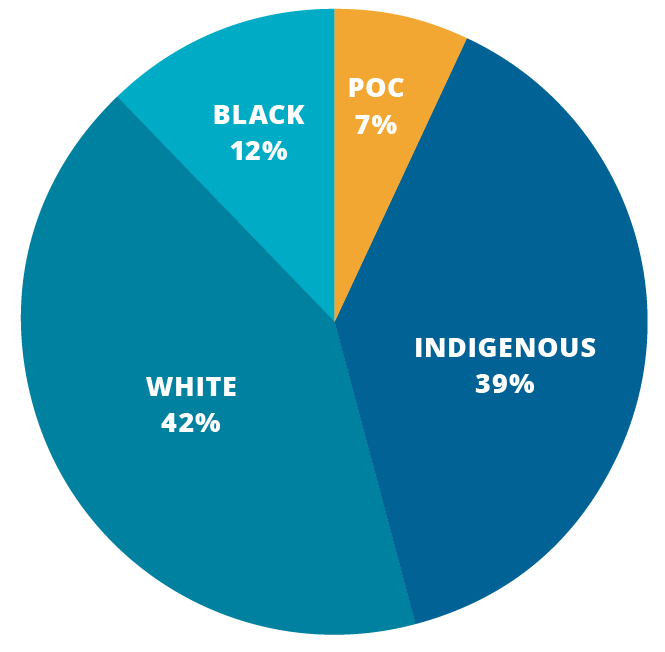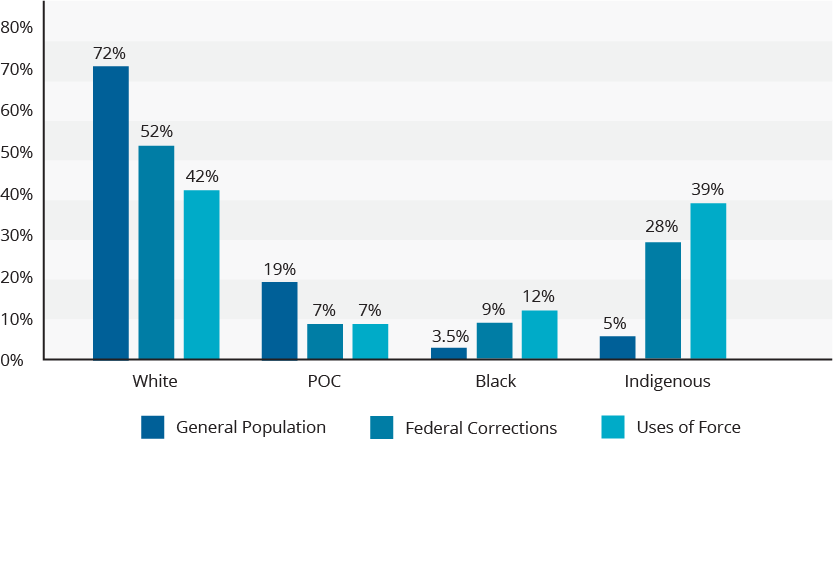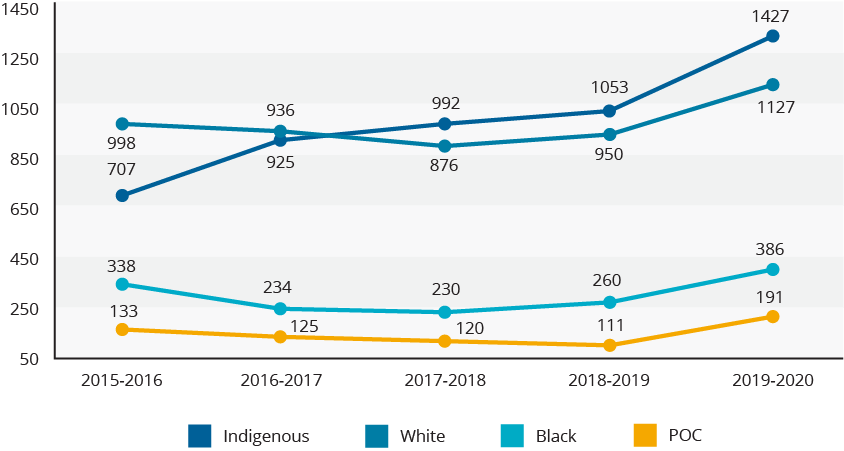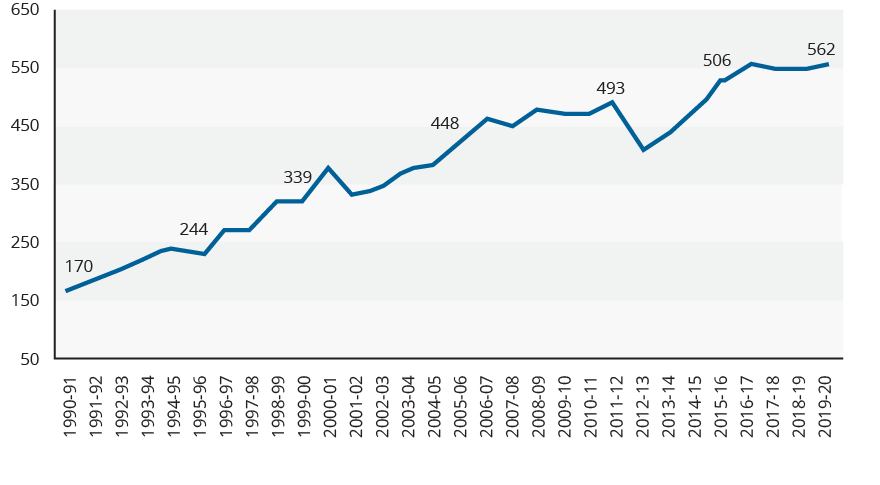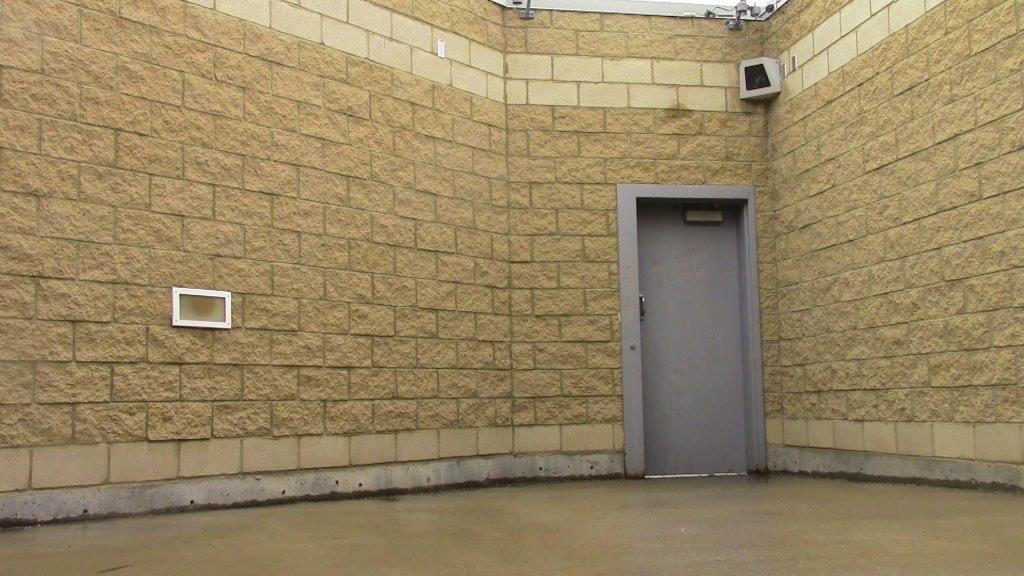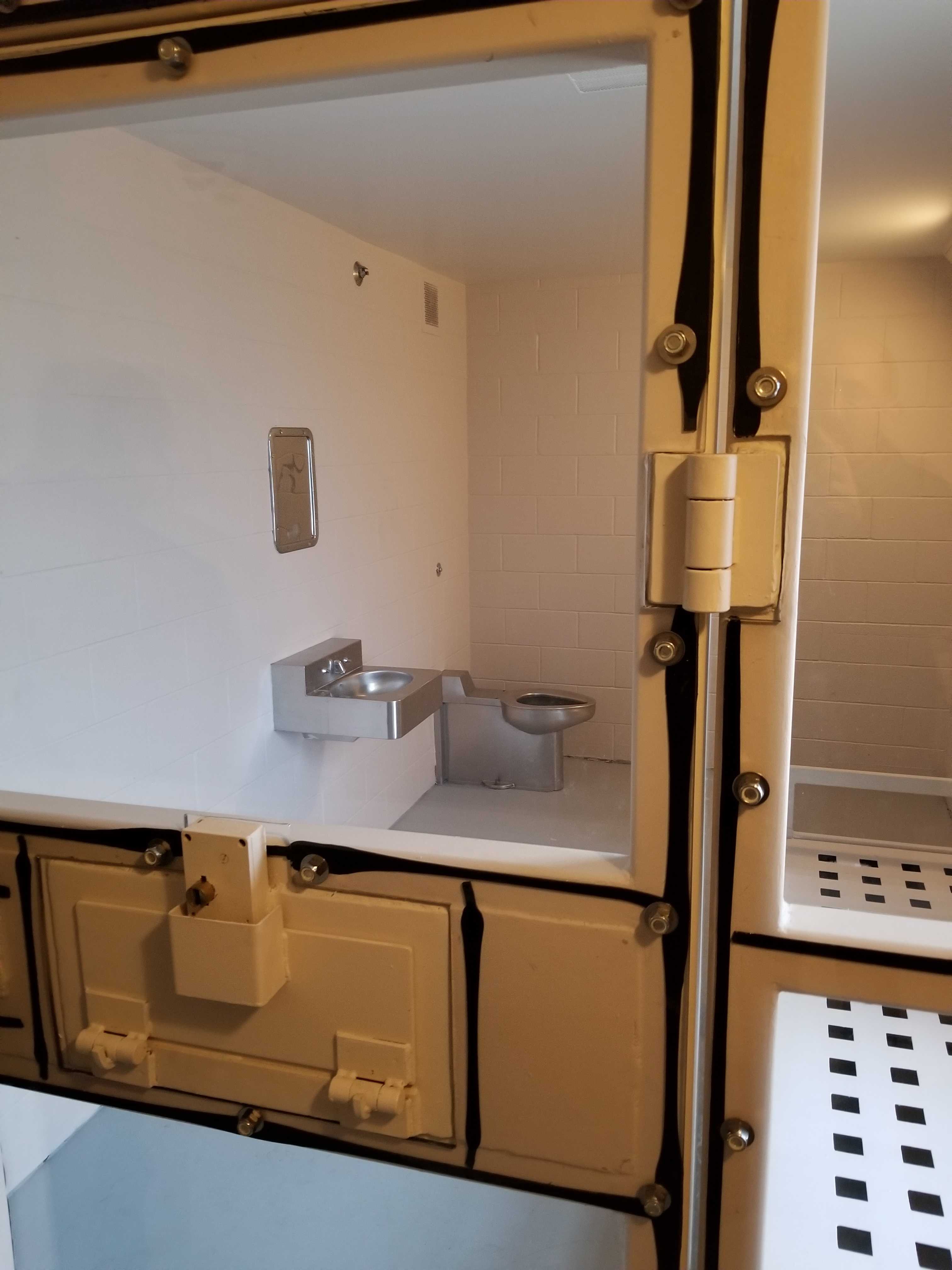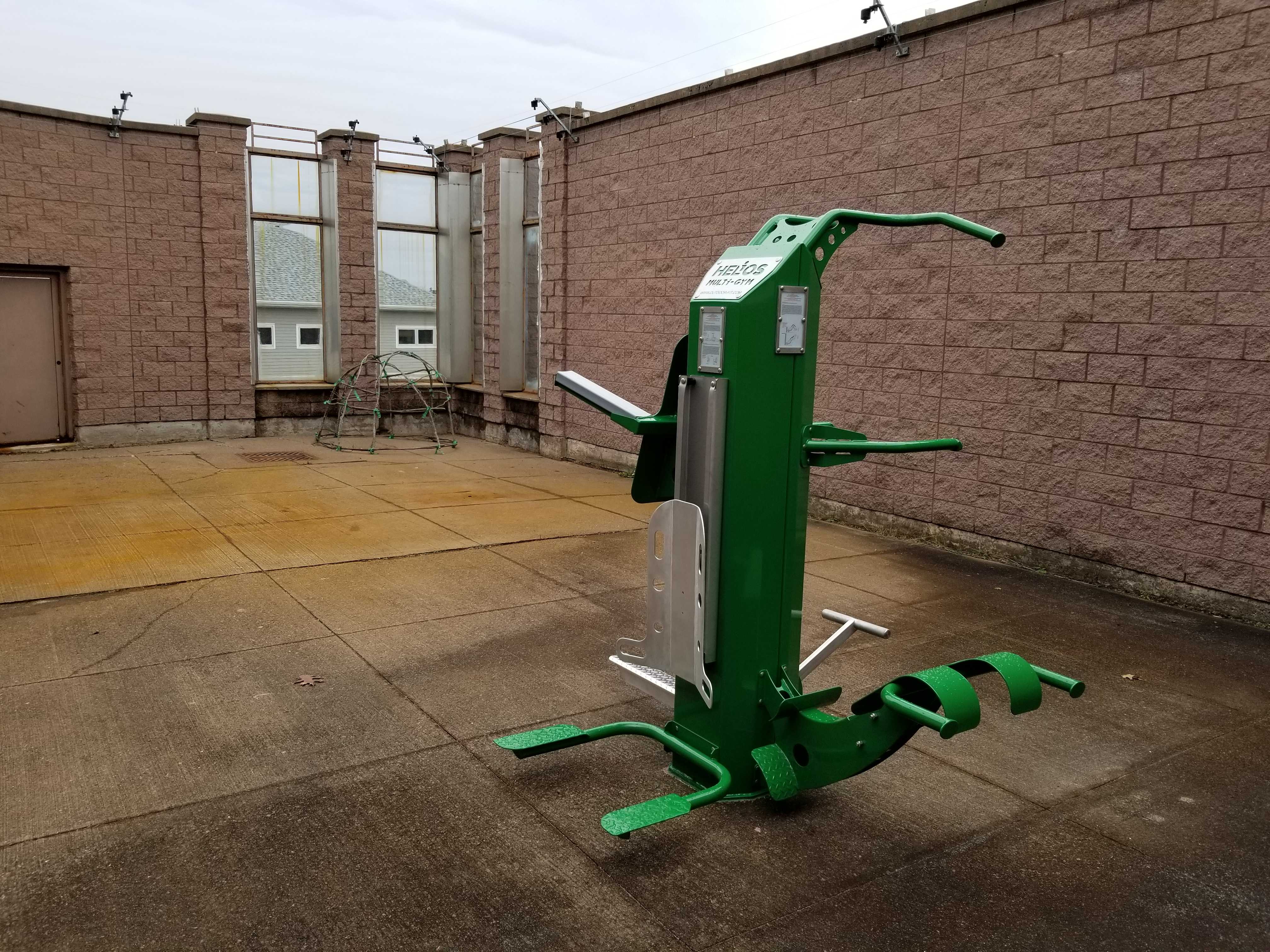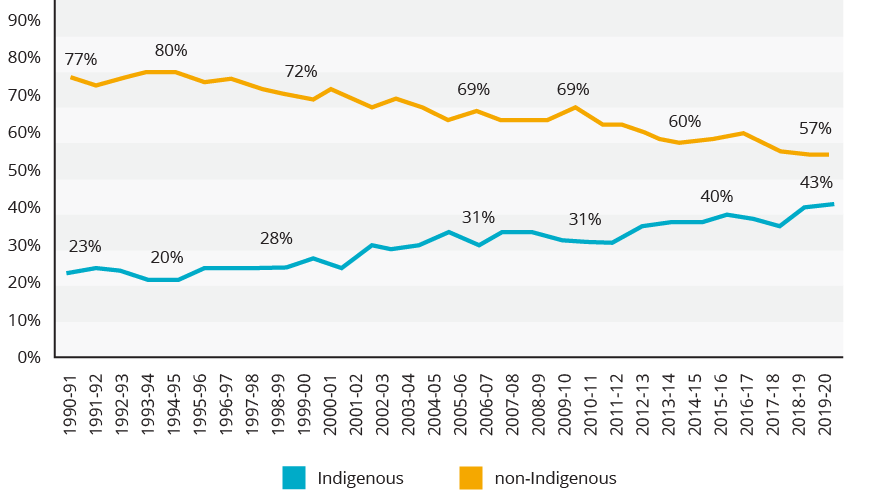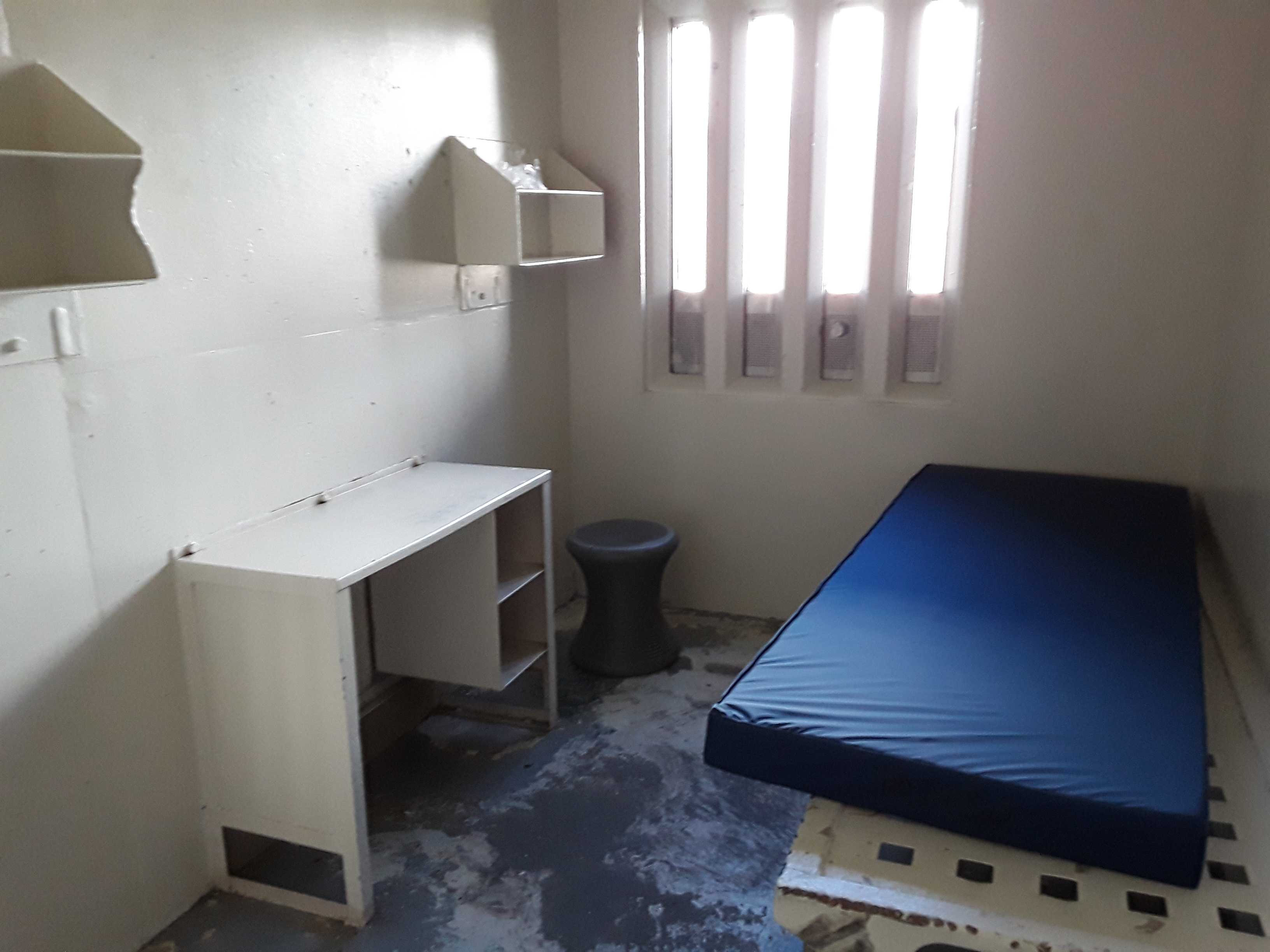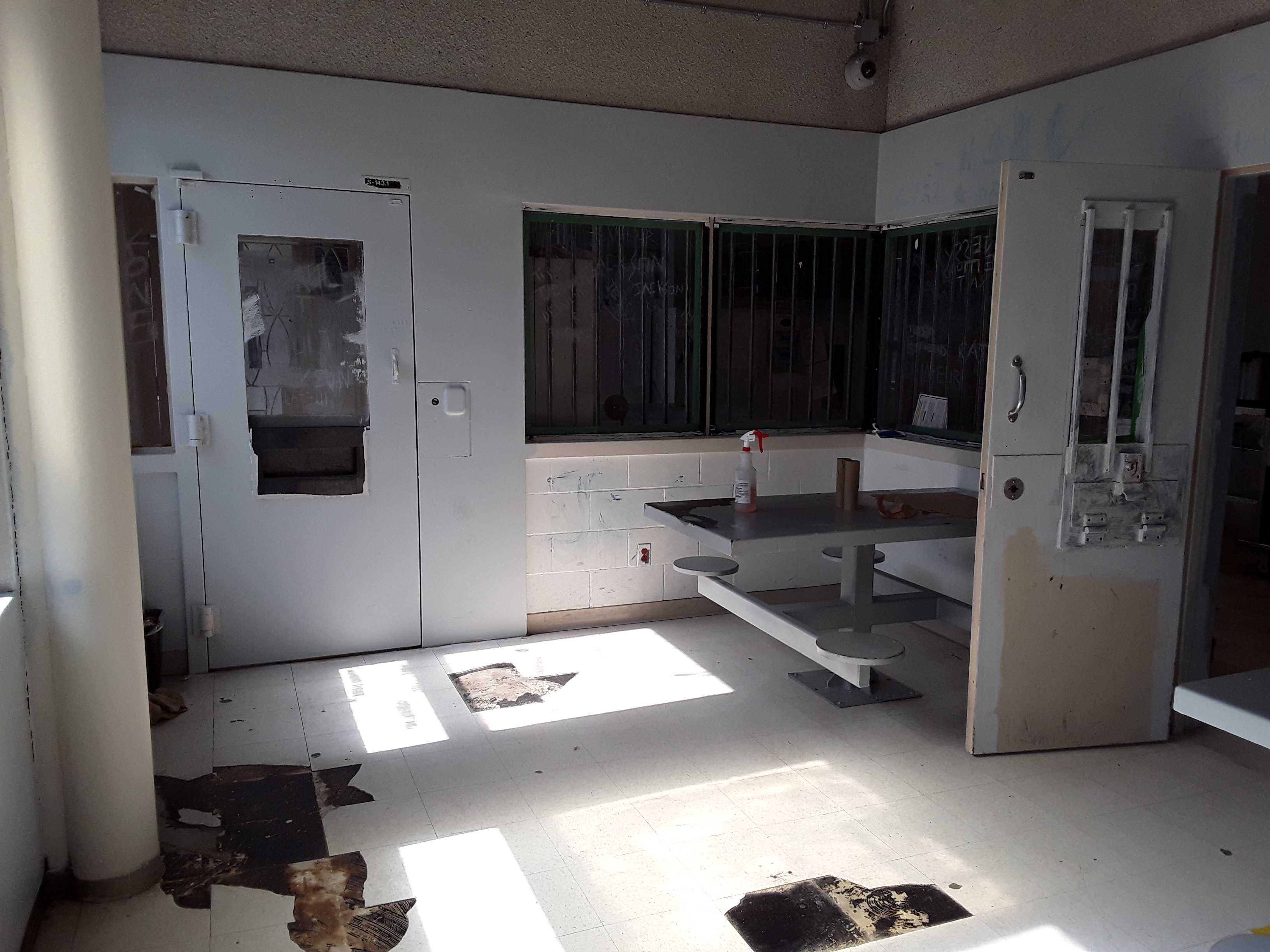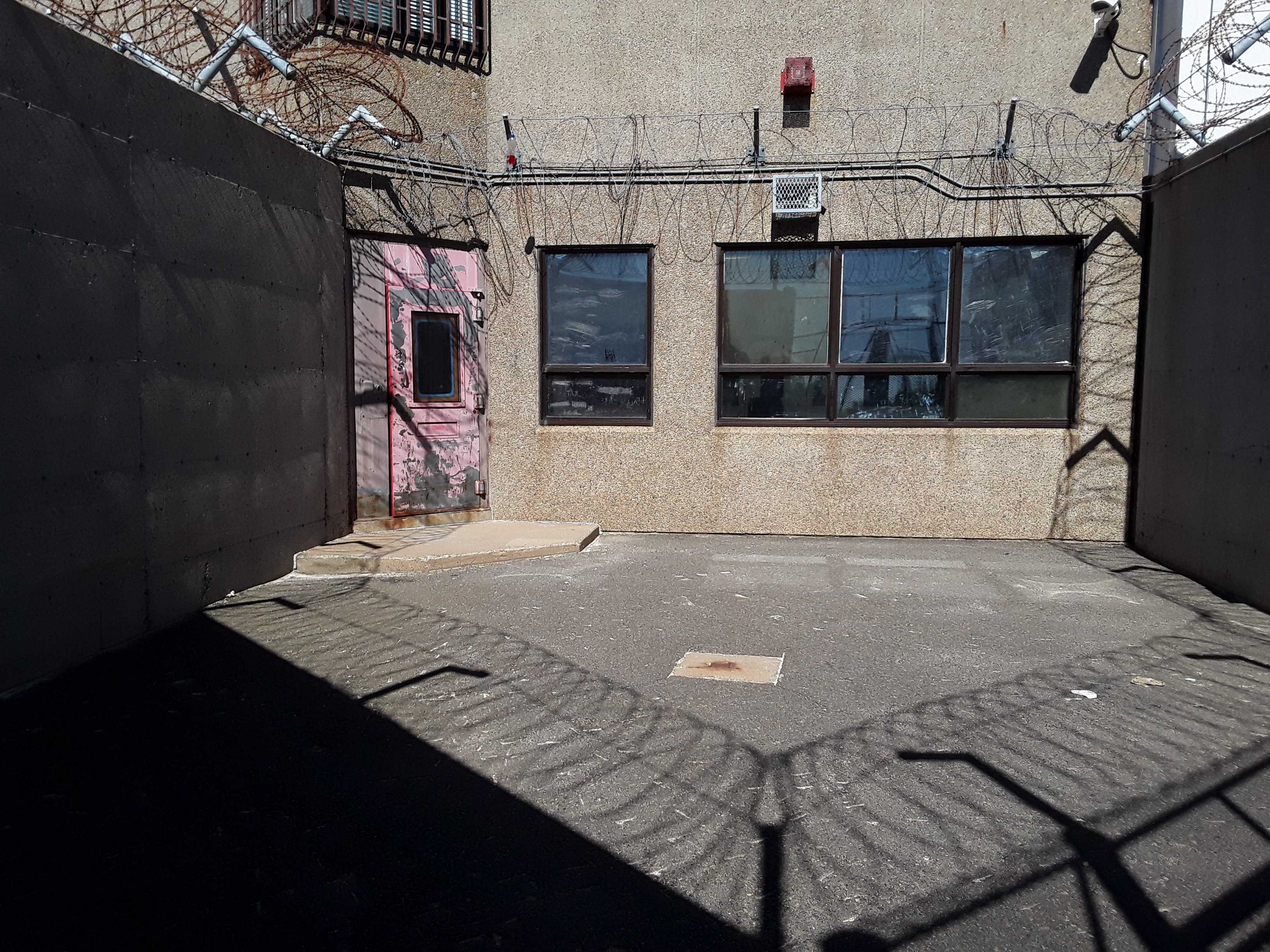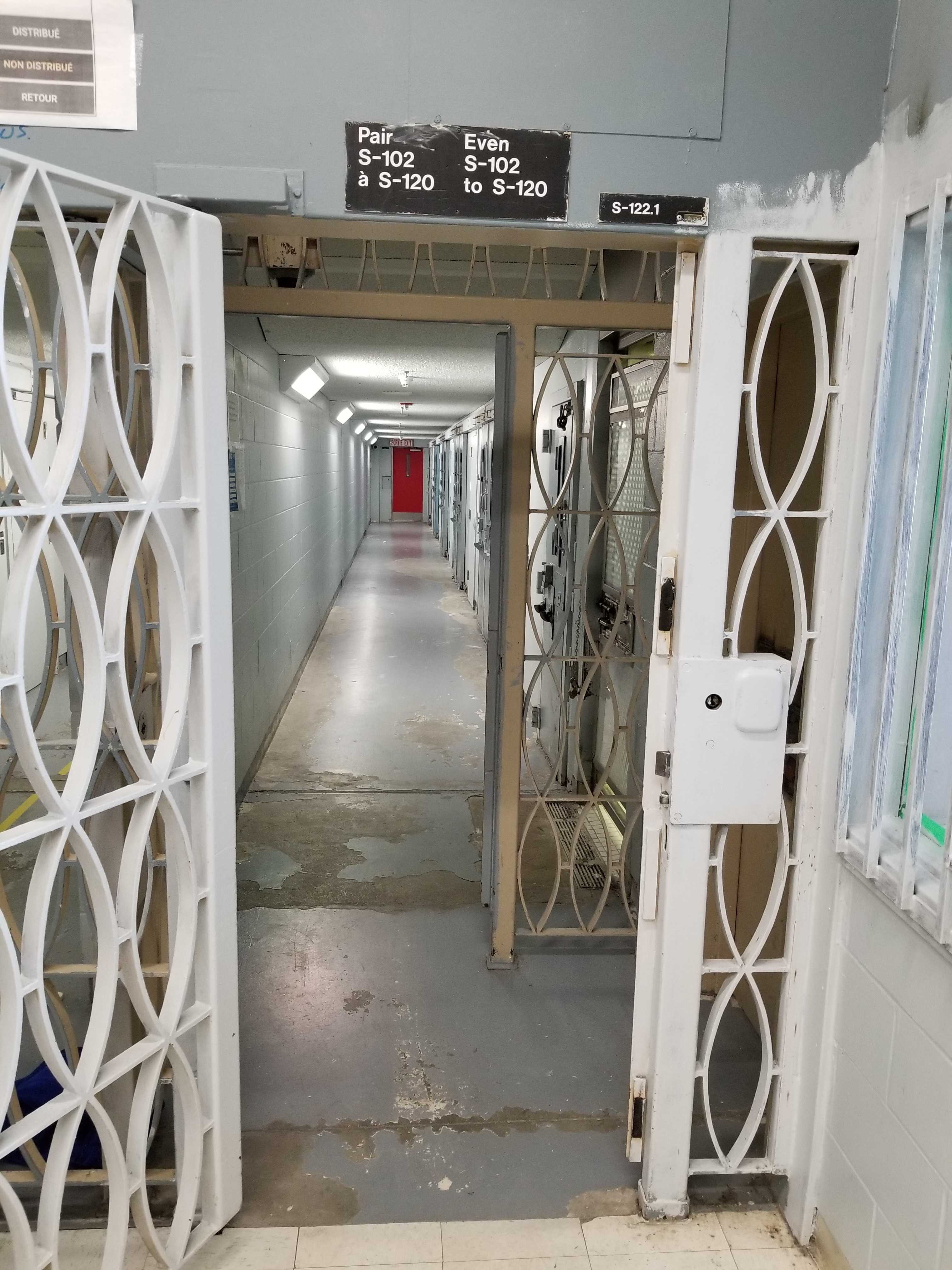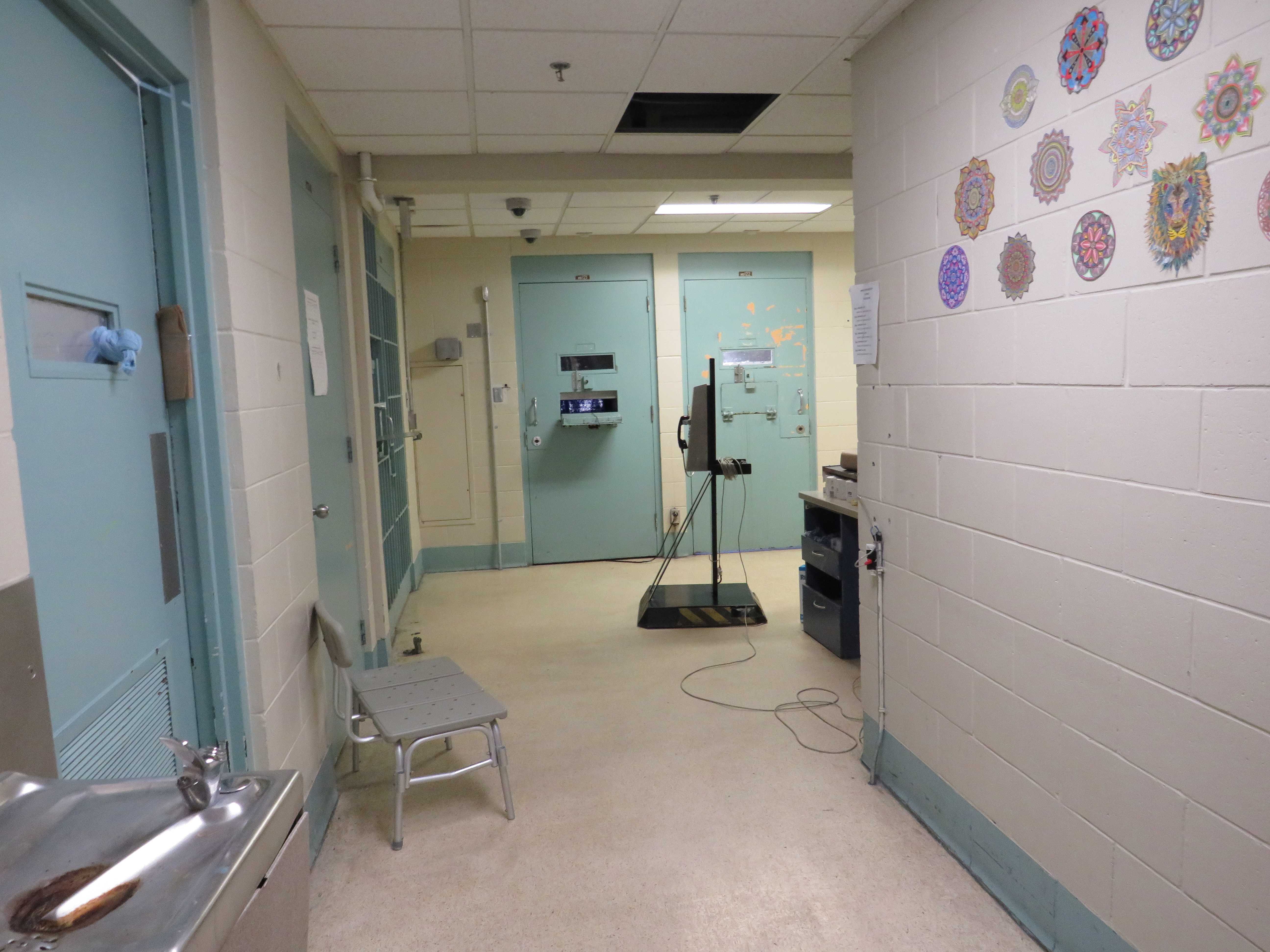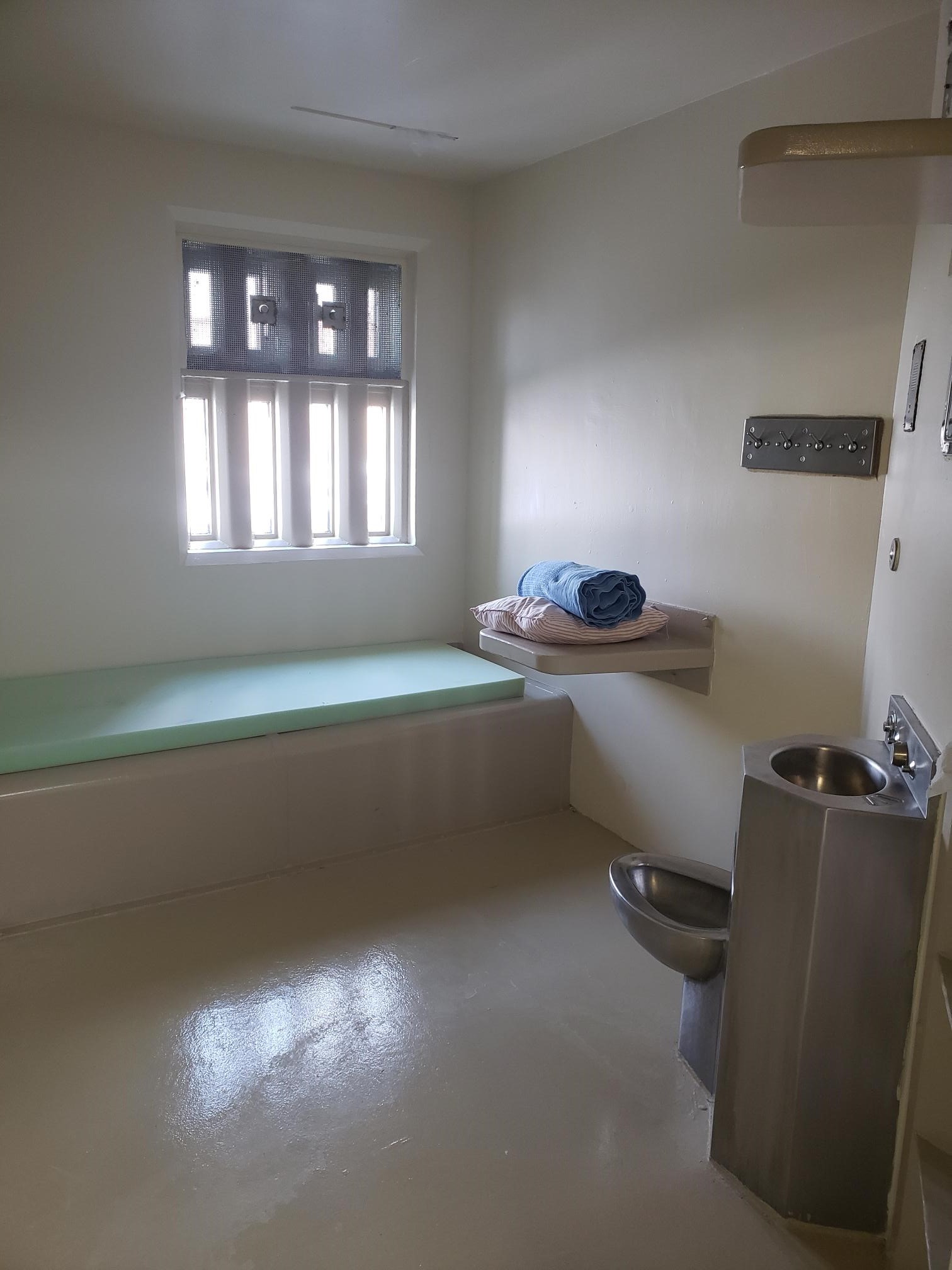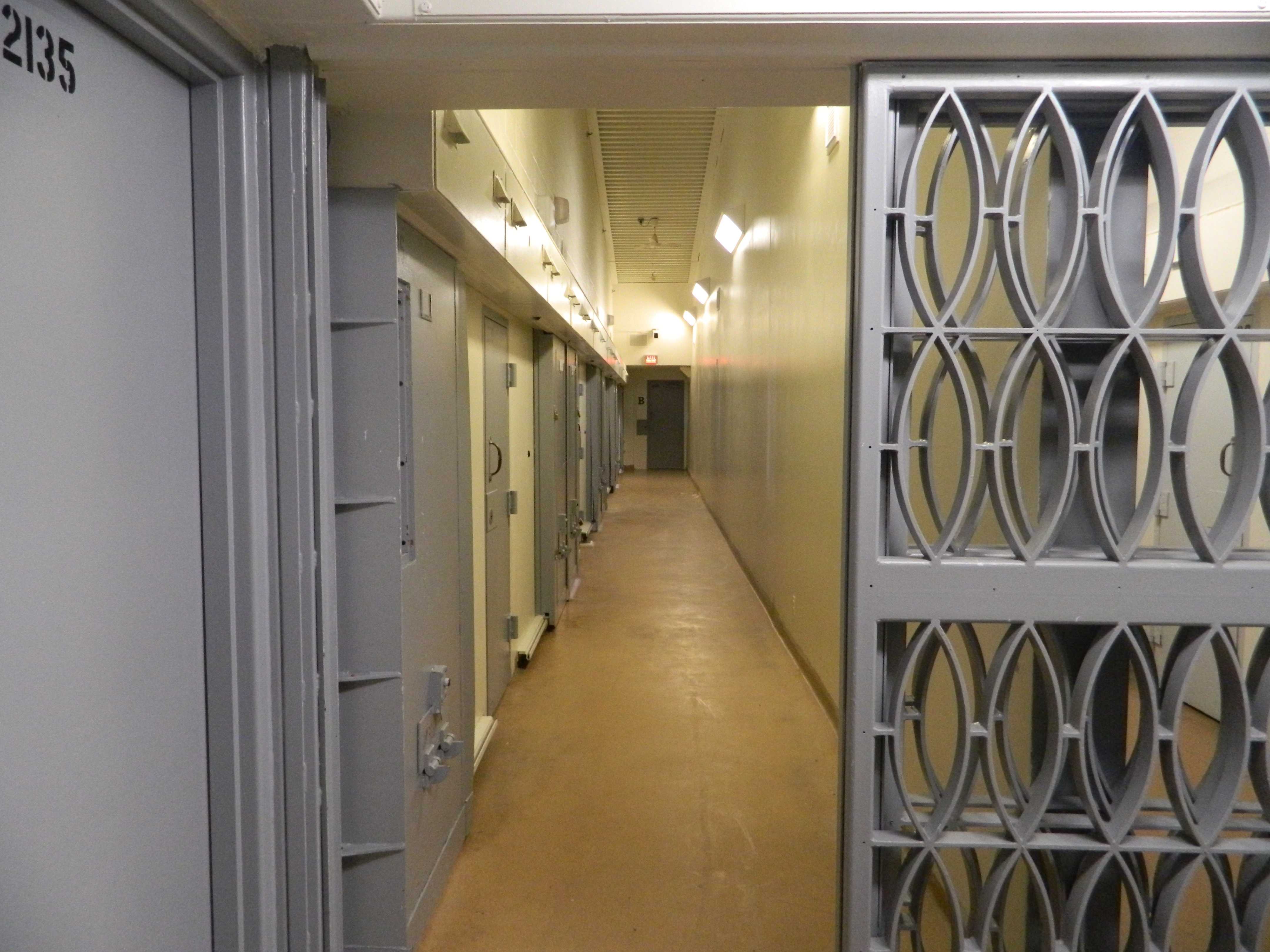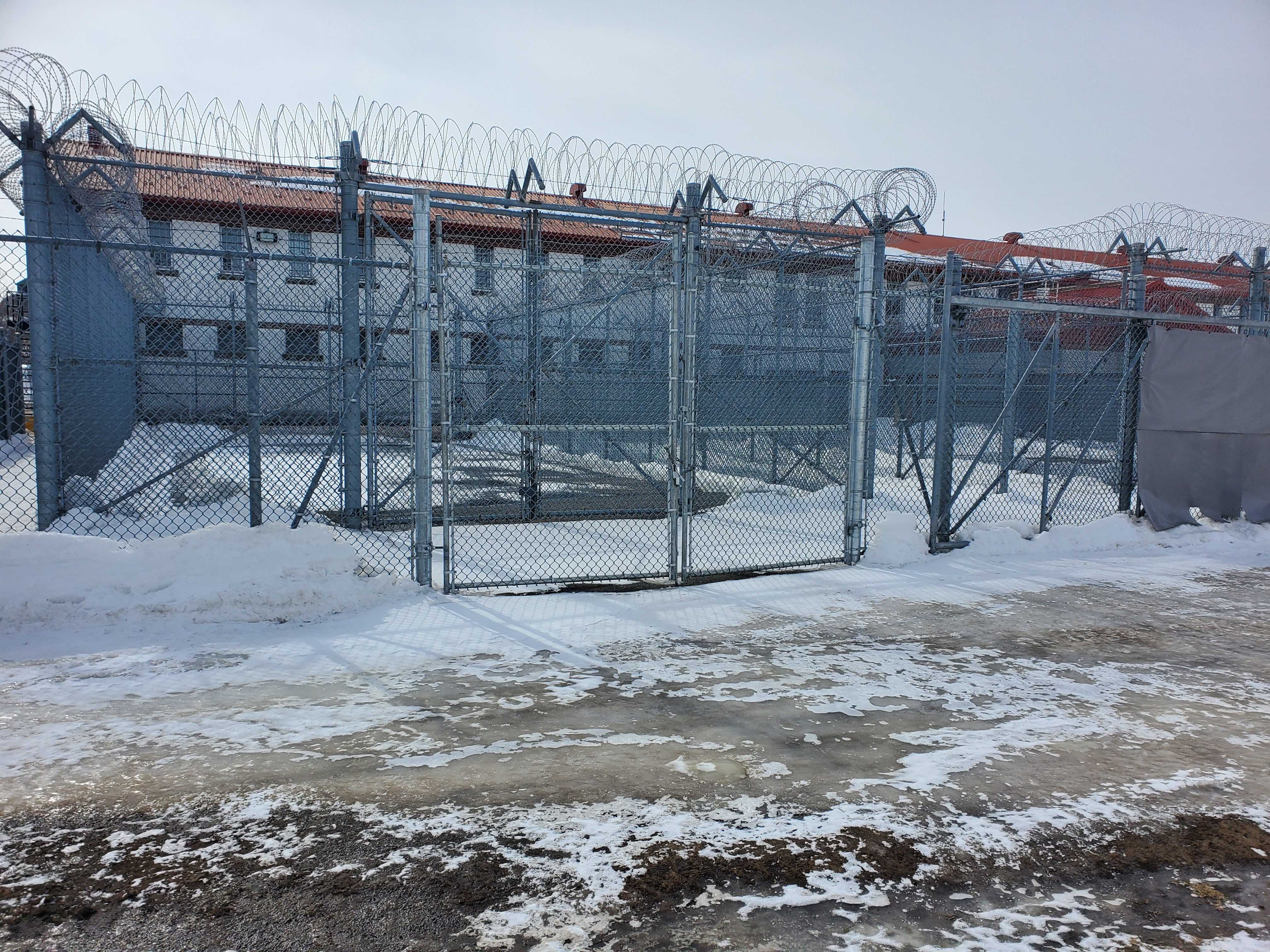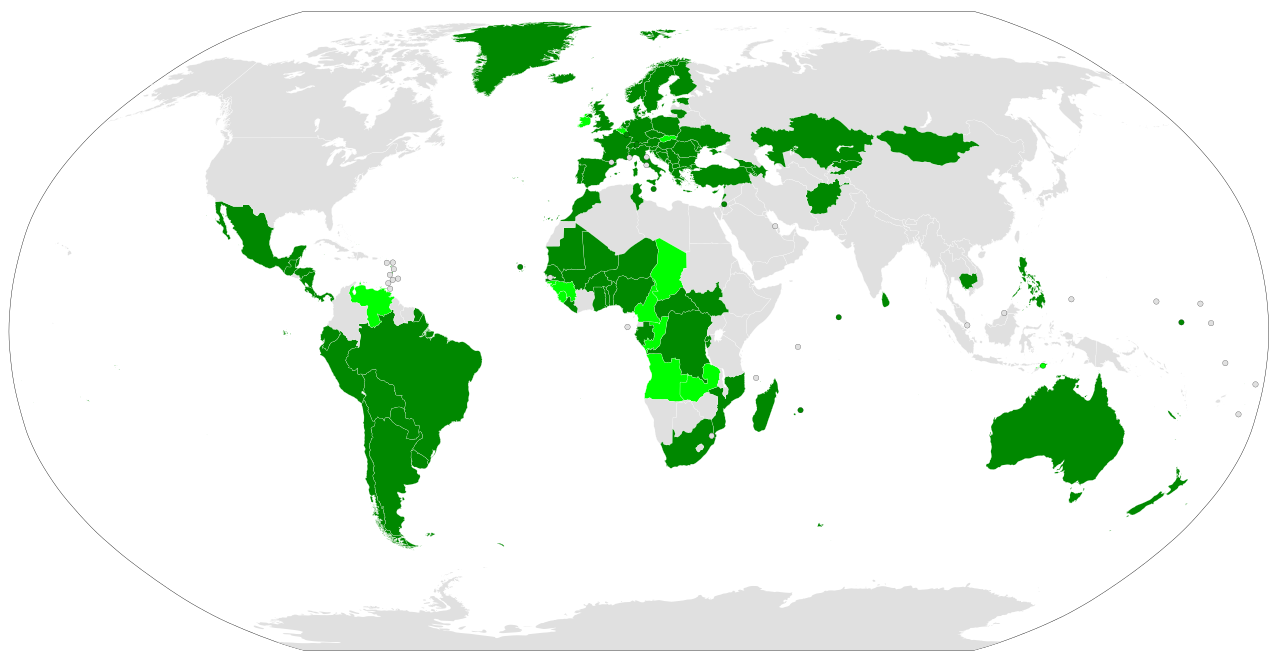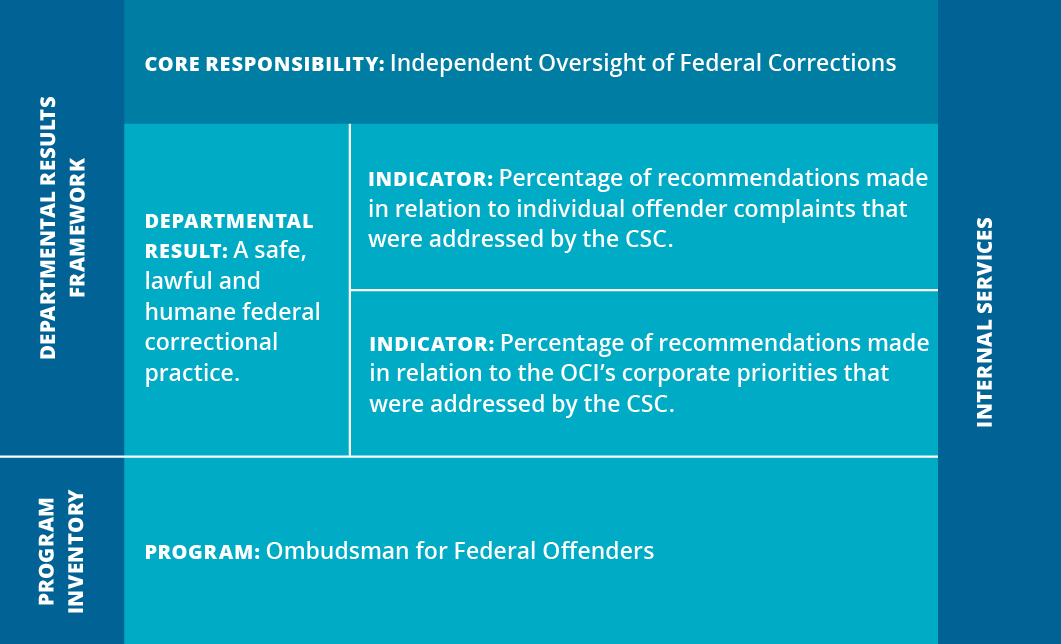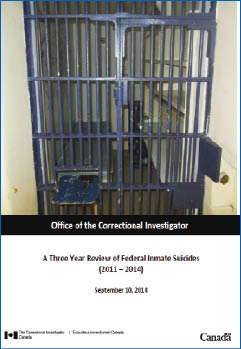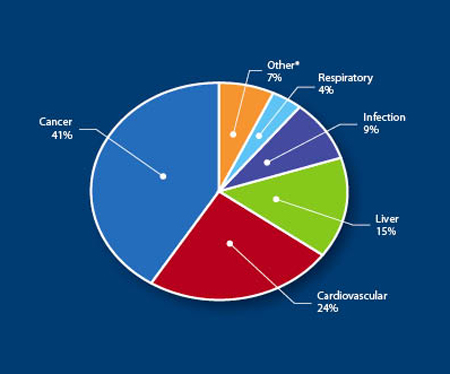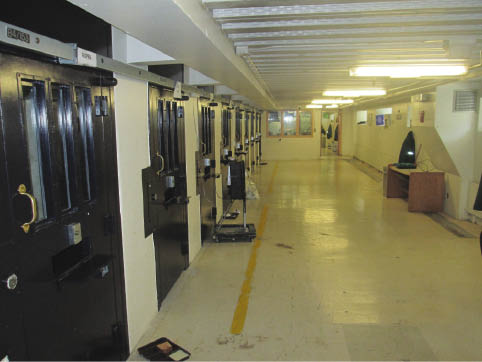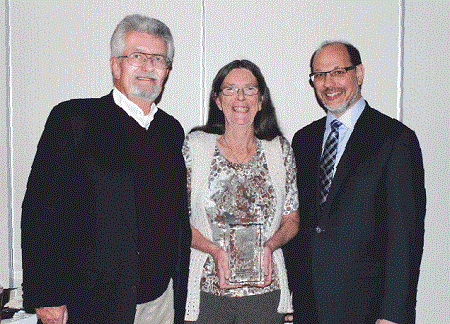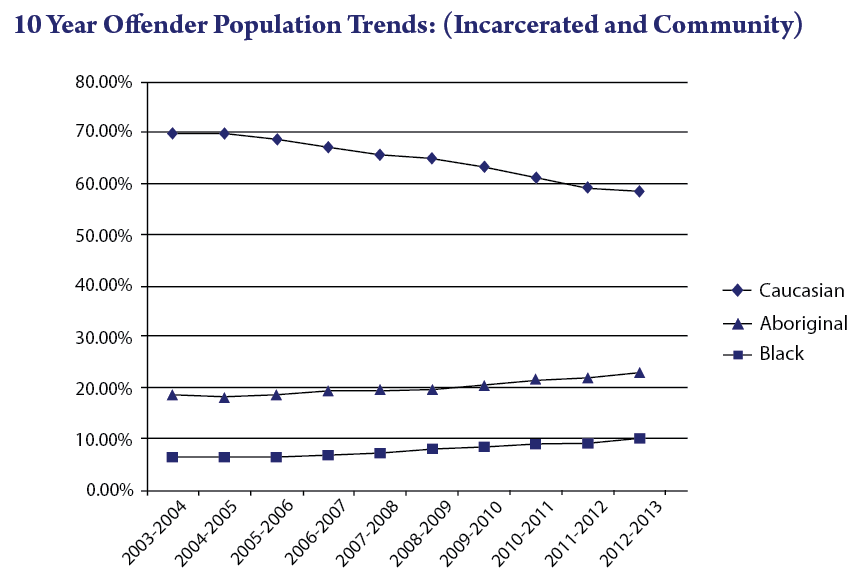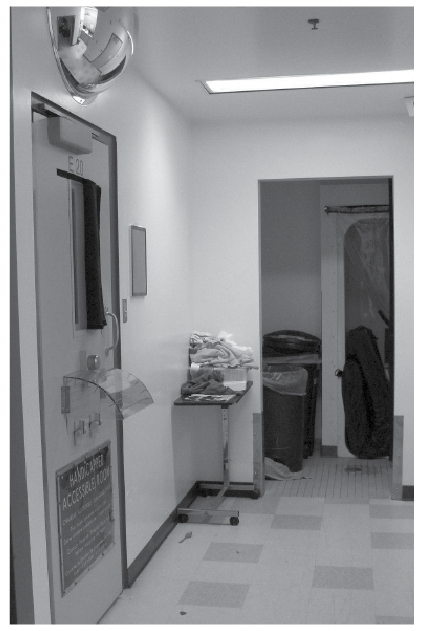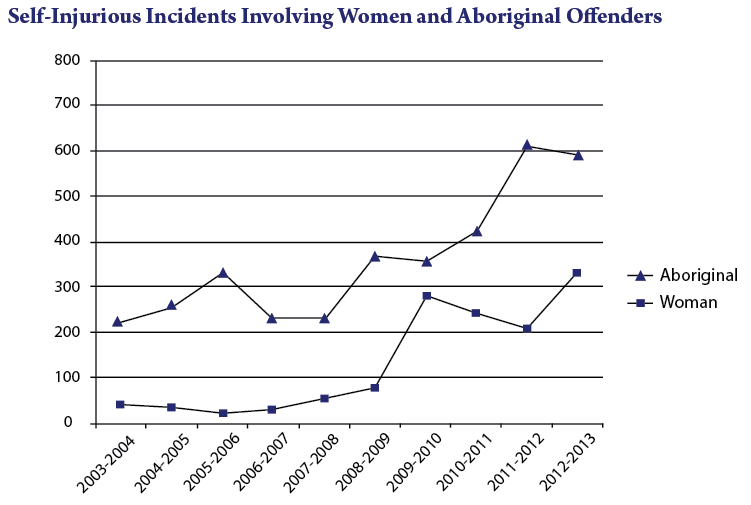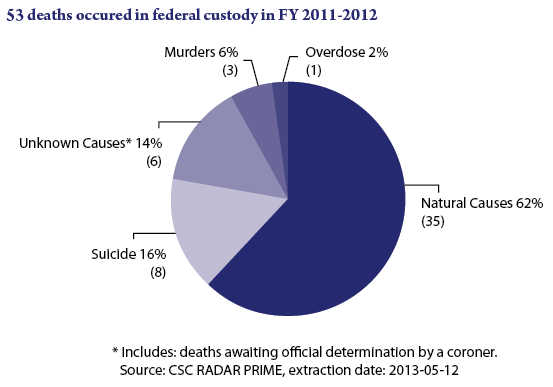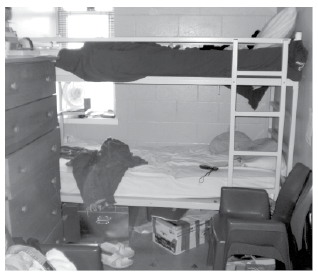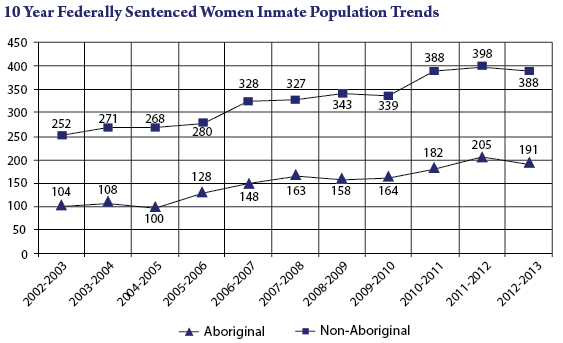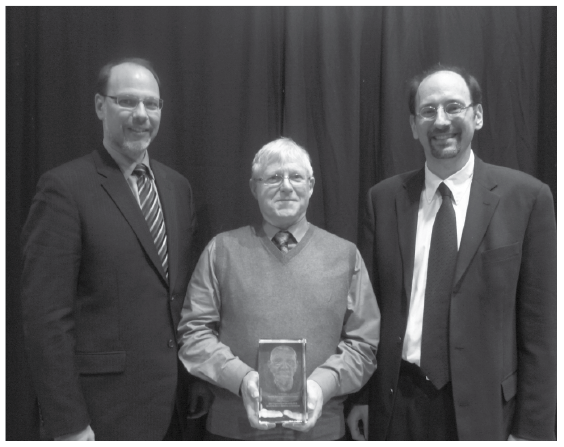Office of the Correctional Investigator Annual Report 2021-2022
June 30, 2022
The Honourable Marco Mendicino
Minister of Public Safety
House of Commons
Ottawa, Ontario
Dear Minister,
In accordance with section 192 of the Corrections and Conditional Release Act, it is my privilege and duty to submit to you the 49th Annual Report of the Correctional Investigator.
Yours respectfully,
Ivan Zinger, J.D., Ph.D.
Correctional Investigator
Table of Contents
Correctional Investigators Message
National Updates and Significant Cases
2. Correctional Service of Canada’s Drug Strategy
4. Structured Intervention Units
5. Over-representation of Indigenous Women in Secure Units (Maximum Security)
National Level Investigations
1. Update on the Experiences of Black Persons in Canadian Federal Penitentiaries
2. Restrictive forms of Confinement in Federal Corrections (Male Maximum-Security Penitentiaries).
3. Ten Years since Spirit Matters : Indigenous Issues in Federal Corrections (Part I)
Correctional Investigator’s Outlook for 2022-23
Ed McIsaac Human Rights in Corrections Award
Annex A: Summary of Recommendations
Response to the 49th Annual Report of the Correctional Investigator
Correctional Investigator's Message

Dr. Ivan Zinger,
Correctional Investigator of Canada
It was no accident of history that my Office was created nearly 50 years ago, in 1973, amidst a series of seemingly uninterrupted prison riots, hostage takings, murders, mayhem and maladministration that nearly brought Canada’s Penitentiary Service, as it was then known, to its knees. The Commission of Inquiry set up to get to the bottom of this unprecedented period of revolt and unrest in Canada’s prison system recognized the value of providing federally sentenced people with an independent and external redress system for the airing and resolution of legitimate grievances. The first Correctional Investigator, Ms. Ingrid Hansen, took up her role in June 1973. Half a century later, my Office still provides a necessary outlet for the airing of individual and systemic prisoner complaints. My Office continues to carry out independent monitoring and oversight of Canada’s federal correctional system, conducting investigations, reporting findings and issuing recommendations with the hope of effecting lasting change and positive reform.
As an oversight body, my ability to influence, effect change or persuade an alternative course of action is tied to the quality, thoroughness, relevance, and integrity of the investigations that my Office conducts. In such matters, the Office’s influence relies on a mixture of discretionary and obligatory powers, simultaneously bounded and contingent on the issues identified and brought forward in public reporting. It is certainly within my responsibility to inform the Correctional Service of Canada (CSC) when I think that their boat is listing or possibly in danger of sinking, but it is not within my remit to build them a better or more leak-proof vessel. To the point of the matter, my ability to influence policy or practice within CSC incorporates those areas of systemic or individual concern that I raise in my Annual Reports, bring before Parliament, or choose to occasionally raise with the media.
It is true that, on occasion, I may vent my frustration in the media or express public dissatisfaction or disappointment with CSC and its proclivity to deflect, obstruct or defend itself against criticism. While my findings, particularly those of a systemic nature, are sometimes ignored or not acted upon by CSC, I am proud of the fact that the larger body of the Office’s work does not go unnoticed by many others, including academics, lawyers, media, Parliament, other interested Canadians and vested stakeholders. From national Commissions of Inquiry, like the Truth and Reconciliation Commission and the National Inquiry into Missing and Murdered Indigenous Women and Girls, to reports from Parliamentary Standing Committees, and in universities and courtrooms across the land, OCI recommendations and reports are frequently cited to inform, to teach, to instruct, and yes – from time to time – to litigate.
For very good reason, the statutory powers and authorities that protect and ensure my functional independence from CSC and the Minister of Public Safety also provide that I am not a compellable or competent witness in any legal proceedings. I cannot be subpoenaed to appear before a judge or be drawn into the courtroom to provide expert evidence or first-hand testimony. That said, the content and context of Office reporting are frequently used by the courts or counsel, often entered as background information or even evidence for consideration in both individual and class-action suits. Office reporting on the over-representation and disparate outcomes of Indigenous (Gladue factors and actuarial risk assessments) or Black persons (cultural assessments) in federal corrections, for example, is often taken under consideration during sentencing. The long and contorted legal battles and constitutional challenges to end solitary confinement in Canada relied on evidence, in part, documented in OCI findings over many, many years of reporting on this issue.
The vitality, relevance, and strength of the Office lies in its ability to provide witness, to document accurately, impartially and without fear of reprisal or dismissal. We can enter and inspect federal prisons unfettered and we can demand production of any document without delay or redaction. We endeavour to accurately report out on what really goes on behind those imposing walls. We speak truth to power. I am justifiably proud of the fact that our reporting is used to inform legislation and legislators alike. Office recommendations, reports and findings often make their way into Government criminal justice priorities, speeches from the throne, Ministerial or Commissioner Mandate letters. A recent reference in the Public Safety Minister’s mandate letter from the Prime Minister – that he “work to address systemic racism and the over-representation of Black and racialized Canadians and Indigenous Peoples in the justice system” – reflects on a Government priority that can be traced back to more than a decade of Office reporting. Moreover, our 2019-20 national investigation on sexual coercion and violence behind bars ( A Culture of Silence ) was also referenced in the Minister’s mandate letter in direction from the Prime Minister that he “consider how to ensure that federal correctional institutions are safe and humane environments, free from violence and sexual harassment, and promote rehabilitation and public safety.” Our reporting is often referenced by UN Special Rapporteurs – internationally recognized human rights experts who periodically report on prison conditions or the treatment of vulnerable groups behind bars. OCI citations can also be found in government reports to UN oversight bodies established to monitor Canada’s compliance with international human rights treaty obligations.
While I would, of course, like to see more acceptance of my recommendations and recognition of my oversight role within CSC, it is not from lack of trying. As an ombudsman, my powers are limited to making recommendations. I cannot compel the Service to accept my findings or implement my recommendations. CSC’s only legal obligation is to respond within a reasonable time frame to my recommendations. I have little control over the manner, method, content, veracity or commitment of CSC’s responses.
Truth be told, it can be frustrating to receive a CSC response that answers one of my reports or recommendations with “policy says this…” or “policy directs that…” In response to any given report, up to half of my recommendations may be answered with citations from CSC’s extensive catalogue of Commissioner’s Directives (CD). Within CSC, the ever-expanding collection of CDs has somehow attained the same status as the law, which it is supposed to provide meaning. My investigators are quite well versed in what policy does or does not instruct. The reason why we bring forward these matters in the first place is usually because we have found some non-compliance with the policy measure in practice, be it misinterpretation, misapplication, or sometimes, even a gap in policy. It is what my Office does: we monitor and ensure compliance with law and policy. An act of omission or finding of non-compliance cannot be saved by the fact that a Commissioner’s Directive already exists, can be cited word-for-word, or is actually intended to mean something else. To answer a finding of non-compliance with a policy citation is circular and dismissive of the matter in question. It is not a response.
It is said that advice is often ignored at one’s own peril. To extend this metaphor, it could be said that findings and recommendations reissued by my Office are dismissed, not acted upon or set aside at CSC’s peril. This year’s report incorporates a number of issues of national significance or concern that have been raised throughout the reporting period, often in correspondence, institutional visits, or bilateral meetings and exchanges with CSC at all levels within the organization. They are usually not new issues, but rather areas of unresolved, unaddressed or updated concern that remain under active investigation. In many cases, the same recommendations from previous reports are repeated verbatim or reissued with some new language. Some of these updates and their respective reporting histories included in this year’s report are:
- Prohibition on the use of dry cell placements beyond 72 hours (recommendation first made in the Office’s 2011-12 Annual Report, repeated in 2018-19, and reissued in 2021-22).
- A prison needle exchange program (PNEP) that, based on low participation rates, exists more in name than practice (initially reported in the Office’s 2018-19 Annual Report).
- Dysfunction at Edmonton Institution (successive Annual Reports).
- Over-representation of Indigenous women in maximum-security units (many Annual Reports, and a section 180 Report and Notice to the Minister in June 2018).
- Overly restrictive criteria that systematically restrict or discriminate against Indigenous women’s participation in the residential Mother-Child Program (first raised in the 2009-10 Annual Report).
- Lack of prisoner seatbelts in CSC’s escort vehicles (first raised in the Office’s 2016-17 Annual Report).
I could easily list more issues and their reporting histories above, but I think the point has been sufficiently made. Notwithstanding the fact that corrections fall within an area of public policy that is stubbornly resistant to reform and change, there are many reasons why, in the course of my work, it is often the case that I feel compelled to renew or update findings or reissue recommendations over and over again. For those still counting, it is why my predecessor and I have considered it necessary to repeat the recommendation for CSC to appoint a Deputy Commissioner for Indigenous Corrections more than ten separate times in more than twenty years of dogged reporting on this issue. It is also why so many of the themes and topics included in this year’s report are not new issues per se, but rather involve a different take on a matter of concern that reaches back years or even decades of Office reporting.
In any given year, there are, in fact, very few issues that could be considered new or that have never been reported by my Office. Medical Assistance in Dying (MAiD) was perhaps the last truly new issue in corrections that my Office has addressed, but even then MAiD was simply an extension of legislation to a largely forgotten class of incarcerated people who still remain deprived of deciding how, when and where they can choose to end their lives with respect and dignity. Other more “modern” issues and concerns in contemporary corrections – gender identity and expression, sexual coercion and violence behind bars, impact of COVID-19 measures and restrictions on prison populations, growing old(er) behind bars, over-representation of Black persons in use of force incidents – are “new” or interesting only insofar as reporting on these topics manage to reach the light of day.
I understand as well as anyone might that systemic change in corrections does not come easily or quickly. CSC and the Department of Public Safety are only now beginning to take measure and substantively address the prevalence of sexual coercion and violence behind bars. Five years after gender-based discrimination was added to the prohibited grounds of the Canadian Human Rights Act, a new standalone Commissioner’s Directive has just recently been promulgated. While these policy initiatives are responsive to Office reporting in these areas, there are any number of other issues where correctional policy and practice (for example, CSC’s zero-tolerance approach to drug use and possession behind bars) is considerably out of step with the times.
On this last point my reporting on promising harm reduction measures like a safe consumption site (Overdose Prevention Service) and needle exchange service behind bars being actively subverted by zero-tolerance security practises merely scratches the surface of the substantive reforms required. I point out that the last time CSC updated its National Drug Strategy was in 2007. Canadian policy on simple drug possession and consumption has moved dramatically since then, yet CSC culture remains mired in a prohibitive and repressive mindset. Maintaining a zero-tolerance approach to drugs that relies on ever more intrusive detection, disciplinary and repressive measures – strip-searches, body cavity scanning, cell searches, charges, urinalysis testing – is a costly game of diminishing returns. If a person is so desperate, indebted or addicted enough to the point of concealing drugs in body cavities with potentially life-threatening consequences, then surely this level of desperation should point us to consider other less intrusive, evidence-based and compassionate approaches of addressing the harms of illicit drug use behind bars. Additional progress and clinical treatment are also urgently needed to reduce demand.
As I document later in this report, placing a prisoner in an austere cell with no plumbing, in a security gown, with no certainty of release for days on end to carry out a search for suspected contraband is inhumane, degrading and quite likely unlawful. The “war” on drugs behind bars can never be won using extreme measures like indefinite solitary confinement. It seems harmful and unhelpful to punish people for what are ultimately substance abuse and addictions issues. Absolute drug prohibition does not work in the community and it will not work in prison. An overhaul and renewal of CSC’s drug policy is desperately required if more promising and innovative harm reduction measures, like the Overdose Prevention Service at Drumheller Institution, have any hope of seeing the light of day beyond initial pilot implementation.
Even when transformative change comes to corrections, as it did most recently in the decades long legal battle to end the practice of solitary confinement in Canadian prisons, it is often elusive and difficult to sustain progress or momentum over time. The replacement of solitary confinement with a set of legal standards that mandates meaningful human contact behind bars and imposes statutory limits on how long a person can be held in depriving environments or circumstances, is a case in point. Outside of the Structured Intervention Units, all kinds of restrictive forms of confinement (defined as less than four hours out-of-cell time per day) remain a stubborn and substantive reality as my investigation of male standalone maximum-security facilities illustrates. The threshold for out-of-cell time, inclusive of meaningful contact with others, is now established in federal law, yet there remain many forms of confinement and circumstances where even these minimal requirements are not being met or respected.
This year’s report also includes an updated and substantively more involved documentation of the Black prisoner experience in Canada, an area that my Office first reported on in 2013. A decade later, major issues documented in that seminal report – discrimination, racism, labelling, stereotyping – remain relevant concerns that severely impact equality of outcomes for Black persons in federal prisons.
The first of a two-part investigation that updates the Office’s 2013 Special Report to Parliament, Spirit Matters: Aboriginal People and the Corrections and Conditional Release Act , tabled March 2013, is also featured. Few of the findings contained in this introductory, context-setting piece will come as a surprise to anyone familiar with the plight of over-representation or disparate outcomes for Indigenous people in federal custody.
The ability of my Office to effect change must also be understood and evaluated in the context of our, rather, successful ability to address complaints and issues at the site or individual levels in a timely manner. My team of investigators work diligently to establish positive rapport with staff and prisoners alike at the institutions to which they are assigned. Relations between my investigative staff, CSC staff, and management at penitentiaries across Canada are uniformly productive, professional, cordial and responsive. OCI staff work tirelessly, often without much recognition, to resolve issues informally and at the lowest levels possible. Our rate of positive redress and resolution of issues at the site or individual level of complaints is significantly better than the progress we make on systemic issues. Despite travel, prison closures, and visit restrictions imposed by the COVID-19 pandemic, this past year my team of investigators was still able to conduct more than 60 in-person or virtual visits to federal institutions.
I am immensely proud of the body of work reported here, all the more impressive given that it was completed during another year of COVID-related restrictions which required adapted working conditions.
Ivan Zinger, JD., Ph.D.
Correctional Investigator
June 2022
Executive Director’s Message
Although we were hopeful that the restrictions imposed by the pandemic would be lifted in the last year, our hopes were quickly dashed by COVID-19 variants causing more lockdowns, both inside and outside of federal correctional facilities. The evolving and uncertain situation has continued to cause much hardship not only for the people we serve behind bars, but for our employees as well.
Despite these challenges, the fact that we were still able to spend 83 days in institutions, comprising 46 visits, speaks volumes about the dedication and commitment of our employees. These visits were carried out in all the regions. Some institutions that required our attention were visited more than once: including the maximum-security institutions, notably Atlantic (2x), Edmonton (2x), Donnacona (2x), Port Cartier (2x), Millhaven (2x), and Kent (3x). Some women’s institutions were also visited more than once. The Correctional Investigator alone visited nine institutions, providing his expert assessment and advice on what he observed. I too had the opportunity to conduct introductory visits at eight institutions to see first hand the reality of life behind bars for both incarcerated individuals as well as for the CSC employees who work there. I value the cooperation and collaboration we receive from CSC staff and management. Many important issues are resolved at the institutional level between OCI and CSC employees.
Conducting in-person visits in and through the pandemic demonstrates our continued attention to the needs of the people we serve and our commitment to prison oversight. Our visits ranged from one-day inspections to open visits with full case loads of meeting incarcerated persons, hearing about and acting upon the issues and concerns they raise.
Our policy and research staff, as well as investigators, showed resilience in their efforts by performing multiple visits in a short period of time as restrictions were being lifted. Our early resolution officers have been there to answer thousands of calls and to triage the complaints we received. I want to also highlight the work of our Corporate Services colleagues, who staff and run the back office, and without whom we could not function. Not only do they deal with the increasing government reporting obligations and the disproportionate burden that micro agencies face, but they also helped guide us through COVID-19 restrictions and requirements to ensure the safety of our employees.
This past year has seen the organization move forward with the development of a Three Year Strategic Plan consisting of four key priorities:
- Creating an environment where the OCI is an employer of choice, ensuring a safe and respectful workplace where employees feel empowered and supported;
- Ensuring an organizational structure that is aligned with office priorities, is nimble and agile to respond to emerging issues;
- Improving systemic investigation and inspection capacity and effectiveness through enhanced planning and cooperation; and,
- Implementation of a Data Management strategy that meets the needs of the various functions within the office so as to allow the OCI to more effectively measure and report on the Office’s functions and positive impact.
I am fortunate to work with such a dedicated management team, a passionate and bold Correctional Investigator, and employees who genuinely care about the important mandate of our Office of ensuring safe and humane custody in Canada. Their hard work, passion for social justice, and professionalism continue to impress me. I look forward to begin implementation of our Strategic Plan in the coming year, with a hope that our work and our lives are less impacted by the restrictions of a pandemic, and that things return to normal a bit more.
Monette Maillet
Executive Director & General Counsel
Office of the Correctional Investigator of Canada
National Updates and Significant Cases
This section summarizes policy issues or significant individual cases raised at the institutional and national levels over the course of the reporting period. The issues and cases presented here were either the subject of discussions with institutional wardens, an exchange of correspondence, or an agenda item in bilateral meetings involving the Commissioner, myself, and our respective senior management teams. These areas of unresolved, unaddressed, or updated concern remain under active investigation. Therefore, this section serves to document progress in resolving issues of national significance or concern.
1. Dry Cells
As such, at this time, we do not have an absolute prohibition on placements exceeding 72 hours, as there have been incidents of offenders reinserting or swallowing foreign objects to avoid detection, which necessitates the continued placement beyond a 72-hour period. (CSC, response to 2011-12 Annual Report )
Dry cell placements exceeding 72 hours cannot be explicitly prohibited as it is more than feasible to delay bowel movement beyond 72 hours and, as documented in several medical literature, some individuals do not experience bowel movements more than once (168 hours) or twice (80 to 90 hours) a week. This is why the latest legislative changes do not impose a limit of time but rather imposes medical oversight. (CSC, response to 2019-20 Annual Report )
In a recent judicial ruling (November 2021, Adams v. Nova Institution ), the Supreme Court of Nova Scotia deemed the practice of using a dry cell for women suspected of concealing contraband in their vagina unlawful because they could be subjected to longer, or possibly even indefinite periods of dry cell detention. For context, “dry-celling” a prisoner is an extraordinary procedure requiring strip-searching, around the clock monitoring and observation, and 24/7 illumination of the cell. It is carried out under the expectation that the prisoner will eventually “expel” the suspected contraband. In this case, the court found that a former prisoner at Nova Institution for Women had been dry-celled for more than two consecutive weeks after she was suspected of concealing drugs in her vagina. On the 15th day of her dry cell confinement, a pelvic exam finally confirmed that she was not concealing any contraband in her body.
The court initially gave the government six months to review its policy in this area, a deadline that was subsequently extended and expires in July 2022. In response, in April 2022, the federal government gave notice of its intention to amend the Corrections and Conditional Release Act to prohibit the use of dry cells for women suspected of concealing contraband in their vagina.
CSC has also taken notice of the ruling, issuing an interim policy bulletin on April 25, 2022. The bulletin states: “Effective immediately, inmates believed to be carrying contraband in their vaginal cavity, or elsewhere other than their digestive tract, will not be placed in a dry cell.” It also directs that CSC’s National Headquarters (NHQ) are notified when a dry cell placement exceeds 72 hours. According to the interim instruction, this new requirement is intended to “enhance oversight” and allow NHQ, “to provide additional guidance where necessary.”
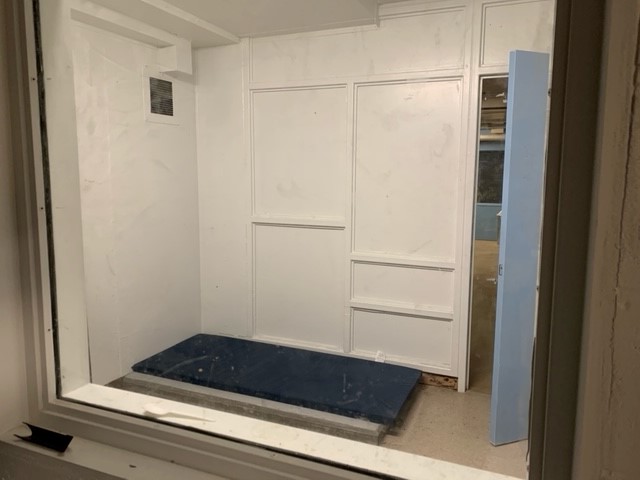
Warkworth Institution – Interior of a dry cell.
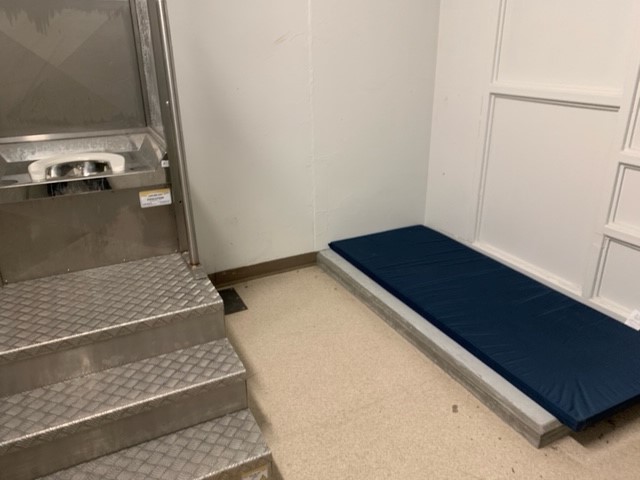
Warkworth Institution – Dry cell.
Based on the Government and CSC’s responses thus far, there does not seem to be any intention to go any further and place a wider ban or introduce additional restrictions on the controversial practice of dry-celling, a procedure which I have previously described as being “by far the most degrading, austere and restrictive imaginable in federal corrections.” The point of departure for this case and the ruling itself are based on a rather narrow set of arguments and facts. The Crown attempted to convince the court that the prisoner’s dry cell detention was, in fact, illegal , some kind of “isolated and localized (not systemic) incident of maladministration” on the institution’s part, and that, in any case, the definition of a “body cavity” search in federal corrections does not include concealment of contraband in a vagina. The judgment prohibits the use of dry cell placements for women prisoners suspected of carrying contraband in their vagina. It does not pronounce more widely than that. The more compelling public interest in the case of Adams v. Nova Institution involves whether keeping a prisoner in depriving and degrading conditions, for an indefinite duration, should be considered lawful, particularly in context of the recent abolishment of solitary confinement in Canadian prisons.
The Office first raised a set of concerns around dry cell practice in its 2011-12 Annual Report, a time when there were few safeguards and virtually no internal oversight of this practice. Since then, CSC has implemented various reporting and procedural safeguards – the requirement to give written notice for reasons of placement; an opportunity for incarcerated persons to retain and instruct legal counsel without delay; provision to give notice to and daily visits by Health Services; and, a daily review by the Warden of placements.
Notwithstanding, CSC has resisted placing any upper limit on how long a person can be held in a barren cell with no plumbing under continuous observation. While the circumstances depicted in the court’s judgment are “isolated and localized” (i.e., not systemic in nature), the practice of detaining a prisoner in a dry cell for an undefined period of time is far from unusual. In the reporting period, the Office intervened in the case of a young Indigenous woman who was dry-celled for nine consecutive days. In my opinion, there can be no further reason or justification to hold a person in such depriving conditions. As I have stated previously, I think this practice should be capped at 72 hours. After three days, it is my belief that this procedure is excessive and unreasonable, if not strictly punitive.
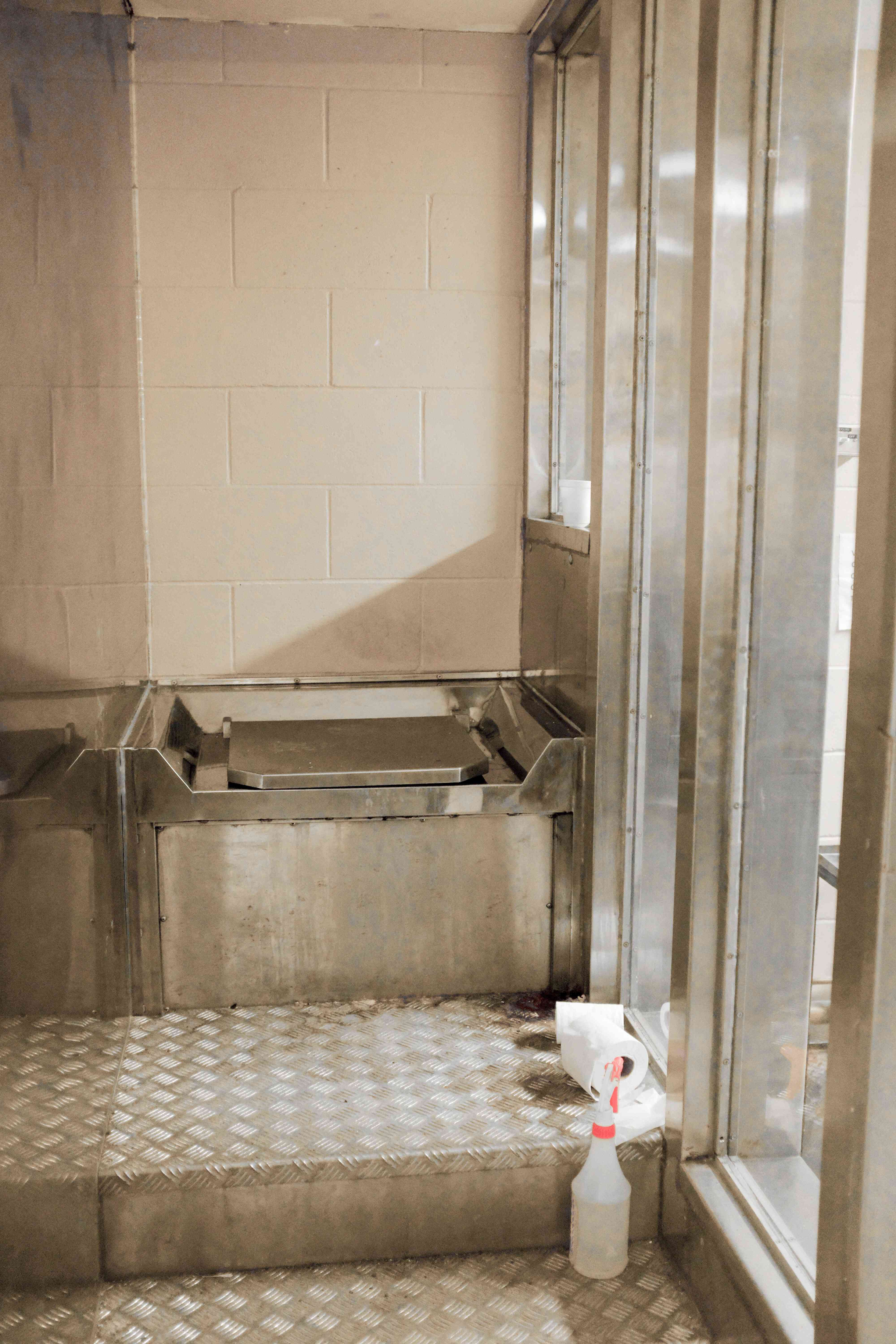
Drummond Institution – Inside a dry cell.
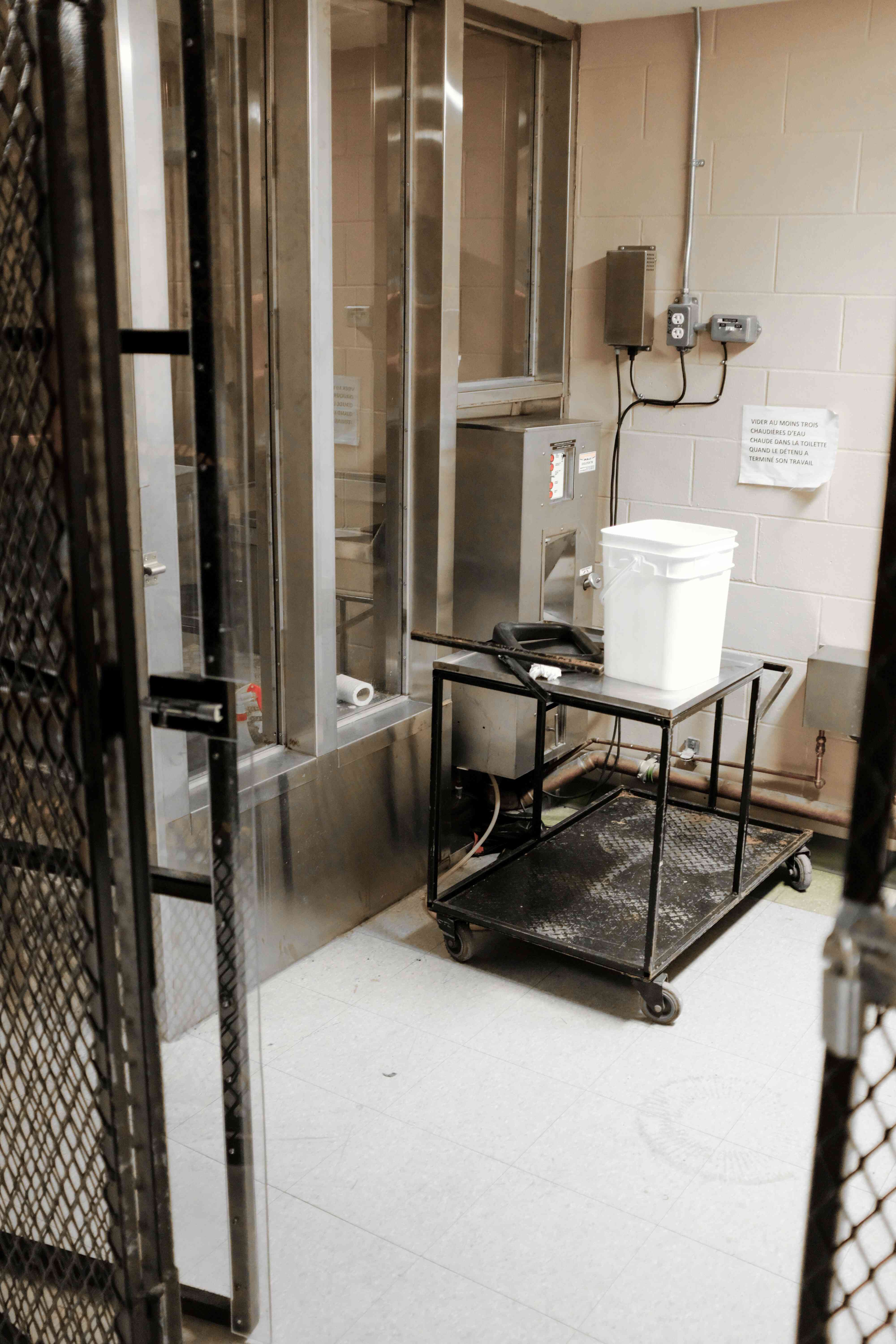
Drummond Institution – Outside the dry cell.
It is not known how often dry cells are used in federal prisons, as there is no obligation for the Service to report publicly on this practice. More than a decade after the Office first reported on this issue, there is still considerable variation in practice between and across regions and even within institutions with respect to the interpretation and procedures for dry-celling. The current record-keeping and reporting mechanisms that are in place (i.e., rationale for placement, record of seizures, observation reports, logbooks detailing periods of stay) are not consistent from one site to another. Incident and observation reports of dry cell placements are buried in individual preventive security files.
More significantly, there are little checks and balances in place to review or challenge the quality or validity of the information used to place or maintain an individual in a dry cell. Placements of this nature require “reasonable and probable grounds,” a legal threshold that cannot be satisfied on the basis of a hunch or individualized suspicion. Aside from voluntarily surrendering the contraband, the only certainty of release from a dry cell is a bowel movement, and only then, if there is some kind of contraband expelled and retrieved. Otherwise, as the Nova Scotia judgment illuminates, placements can extend indefinitely with little practical means to challenge, quash, or end what could potentially constitute cruel and unusual treatment or punishment. It was precisely the indefinite nature of administrative segregation (or solitary confinement), defined as two hours or less out of the cell, that led the present government to abolish that particular correctional practice. Arguably, dry-celling is an even more egregious form of detention, one that is virtually devoid of any kind of external review or oversight.
It is expected that dry cell placements are limited to what is reasonably required and for the shortest possible time. However, given data and record-keeping limitations, it is currently impossible to corroborate the actual number or duration of these placements. Furthermore, the requirement for Health Services to monitor dry cell placements is yet a further violation of its patient advocacy role – another “dual loyalty” problem that inappropriately obliges health services personnel to be involved in discipline and security matters.
Arguably, dry-celling is an even more egregious form of detention, one that is virtually devoid of any kind of external review or oversight.
For all of these reasons, I conclude that the additional internal review and notification measure that the Service has put in place to respond to the Supreme Court of Nova Scotia’s decision (requirement to report to NHQ on dry cell placements exceeding three days) is inadequate and insufficient. This measure does not rise nearly high enough to meet the life, liberty, and dignity concerns and interests at stake.
- I repeat my recommendation to prohibit any indefinite dry cell placement beyond 72 hours.
2. Correctional Service of Canada’s Drug Strategy
This update reviews select aspects of CSC’s drug policy. It assesses progress in addressing concerns and barriers to participation in the Prison Needle Exchange Program (PNEP), first raised in my 2018-19 Annual Report. It also documents the Office’s preliminary observations of a related harm reduction measure – the Overdose Prevention Service (OPS) – at Drumheller Institution, Alberta. It concludes with some comments on CSC’s zero-tolerance drug policy and calls for a more balanced, evidence-based and updated policy statement (Commissioner’s Directive 585 – National Drug Strategy ) to more comprehensively and compassionately address the harms of addictions and drug use among federal prisoners.
Prison Needle Exchange Program
In the Office’s 2018-19 Annual Report, I reported on the challenges and barriers in the initial implementation of CSC’s prison-based needle exchange program. At that time (as of April 2019), the program was just beginning to be implemented in a select number of institutions and there were only a handful of individuals enrolled. I made a number of preliminary findings and recommendations to address the surprisingly low number of participants in the program:
A zero-tolerance approach to prisoner drug use and possession conflicts with PNEP’s harm reduction principles and practice. Footnote 1
Use of a Threat Risk Assessment (TRA) as a precondition for PNEP participation turns potential participants away.
Access to needles/syringes are not determined by need (one-to-one needle/syringe exchange).
Lack of multiple access and distribution points (must return used needles to Health Services).
Lack of participants/patient confidentiality.
Active opposition among front-line staff.
Perceived involvement of the Parole Board of Canada.
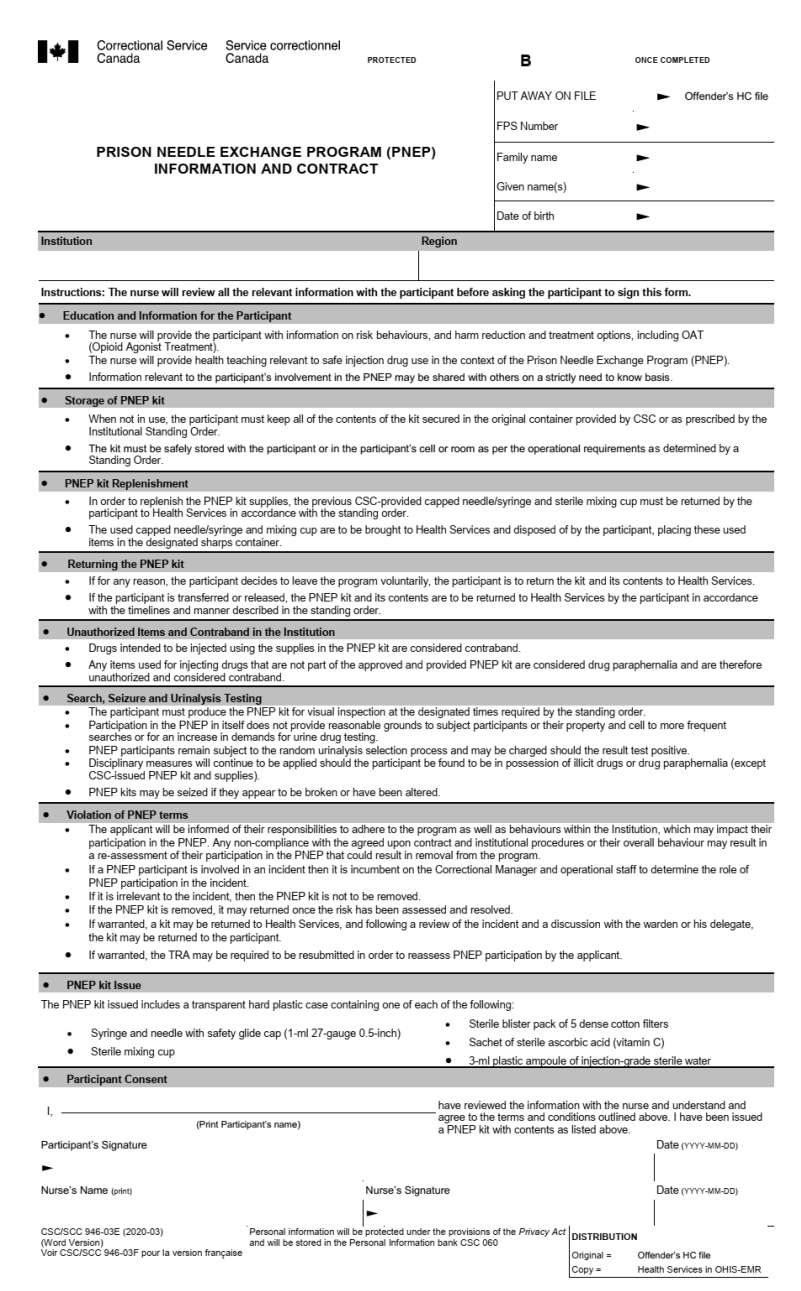
CSC’s Prison Needle Exchange Program (PNEP)
Information and Contract.
Except for the last barrier, all others remain active concerns. Today, the number of prisoners who have expressed an interest or are actually participating in the needle exchange program has not substantially increased, even factoring in the additional sites where PNEP has subsequently been implemented. Currently, a needle exchange service is operating at nine federal penitentiaries, including all five women’s sites. Based on a March 2022 snapshot, there were 46 individuals participating in the program, including seven federally sentenced women. A few sites have yet to attract even their first participant, while a few other institutions where the program had been implemented were shuttered at the onset of COVID. The planned phased national roll-out of the needle exchange program was also temporarily suspended, ostensibly by the pandemic.
An interim evaluation of PNEP conducted by an independent expert made similar findings as the Office. The Interim Evaluation Report, dated October 2020, included these observations and barriers to participation: Footnote 2
56% of institutions with a PNEP had no active participants at the time of the evaluation.
The majority of prisoners and some staff at some sites where PNEP existed did not know about the program.
Inconsistency and ambiguity in PNEP eligibility criteria, kit storage and removal procedures and other restrictions on access across sites.
Lack of adequate planning and preparation for implementation.
The PNEP Information and Program Contract (See image), that participants must agree to and sign, contains numerous behavioural expectations and restrictive criteria that could help further explain the lack of prisoner interest and uptake in the program. To date, the program has failed to generate much interest, trust, or confidence from either prisoners or front-line staff. It remains a program largely in name only.
In terms of potential “evidence-based actionable recommendations for program and policy redevelopment,” the interim evaluation offers several practical suggestions:
Reimagining and refreshing of PNEP promotional materials and a proactive approach to promoting and explaining the program to inmates on admission and to Correctional and Operational staff.
Development of a standardized policy document to ensure consistency in PNEP implementation and procedure across all federal prisons.
Widespread removal and communication of the requirement to share PNEP participation with the Parole Board of Canada.

Standard PNEP Kit.
Other related harm-reduction measures endorsed in the midterm PNEP evaluation include:
Increased access to Opioid Agonist Treatment behind bars.
Re-establishment of a Safer Tattooing Program in federal corrections.
Greater availability of Naloxone.
Increased access and distribution of safer snorting equipment.
It is obvious, from the external evaluator’s interim finding and recommendations, that CSC is being asked to embrace a more comprehensive set of harm reduction measures to drug use and addictions in federal corrections, a position which this Office has long endorsed. The problem, of course, is that CSC’s drug suppression practises do not adhere to or respect principles of harm reduction. The question remains: how do we get there amidst resistance and opposition within an organizational culture of zero tolerance? A possible way forward, with learning points that can be implemented, might be found in a related harm reduction program – the Overdose Prevention Service.
Overdose Prevention Service (OPS)
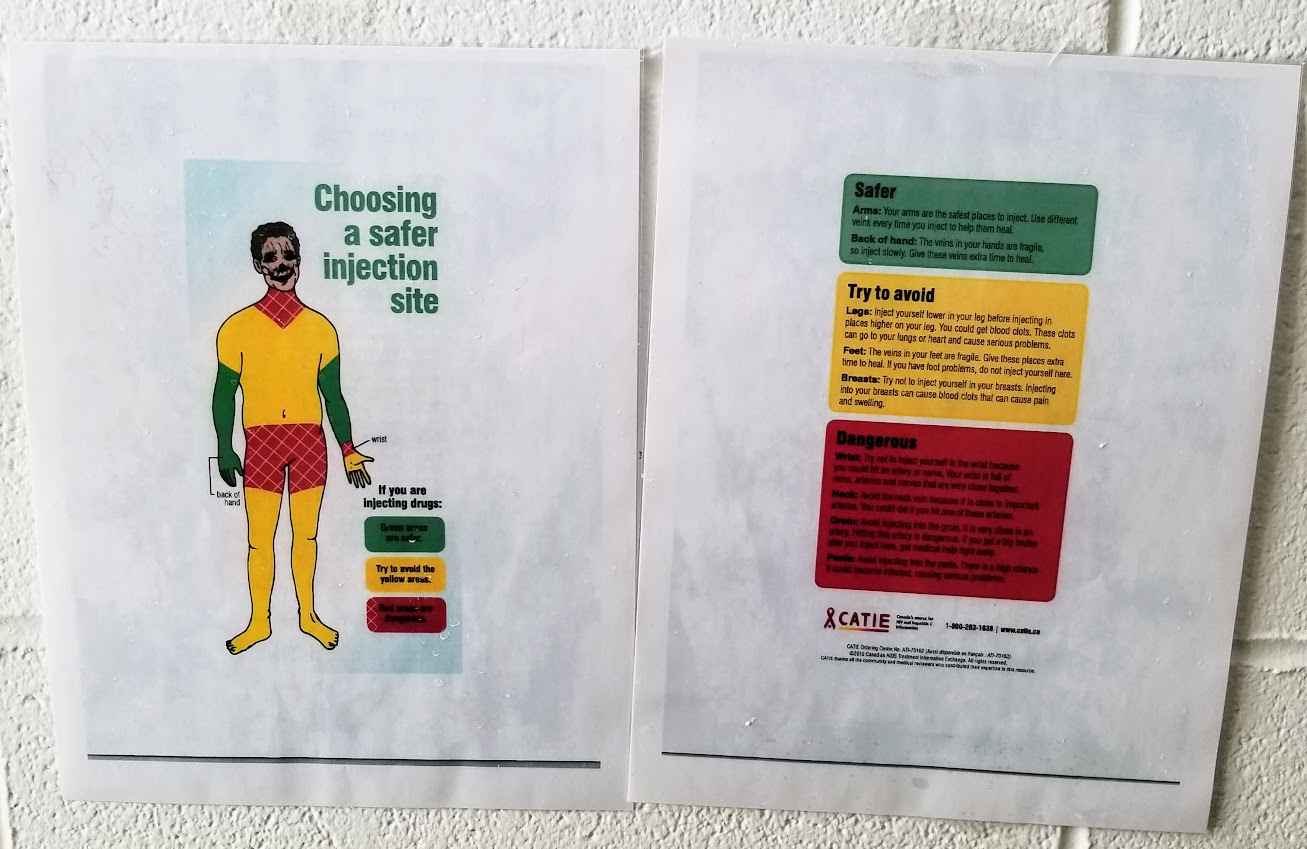
Drumheller Institution – Safe injection site information poster.
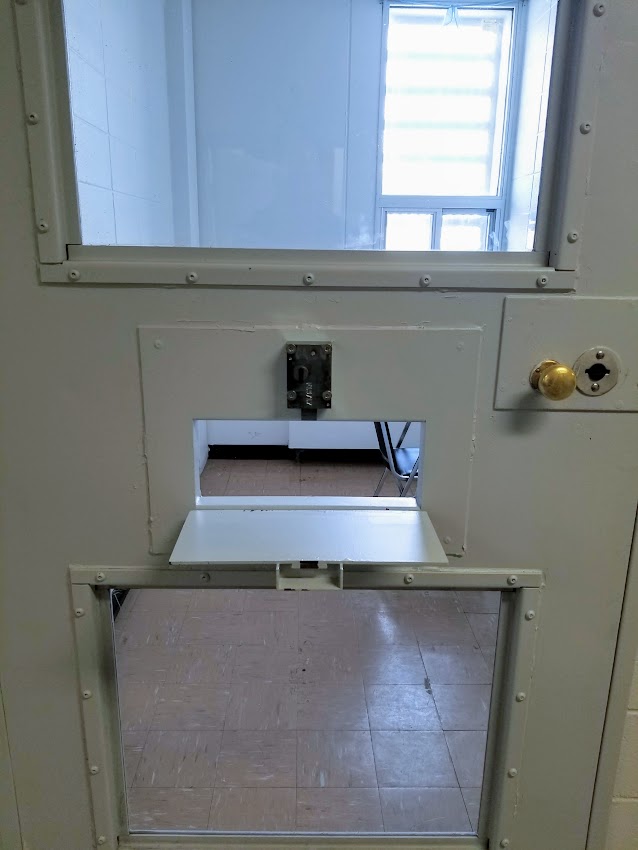
Drumheller Institution – Overdose prevention site.
The OPS, operated by Health Services, which is essentially a safe consumption site in a prison, has been running at Drumheller Institution in Alberta since June 2019. It appears to be the first prison in the world to offer such a service, in which prisoners can access needles, syringes, tourniquets and other sterile equipment and materials to self-administer and consume one dose of their substance per visit. Health care staff monitor prisoners using the OPS for the duration of their consumption and recovery periods. The site is open from 7:00 a.m. to 7:00 p.m. All equipment is to be returned to attending health care staff after use.
The established policy and practice goals of the OPS are to:
Prevent non-fatal overdoses and overdose deaths
Facilitate entry into drug treatment services
Reduce multi-use sharing of non-sterile needles
Increase opportunities to provide health promotion
Reduce transmission of blood-borne viral infections
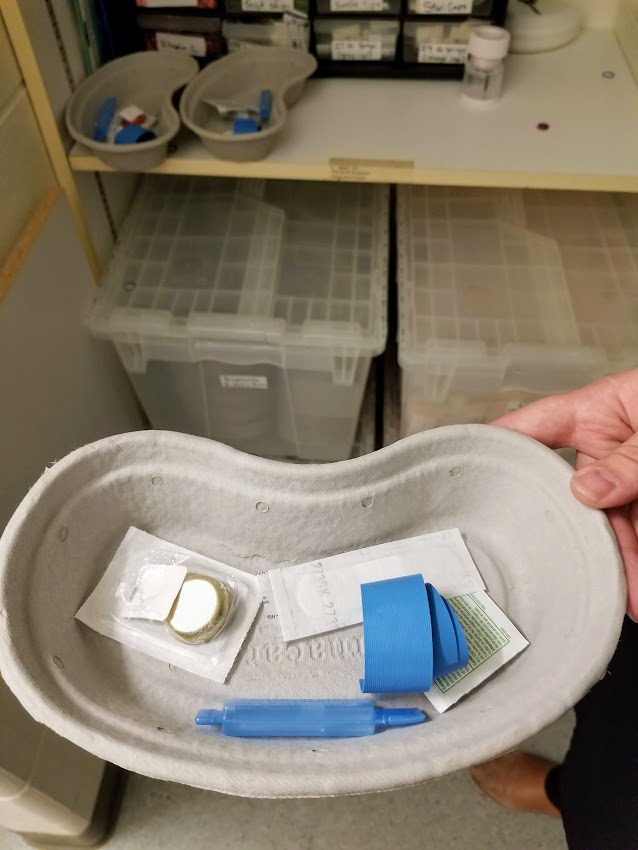
Drumheller Institution – Equipment for safe injections.
CSC health care personnel staffing the OPS received specialized training from the Sheldon Schumer Centre in Calgary (a community-based safe consumption site). They had to learn how to cook and use several different kinds of substances to understand the context of injection drug use and thus assist their “patients.” Participation in the OPS is voluntary (with informed consent), and, unlike the PNEP, a Threat Risk Assessment is not required for participation. The OPS Patient Information and Contract, which spells out expectations and conditions for participation, are not nearly as onerous or security-driven as that for the PNEP. A self-reported history of overdose, illicit drug use, active drug use and an expression of interest to participate in the OPS, are all evidence-based indicators of eligibility to participate in the OPS. Health care staff provide participants with information and guidance relevant to safe consumption practices in the context of OPS.
The service itself creates a safe zone for participants to go from their unit to the injection site. En route to the site, they cannot be charged with contraband by staff if the amount of the drug in question does not exceed personal consumption limits. A prisoner participating in the service is also not subject to additional searching or urinalysis any more than what is allowed for in policy (they cannot be singled out or targeted). Participation in the service does not, however, give carte blanche permission to use drugs or possess drug paraphernalia outside of the OPS.

Drumheller Institution – Equipment for safe injections.
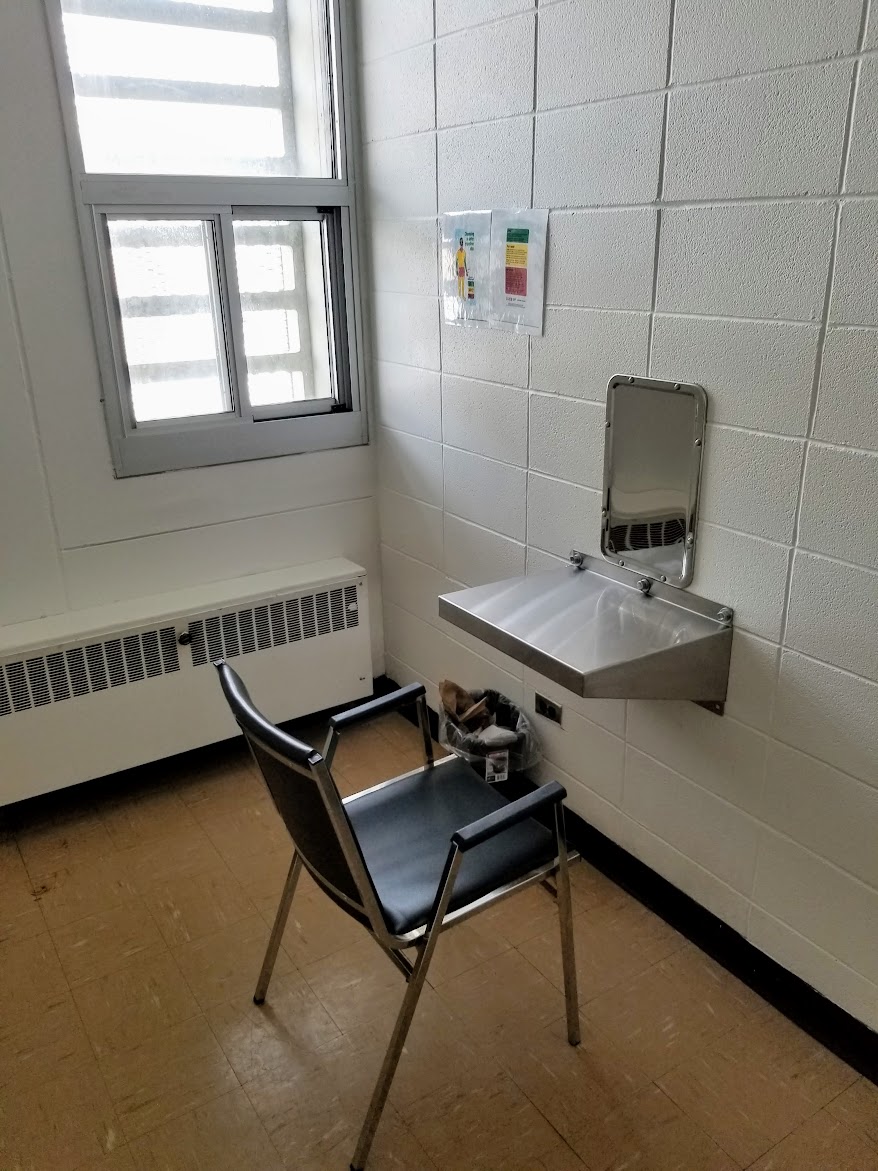
Drumheller Institution – Overdose prevention site.
As explained to one of my investigators who conducted an on-site visit of the OPS in November 2021, Drumheller was chosen to be the site of the first OPS in federal corrections because of its previously high incidence of recorded drug overdoses and prevalence of drug use, estimated to be as high as 70% of all prisoners using. While there was initial pushback from non-health care staff, perceptions and attitudes have since shifted toward a broader acceptance of the program, in part because of a concerted and proactive health care services campaign to raise awareness and acceptance among staff. Front-line staff acknowledged that drug use and drug overdoses were prevalent occurrences before the introduction of the OPS. They routinely had to administer NARCAN and/or CPR on individuals who had overdosed, so the opportunity to reduce the occurrence of these events and interventions with the OPS was welcomed. The OPS also provides a means by which to direct individuals to a safe and supervised place to use, without jeopardizing staff safety. According to information provided to the investigator assigned to Drumheller, frontline staff are now actively promoting the program to prisoners when they find them with or using drugs/paraphernalia.
With regard to uptake and usage, since first opening in July 2019 to March 2022, there had been 1,566 visits to the OPS, involving 52 participants. Since program launch to March 2022, there had been 20 drug overdoses at Drumheller. None of these occurred in the OPS. There were no overdose deaths recorded over that period.
As it stands, the OPS model is not perfect and not without its flaws (e.g., limited resources, limited accessibility and hours of operation, lacks support for peer assistance, availability and distribution of safer snorting equipment). However, it offers a potential best practice in which evidence-based learning and experience can be shared and applied to other federal prisons. It should also be made clear that the OPS is not a substitute or alternative to a redesigned and better implemented needle exchange program or for greater access to evidence-based clinical treatment and addictions programs. Together these two harm reduction measures could work in a complementary manner to more effectively and safely address the harms of drug use and addiction behind bars.
CSC’s Drug Strategy
That there is a need for more access to a wider range of harm reduction measures behind bars now seems beyond doubt or dispute. Between December 2016 – at the outset of the opioid crisis in Canada – and May 2021, CSC increased the number of individuals on Opioid Agonist Therapy (OAT) by 185%. As of March 2022, there were 3,010 persons either on OAT (2,774) or on a waitlist (236), a number which represents close to 25% of the total incarcerated population. The dramatic upsurge in OAT prescribing does not come without its own set of concerns, admittedly requiring much more in-depth analysis and assessment. Minimally, based on OAT uptake numbers alone, it is far from clear that CSC has adequate health care and counselling resources to provide effective and lasting treatment support and intervention.
These questions aside, there are other factors, trends and indicators suggesting that CSC’s current approach to drugs and drug use among prisoners is heavily tilted in favour of drug suppression and ever more sophisticated and costly surveillance and interdiction methods, such as detecting and neutralizing drone drops. The increasing number of contraband seizures in CSC facilities, jumping significantly during the COVID-19 pandemic, suggests more active search and seizure but these activities accomplish little to curb demand.
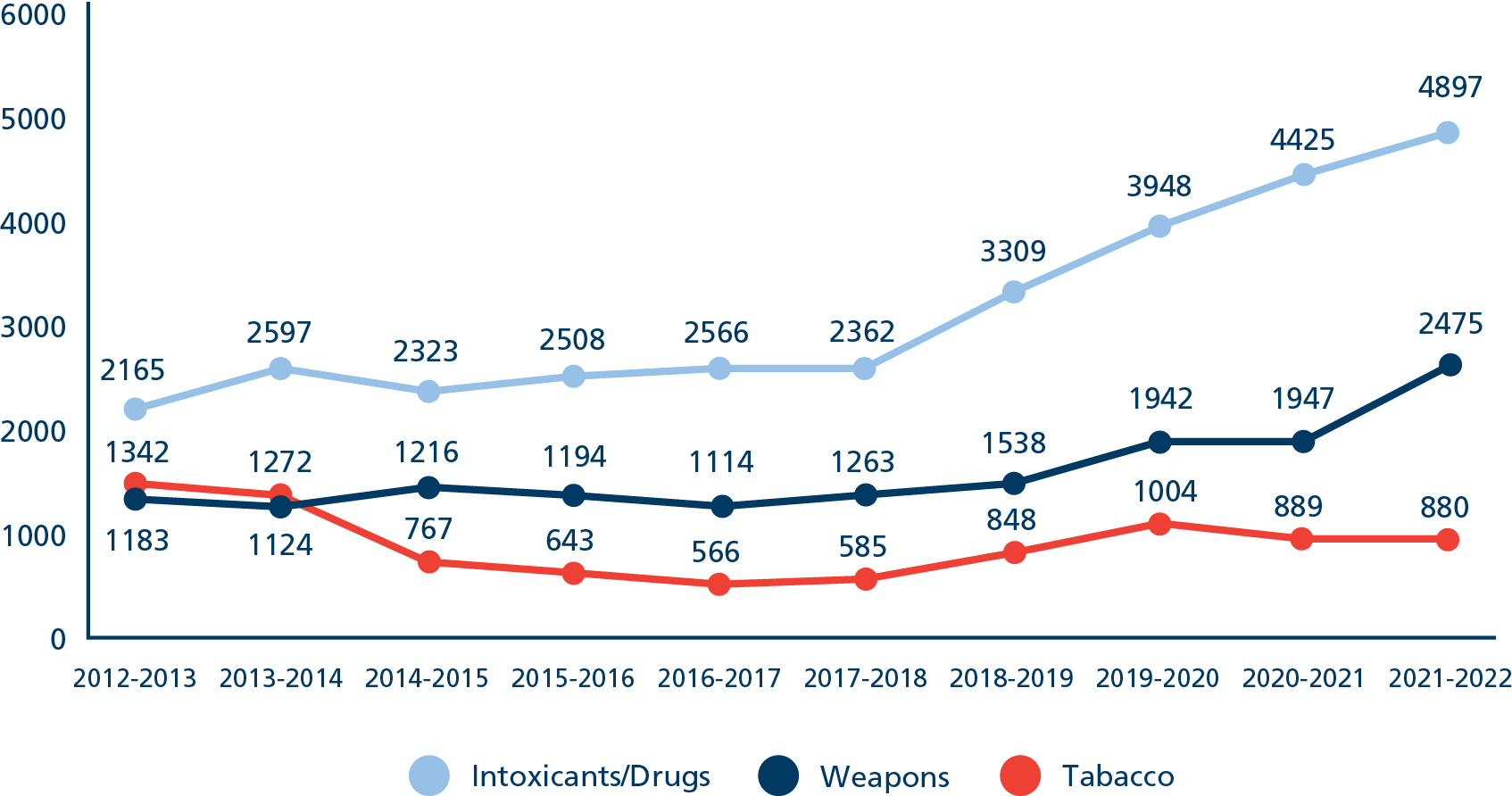
Graph 1. Total Contraband Seized by Type
Similarly, the recent and dramatic upsurge in random urinalysis tests returning positive (indicative perhaps of a COVID-related “bump” in drug use) is another indicator of the insatiable demand for drugs behind bars.
On the policy side, Commissioner’s Directive 585: National Drug Strategy has not been updated since May 2007. It is entirely redundant and irrelevant. There has been little attempt to integrate more recent harm reduction measures, such as PNEP and OPS or expand access to substance abuse programs, within a more balanced and comprehensive drug strategy for federal corrections. The current zero-tolerance approach toward drugs and drug use in CSC facilities leaves little space for other non-interdiction measures based on evidence, treatment, harm reduction, and prevention principles. As a federal entity, CSC is so out of date and non-compliant with the Government of Canada’s stated “comprehensive, collaborative, compassionate and evidence-based approach to drug policy” Footnote 3 that it is difficult to know even where to start in trying to restore a semblance of balance and relevance. What seems certain is that it is both unhelpful and harmful to continue to rely on a series of humiliating and degrading search and seizure measures that target, punish and discipline people for their substance use and addictions, issues that were often contributing factors to their incarceration in the first place.
- With respect to CSC’s drug strategy, I recommend the following set of measures:
The Prison Needle Exchange Program (PNEP) criteria be significantly revamped to encourage participation consistent with actionable recommendations of this Office and the external interim evaluation, with a view to full national implementation within the next 12 months.
The Overdose Prevention Service (OPS) be rolled out nationally, in tandem with PNEP implementation.
Commissioner’s Directive 585 – National Drug Strategy be immediately updated to incorporate evidence-based harm reduction, treatment and prevention principles and practices.
CSC’s zero tolerance policy to drug use and possession is recalibrated to focus on corrective measures for drug diversion and trafficking, rather than stigmatizing, targeting or disciplining persons struggling with addictions or substance abuse disorders.
3. Edmonton Institution
In my 2018-19 Annual Report, I began my case study on the ongoing dysfunction at Edmonton Institution with the following diagnosis: “Edmonton Institution … has been plagued by a toxic and troubled workplace culture where dysfunction, abuse of power, and harassment have festered for years.” By this point, my Office had been reporting on the problems at Edmonton Institution for many years. Both the previous Minister and Commissioners of Corrections had made personal interventions and a series of internal reviews and investigations had been launched. Numerous disciplinary actions had also been taken against institutional staff, and multiple staff surveys had been conducted to assess workplace culture and needs.
In the same report, I also publicized findings from an investigation my Office conducted on a series of prisoner-on-prisoner assaults that occurred at Edmonton Institution between August and October 2018. These findings suggested that frontline staff continued to act with impunity, allowing prisoners to assault other prisoners on repeated occasions with zero consequence. The Commissioner’s response was swift and decisive. Corrective actions were taken, including staff suspensions, the launch of an internal disciplinary investigation, and “renewal” measures to address workplace culture such as appointing a new warden and empowering management to restore a healthy and respectful workplace environment.
In my 2019-20 Annual Report, I provided an update on the disciplinary measures that had been taken in relation to the prisoner assaults. Though six of the ten CSC staff members investigated were subject to minor disciplinary measures, not one of senior rank received a reprimand of any kind.
Virtual and in-person visits conducted through the pandemic indicated a worsening of problems and tensions at this troubled institution, including staff shortages, inadequate out-of-cell time, a general decline in mood and mental health among prisoners, warehousing of medium-security prisoners, and restricted access to private family visits. These issues were raised with the warden in August 2021. Despite a number of measures taken by the institution to address these issues, my Office continued to receive numerous calls, complaints, and inquires related to ongoing and very serious allegations at Edmonton Institution.
In November 2021, my Office conducted an exceptional closed visit to Edmonton Institution, which took place over three days (November 1 to 3, 2021). Two of my senior investigators met with and interviewed prisoners from all sub-units, as well as staff and managers from all departments. They also conducted a series of in-depth interviews with several members of the senior management team, and collected unit logbooks and other documentation.
Preliminary findings were reported to the Commissioner on November 12, 2021, and included the following:
Growing number of subpopulations renders nearly all group movement impossible.
Overpopulation and double-bunking, both unusual for maximum-security prisons.
Warehousing of medium-security prisoners.
For months, regular units have had a maximum of three hours out-of-cell time, daily.
Out-of-cell access is limited to the gym, mini-yards, or common rooms; some units were restricted to 50 minutes of tier time, behind barriers, twice per week.
Access to showers, telephones and laundry facilities limited to 15-minute slots, one person at a time, once or possibly twice a day depending on staffing.
One-year waitlist to access mental health services.
One computer video visitation station to service 258 prisoners.
No programs, no meaningful work opportunities, access to education is restricted to cell studies, and meals are taken alone and in a cell.
My investigators observed conditions of confinement that were oppressive and intolerable by any standard. To be clear, restrictions on services and out-of-cell time at Edmonton Institution go well beyond the effects or impact of the COVID-19 pandemic. As concerning, it appeared that long-standing tensions and conflict among and between different staff groupings and management had resurfaced. There was little respect for management among the front-line ranks. Some staff described the chain of command as “broken.” The number of correctional officers on long-term leave was extremely concerning, indicative of a workplace in crisis. Staffing shortages restrict access to all forms of services and programs, including mental and physical health care. Staff from programs, education and mental health have extremely limited access to the population, and communication with Parole Officers was limited to request forms or mediated through a Duty Officer.
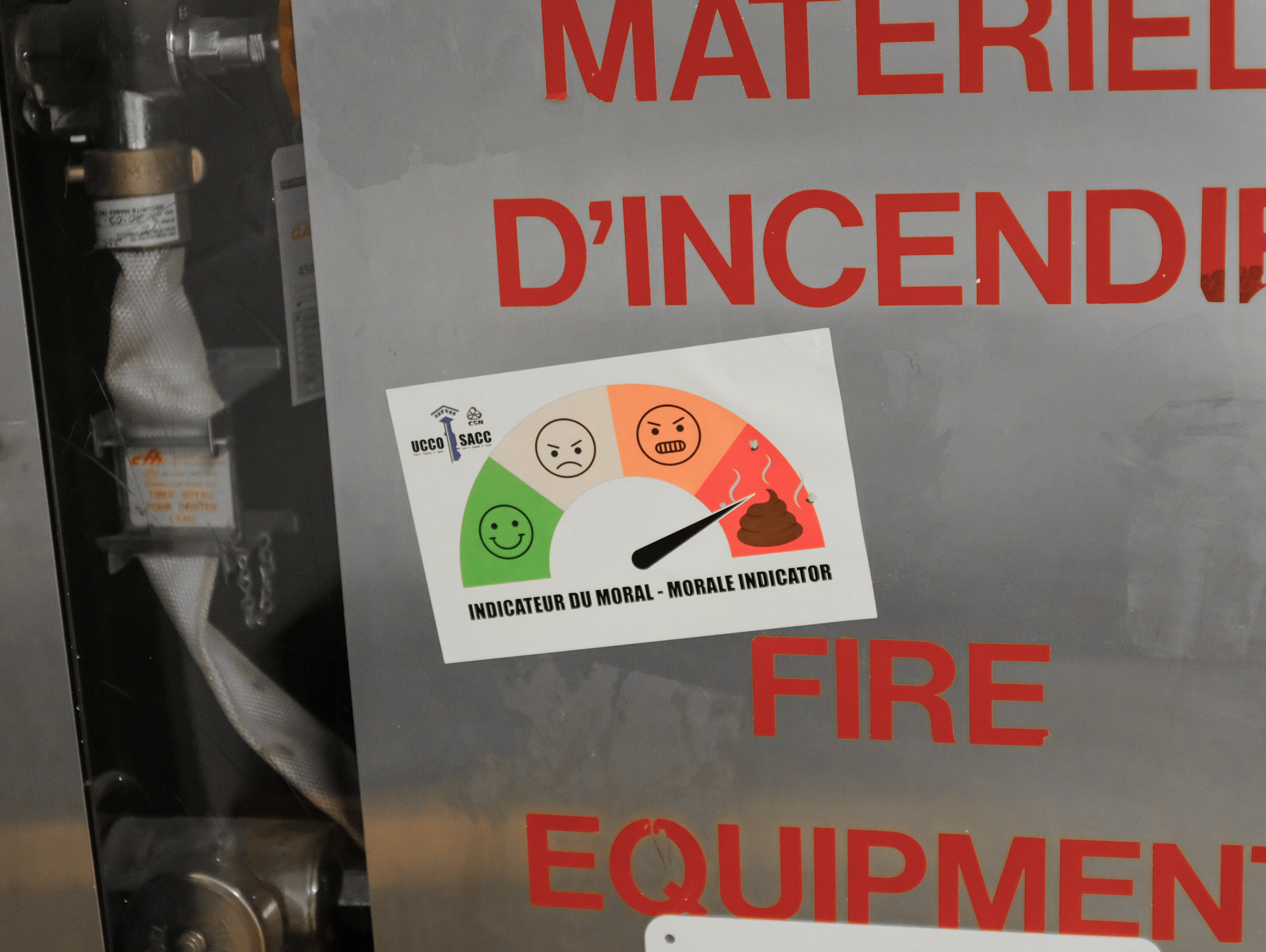
Sticker from Union of Canadian Correctional Officers (UCCO)
In light of these preliminary findings, I suggested national level intervention, including immediate assistance and support from the Commissioner. On December 8, 2021, I received a welcome response from the Commissioner, who shared my concerns and assured me that corrective measures were already underway. These measures included:
The re-implementation of in-person Citizen Advisory Committee meetings. Regular meetings involving various divisions at the institution would review institutional routines and the timely transfer of persons.
Population management meetings would resume, and would receive input from unit reps and other prisoners to promote and plan reintegration strategies.
Establishment of an Inmate Welfare Committee, which would meet regularly with senior management.
A comprehensive on-site review of interventions, including timely access to Parole Officers, access to correctional programs/education outside of the cell and access to cultural interventions.
As of December 8, 2021, the number of double-bunked prisoners was reduced to six from 18, and 13 of the 23 medium-security prisoners had been transferred to medium-security institutions.
Additional video visitation consoles were installed, bringing the total to four.
National headquarters are working with both the institution and the region to address recruitment and staff retention issues.
The back and forth exchanges between my Office, the management of Edmonton Institution and the involvement of National Headquarters are examples of what I would call “oversight in action.” Though the situation at Edmonton Institution is still far from ideal and the systemic problems brought forward are far from resolved, the collaboration and responsiveness of the Commissioner in trying to address Office findings and concerns is encouraging. My Office will continue to closely monitor the situation at Edmonton and intervene as necessary.
4. Structured Intervention Units
In November 2019, the Corrections and Conditional Release Act was amended to abolish solitary confinement by replacing the previous administrative segregation regime with Structured Intervention Units (SIUs). In my 2020-21 Annual Report, I reported my preliminary observations on SIUs, which were implemented in November 2019. At that time, I made four major observations:
- The lack of data and transparency from CSC with respect to its SIU operations has made it difficult to assess its compliance with legislation.
- The expeditious removal of prisoners from SIUs and compliance with Independent External Decision Makers (IEDMs) removal orders has been challenging.
- Some individuals find SIU conditions more favourable than the mainstream maximum-security prison population because of their greater access to services and interventions, daily visits by nurses and wardens, more opportunities to engage with non-security staff, and the possibility of greater out-of-cell time. Given this situation, some individuals refuse to leave the SIUs, as even the IEDMs have attested.
- The pandemic has generally spared individuals confined in SIUs from the restrictive impact COVID-19 has had on prisons in general, with the exception of lockdowns during institutional outbreaks.

Stony Mountain Institution – SIU exercise equipment in yard.

Stony Mountain Institution – SIU cultural room.

Edmonton Institution for Women – SIU.

Port Cartier Institution – SIU yard.
Based on these findings, I recommended that CSC publicly release a quarterly record of SIU transfer authorizations and that a timeline be issued indicating how it planned to meet its legislated reporting requirements.
Over the reporting period, I became aware that the Service was maintaining an internal record of SIU indicators. My Office’s analysis of this data highlighted some very concerning findings, particularly with respect to the differential SIU outcomes for Black, Indigenous and Peoples of Colour (BIPOC). My Office found the following with respect to SIUs in 2020-21 Footnote 4 :
Approximately half of SIU stays lasted for 15 days or more, and one third lasted for 30 days or more.
Overall, BIPOC individuals experienced more and longer SIU stays than White persons.
Black people appear to fare worse than other groups on SIU outcomes. For example, they were almost twice as likely as White persons to be placed in an SIU, and were more likely than other groups to experience SIU stays of 60 days or more.
Indigenous individuals were transferred to SIUs at a much higher rate and were more likely to experience SIU stays of 15 days or more, compared to non-Indigenous persons.
The data also suggests that CSC is not fully compliant with its legislated obligations to offer four hours of time out-of-cell and two hours of meaningful human interaction.
In February 2022, I shared my findings and concerns in correspondence to the Commissioner, including the fact that this data was supposed to have been made public. I also highlighted my concerns regarding the general conditions of confinement in maximum-security institutions arising, in part, as a result of the implementation of SIUs. As noted, some prisoners refuse to leave SIUs because they perceive conditions in the SIUs are less restrictive or safer than the mainstream prison population environment. Moreover, I have noticed substantial and dramatic growth in sub-populations in a number of maximum-security institutions, which contributes to more restrictive conditions of confinement, incompatibles, and lower security individuals waiting to cascade. I report on my findings in maximum-security institutions in more detail later in this Annual Report.
In response to my correspondence, the Commissioner commended the work of the Service in maintaining low numbers within the SIUs and indicated that it has been investigating issues highlighted in my Office’s analysis of SIU indicators as well as those in maximum-security environments. Beyond acknowledging my concerns, no concrete steps or initiatives were identified that would indicate how these issues will be addressed.
I have also shared my findings on SIUs with Mr. Howard Sapers, who was appointed in April 2021 by the Minister of Public Safety as the Chair of a renewed SIU Implementation Advisory Panel (SIU IAP). The SIU IAP was established to monitor, assess and report on issues related to the ongoing implementation of SIUs. I have full confidence that Mr. Sapers and the SIU IAP will hold CSC to account with respect to the continued implementation of SIUs and the disproportionate outcomes for BIPOC individuals.
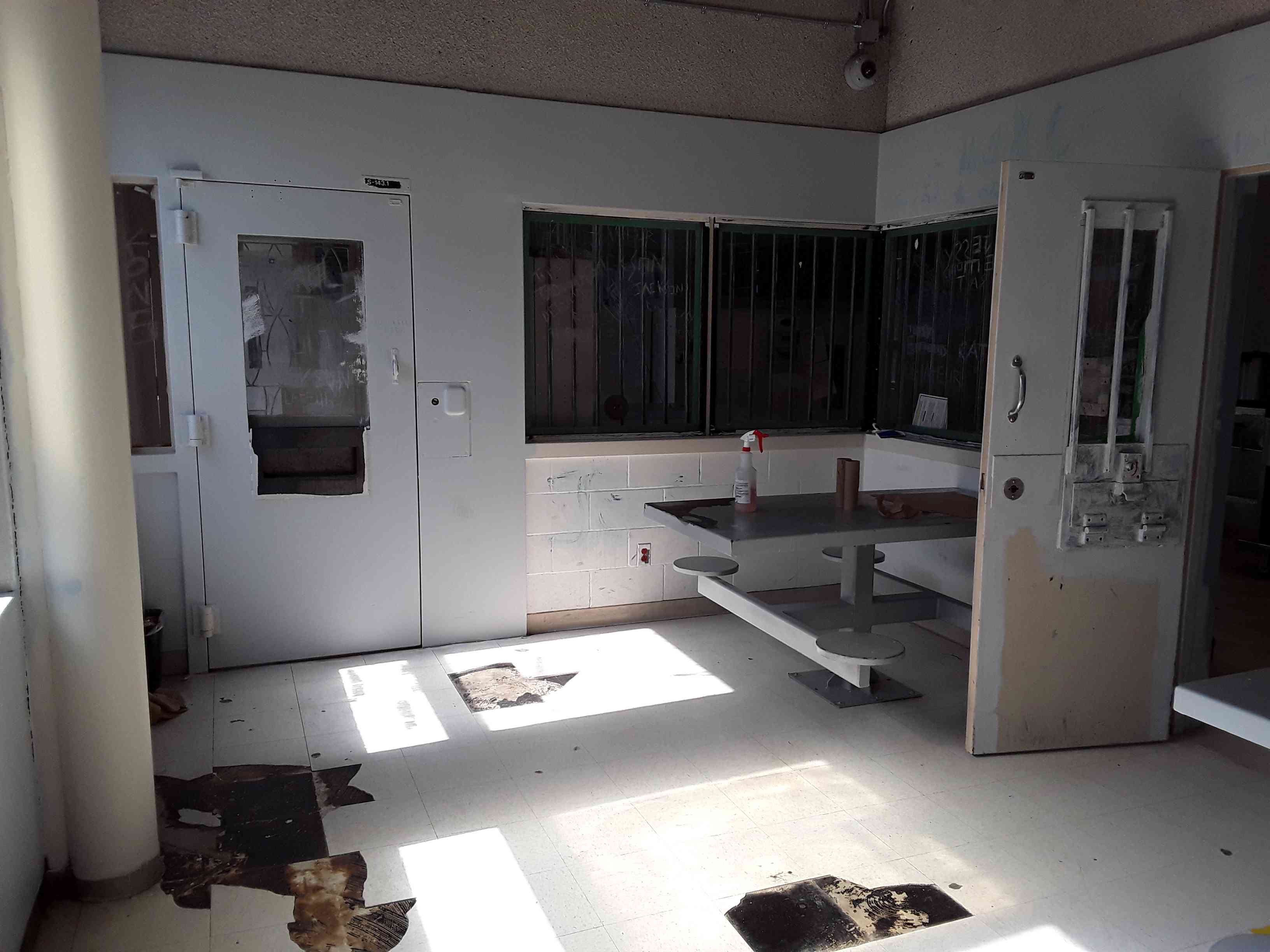
Port Cartier Institution – SIU common area.

Bowden Institution – The SIU range.
5. Over-representation of Indigenous Women in Secure Units (Maximum Security)
Indigenous women continue to be one of the fastest growing federally incarcerated populations in Canada. In December 2021, my Office issued a press release with data showing that the proportion of incarcerated Indigenous women continued to increase unabated, and was nearing 50% of all federally sentenced women. On April 28, 2022, the number of incarcerated Indigenous women reached 50% for the first time (298 Indigenous and 298 non-Indigenous women in federal custody). Even more concerning is the fact that,of the women who are classified as maximum security, almost 65% of them are Indigenous. Unfortunately, these are not new developments in federal corrections. My Office and others have been reporting on the Indigenization of Canadian corrections for years. A deeper dive into the situation uncovers that this over-representation is largely the result of systemic bias and racism, including discriminatory risk assessment tools, ineffective case management, and bureaucratic delay and inertia.
What do we know about Indigenous women in the Secure Units today?
A review of CSC data extracted on April 9, 2022, reveals the following: 29 out of 45 (64.4%) women classified as maximum security are Indigenous.
25 out of the 29 (86.2%) Indigenous women are assessed as high risk and high need.
20 out of 29 (69%) Indigenous women were born after 1990, reflecting a younger population.
The highest rate of over-representation of Indigenous women is in the Prairie region.
Of the Indigenous women classified as maximum security:
8 women are serving indeterminate sentences, with sentence start dates ranging from 1990 to 2021;
14 women are serving sentences less than four years;
Three women are serving sentences between four and six years;
Three women are serving sentences between 6 and 10 years; and,
1 woman is serving a determinate sentence more than 10 years.

Graph 2. Proportion of Women in Maximum Security
from 2012 to 2022 Indigenous vs. Non-Indigenous
Custody Rating Scale and Security Classification Process
From the very beginning of the custodial intake process, Indigenous women are disadvantaged. The security classification tool used by CSC for all federally sentenced persons is the Custody Rating Scale (CRS). This is a static actuarial instrument designed for, and tested on a predominantly white male population. For years, serious flaws with this primary assessment tool have been raised to the Service – particularly for its inappropriate application to women and visible minorities. The following are a handful of the critiques:
2001: A study funded by Status of Women Canada recommended that CSC, “Examine and design a gender and ethno-culturally sensitive method of assessment and classification.” Footnote 5
2006: The Canadian Journal of Criminology and Criminal Justice published a study providing evidence that the Custody Rating Scale introduces a systematic bias against Indigenous (relative to non-Indigenous) prisoners, whereby a substantial proportion of Indigenous women are unjustly over-classified to higher levels of security. Footnote 6
2012: Public Safety Canada released a report indicating that the scale fails to take into account any cultural or gender-specific issues, resulting in a double disadvantage based on race and gender for Indigenous women. Footnote 7
2017: The Office of the Auditor General of Canada recommended that Correctional Service Canada examine ways to improve the initial security classification process to appropriately consider the risk factors for incarcerated women. Footnote 8
My Office has repeatedly raised concerns about the use of the CRS for women, and especially for Indigenous women. In 2009, the over-representation of Indigenous prisoners in higher security levels was examined in a report released by my Office, titled, Good Intentions, Disappointing Results: A Progress Report on Federal Aboriginal Corrections. At that point, concerns with the CRS had already been flagged for over a decade. Twenty-five years later the CRS remains in use. I can’t help but ask: Why?
CSC has historically defended the CRS, indicating that it is not the only tool used in the security classification process. Accordingly, as per Commissioner’s Directive 705-7: Security Classification and Penitentiary Placement , the areas of Institutional Adjustment, Escape Risk, and Public Safety are also assessed. Part of this assessment includes an evaluation of employment, education, marital/family adjustment, interpersonal relationships, alcohol and drug use, and living arrangements – areas where Indigenous women are more likely to score higher. Additionally, as in all decision-making for Indigenous prisoners, Indigenous Social History is to be considered. The issue is whether CSC adequately and appropriately considers these areas when making classification decisions. Instead of using this information for the sole purpose of informing programming, treatment and intervention requirements, it seems to be used against these women as indicators of risk.
Indigenous Social History
The decision-making process for all Indigenous prisoners requires consideration of Indigenous Social History (ISH). The ISH examines the direct and indirect social and historical factors that have impacted the individual and contributed to their involvement in the criminal justice system. The assessment is intended to ensure that the unique circumstances of Indigenous prisoners are deliberated, and that culturally appropriate/restorative options are considered and provided. In theory, this should be a very comprehensive exercise to examine and analyze collective and individual circumstances. In practice, however, the ISH typically only consists of a list of factors that have impacted the individual. It is rare to see an analysis of what this means in terms of case management or mitigation strategies, and it is rare to see alternative or restorative options presented as part of the ISH evaluation.
Quotes from ISH Assessments
Although CSC does offer some training and an Indigenous Social History Tool to provide guidance to case management officers, throughout this review and through informal conversations over the years, staff have reported to my Investigators that the training is not enough to properly understand and connect an individual’s ISH to their risk and case management plan.
“I do the best that I can, but more training is needed.”
– Quote from an Institutional Parole Officer.
Without adequately taking into account all of the contributing factors which lead to an Indigenous woman’s involvement in the criminal justice system, the CRS and assessment process fail to appreciate the correlation between an Indigenous woman’s life circumstances, from both a collective and individual perspective. The result is a discriminatory practice. Footnote 9
CSC has advised my Office that they have funded and entered a contract with the University of Regina to review the security classification process as a whole. This is a “ground-up” process that is being led by an Indigenous team.
- I recommend that CSC prioritize the current review of the security classification process, particularly as it applies to Indigenous women. In the interim, I recommend that Indigenous Social History (ISH) be assessed in a meaningful way for each decision rendered and that case management staff are provided with adequate training and support to apply the ISH.
Indigenous Women in the Secure Unit
The Secure Units, as their name suggests, are distinct areas at each regional site with high static and dynamic security and limited movement. The units were introduced to women’s corrections in 1999, with the introduction of the Intensive Intervention Strategy in Women’s Institutions , and are intended to house maximum-security women with high risk or high needs, who require an enhanced level of staffing, support, counselling or other aspects of dynamic security. As reported in the past by my Office, Secure Units are environments where women are subjected to modified routines, restrictive movement, population management challenges, the absence of physical space, heightened population tensions, incidents, mental health crises, and isolation. The environment, infrastructure and lack of resources often make it challenging for women to cascade to lower security levels in a timely manner. Moreover, these units are the most costly to operate.

Nova Institution – SIU and secure unit yard.
Today, the Secure Units are a far stretch from the progressive model originally proposed in the Creating Choices philosophy.
[The Creating Choices Task Force] “was told by federally sentenced women that they needed support, not security. Many others consulted also believe that the traditional security system has little relevance for women whose value systems are rooted more in relationships than in systems. (…) The punitive model is, therefore, particularly irrelevant and harsh in its effect on [Indigenous] women.” Footnote 10
The five principles integral to the woman-centred approach to corrections – empowerment, meaningful and responsible choices, respect and dignity, supportive environment, and shared responsibility – are effectively non-existent in the Secure Units. Moreover, they house a predominantly Indigenous population.
While many Indigenous women with higher risk and needs may benefit from a more structured environment, the restrictive, security-driven approach within the Secure Unit often exacerbates mental health issues, impedes meaningful participation in interventions, and further alienates Indigenous women from their culture.
“I don’t want to die down here.”
– Quote from an Indigenous woman in the Secure Unit.
In the Secure Units, maximum-security women are also subject to a unique classification, or level, system. Consequently, this system results in movement restrictions that disproportionately affect Indigenous women, given their over-representation in maximum security. My Office has reported significant concerns about this level system in the past. In my 2016-2017 Annual Report, I recommended that the level system in women’s corrections be rescinded, as it is arbitrary and exists outside of the law. The movement levels were replaced by the Reintegration Movement Plan in 2019, with the promulgation of the revised Commissioner’s Directive 578, Intensive Intervention Strategy in Women’s Institutions . Although revisions included changes to review and recording timeframes, as well as to the criteria for the plan, staff supervision requirements, and decision-making authorities, the reality is that the level system remains in operation.
Women have reported to my Office that “losing their level” (i.e., being further restricted from movement off the Secure Unit) has devastating impacts. For Indigenous women, this can mean that they losing access to ceremonies (e.g., sweats) or cultural events (e.g., drumming) in the main compound that are not available in the Secure Unit. These women report that when they need these supports the most, they are not permitted to participate in them. As a result, they feel that access to their culture is something that has to be earned.
- Once again, I recommend that the level system for maximum-security women be immediately rescinded.
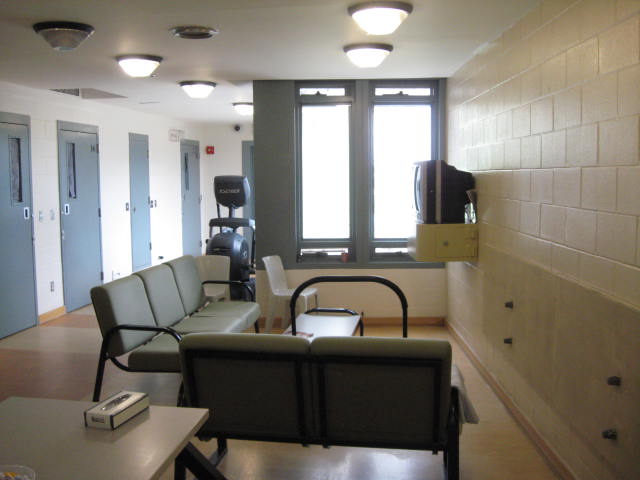
Grand Valley Institution – Maximum security unit common area.
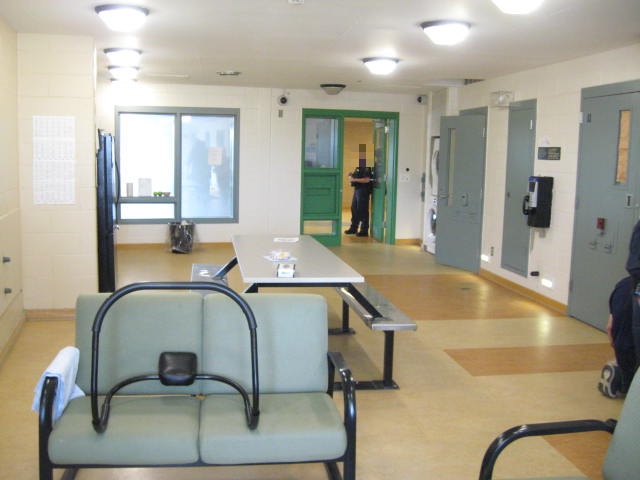
Photo of the common area at Grand Valley Institution’s maximum security unit.
Access to culture is a right, not a privilege. The Secure Units are not equipped or resourced to provide the cultural support and resources that Indigenous women need. For example, not all Secure Units have dedicated sacred grounds, a dedicated Elder, a complement of Indigenous staff, or a pre-Pathways program. Interventions and services are significantly more limited for a population of women who are assessed as high need. One Indigenous woman explained to my staff that she could not do beadwork without the accompaniment of a staff member, as the small needle that is used is deemed to be a security risk. Beading is a traditional and therapeutic hobby for many Indigenous people and the reliance on over-secure practices that hinder this activity is a clear departure from the Creating Choices philosophy.

Grand Valley Institution – Maximum security unit grounds.
Investigations and inspections conducted by my Office have revealed that many Secure Units do not have a dedicated roster of Primary Workers who are a consistent presence on the unit. Moreover, the proportion of Indigenous staff does not come close to matching the proportion of Indigenous prisoners. Although some Indigenous women reported to my Office that non-Indigenous staff can be understanding and respectful, others reported that working with staff who have a shared history and culture is much more beneficial and allows them to connect better.
Many women describe the feeling of being in the Secure Unit as comparable to being removed from their home communities. A placement in the Secure Unit is, in and of itself, another form of dislocation and displacement. Those women who experienced the Residential School System, or who have a family member who attended, report being especially triggered in the Secure Units. Some women talked about how the criminal justice system and how prisons perpetuate colonization, resulting in many of the same consequences. Modern forms of colonization and its effects remain pervasive and insidious. For incarcerated Indigenous women, this can mean being uprooted from one’s community and sent to a federal institution far from home, or it can mean being isolated in a unit that does not meet their needs.
- I reiterate my recommendation for alternative accommodations for women housed in Secure Units and their eventual closure. Funding and resources currently dedicated to Secure Unit operation should be redirected to better support and address the unique needs of women, particularly Indigenous women.
Best Practices
Throughout the course of this study, Fraser Valley Institution was able to significantly reduce the number of Indigenous women – and women overall – in their Secure Unit. Some best practices to achieve this include:
A rigorous review of all cases on a biweekly basis;
A consideration of what mitigation strategies could be implemented in medium security (e.g., placement in the Structured Living Environment or the Enhanced Support House, additional supports);
Involvement of the offender in the transition plan;
Continuity of care;
Exhausting all options before placement in the Secure Unit;
Combined involvement of the Security Intelligence Office and the Elder to manage gang tensions; and,
A dedicated Elder for the Secure Unit.
6. Mother-Child Program
Mother-child separation by maternal imprisonment can have devastating effects on individuals and families that reach well beyond the length of a prison sentence. Many of the developmental, emotional, and practical disruptions to children, as well as the traumatic consequences of mothers being separated from their children by the experience of incarceration, have been well documented. Footnote 11 In an effort to address this issue, in 2001, federal corrections implemented its first formal policy on the Institutional Mother-Child Program in all women’s facilities, largely in response to recommendations issued by the Task Force on Federally Sentenced Women in their 1990 report, titled, Creating Choices . Footnote 12
The Mother-Child Program, as described in Commissioner’s Directive 768: Institutional Mother-Child Program , is “a continuum of services and supports which aims to foster positive relationships between mothers incarcerated in women offender institutions and units and their child and to provide a supportive environment that promotes stability and continuity for the mother-child relationship.” In essence, the program allows some incarcerated mothers to apply to have their children reside with them, either full-time or part-time through the residential component (children living with their mothers in custody); otherwise, any mother can seek to participate in the non-residential components (includes services such as video visits, private family visits, and/or the recording of stories). Incarcerated mothers are not automatically offered to apply to participate in the program and the availability of space for participation is dependent on “institutional capacity”; therefore, not all mothers are eligible and not all eligible mothers have the opportunity to participate.
Library of Parliament Report on Mother-Child Program
In January 2022, the Library of Parliament produced a report on CSC’s institutional Mother-Child Program. Footnote 13 The report describes the evolution of the program since its inception, provides an overview of the available data on participation rates, and summarizes the existing research (mostly from the US) on the impacts of maternal incarceration on children. The main findings from the report, with respect to the federal Mother-Child Program, are as follows:
Insufficient data/tracking: The program has been “understudied and under-documented.” No formal evaluation has been conducted, there is little concrete data available on program participation and participants, and basic descriptive information of children who participated in the program each year is unknown (e.g., total number, age, length of stay).
Low participation rates: Participation rates have been low since the inception of the program and fluctuations in participation rates have corresponded with changes to the program eligibility criteria in 2008 and 2016.
Restrictive criteria: Restrictive program eligibility criteria contribute to low participation rates overall, and for Indigenous women in particular.
Inconsistent practices: Approvals and participation rates vary considerably by institution.
Unknown impacts on children: There is currently no research examining the experiences of or impacts on, children of whom participated in the Mother-Child Program in Canada.
I would like to further highlight a few of the areas of concern identified in the Library of Parliament report that this Office has also previously raised.
Restrictive Eligibility Criteria and Low Participation
A total of 154 mothers have participated in the Mother-Child Program over the twenty years the program has existed (see Table 1), with a median annual participation rate of five mothers per year. Unfortunately, CSC does not track the overall number of incarcerated women who are mothers, making it difficult to determine who may be in need or qualify for such a program; however, based on some estimates, approximately 66% of federally incarcerated women are mothers. Footnote 14 In the context of the number of women in federal custody today, this would represent nearly 400 incarcerated mothers. Footnote 15 With five mothers participating in the program each year, it does not appear that this program is serving the needs of a significant portion of incarcerated mothers.
Understandably, in an effort to protect and promote the best interest of the child, the eligibility criteria for the program has been stringent; however, changes brought about in June 2008 served to significantly restrict who would be eligible. Footnote 16 These changes included:
Excluding individuals from the program who have been convicted of serious crimes involving violence toward children or those of a sexual nature;
Restricting the part-time program to children aged six and under;
Requiring the support of local Child and Family Services before the participation of an offender is approved; and,
Re-evaluating the participation in the program of any offender who refuses to allow her child to be searched for drugs or other contraband before entering an institution.
Table 1. Final Decisions on Mother-Child Program Applications by Fiscal Year Footnote 17
| FINAL DECISION | 02-03 | 03-04 | 04-05 | 05-06 | 06-07 | 07-08 | 08-09 | 09-10 | 10-11 | 11-12 | 12-13 | 13-14 | 14-15 | 15-16 | 16-17 | 17-18 | 18-19 | 19-20 | 20-21 | 21-22 | TOTAL |
| APPROVED | 2 | 4 | 1 | 1 | 5 | 9 | 3 | 3 | 4 | 3 | 1 | 3 | 6 | 14 | 24 | 13 | 18 | 20 | 13 | 7 | 154 |
| NOT APPROVED | – | – | 1 | – | 2 | 1 | 3 | 2 | – | 1 | – | – | 1 | 1 | 3 | 2 | 2 | – | 7 | 3 | 29 |
| TOTAL | 2 | 4 | 2 | 1 | 7 | 10 | 6 | 5 | 4 | 4 | 1 | 3 | 7 | 15 | 27 | 15 | 20 | 20 | 20 | 10 | 183 |
Following these changes to the eligibility criteria, the already low participation rates dropped further. Concerned that the program had simply become a program in name alone, my Office issued a recommendation in its 2009-10 Annual Report that the Service should, “review eligibility restrictions on the Mother-Child Program with a view to maximizing safe participation.” Though participation increased rather significantly in 2015-16, likely due to changes to the eligibility criteria and the implementation of a part-time residential program for children up to the age of majority, rates have remained stubbornly low. Footnote 18 Participation numbers this Office obtained directly from the five sites were lower than those obtained from CSC’s internal data. As of March 31, 2022, the sites reported that there were only four women participating in the Mother-Child Program (two full-time and two part-time). While the COVID-19 pandemic has undoubtedly had an impact on the ability of this program to run as intended (as it has with most other institutional programs), long-standing low participation rates suggest that the program is not meeting the needs of the vast majority of incarcerated mothers. Furthermore, the program is falling short of the original intent and spirit of what the Task Force on Federally Sentenced Women envisioned when they called for new women’s facilities to “provide a home-like environment and sufficient flexibility to enable a child or children to live with their mother.” Footnote 19
Mother-Child Program Eligibility Criteria for Residential Component
According to CD 768 – Institutional Mother-Child Program , the eligibility criteria for participation of mothers and children in the program are as follows:
Eligibility Criteria for Mothers
Classified minimum or medium security, or maximum and being considered for medium.
Screened against the provincial child welfare registries to verify whether information exists that should be considered in the decision-making process.
Have support from the child welfare agency for their participation.
Have no current assessment from a mental health professional indicating that the mother is incapable of caring for their child due to a documented mental health condition of the child or the mother.
Have not been convicted of an offence against a child or one which could reasonably be seen as endangering a child. An inmate who does not meet this criterion may be considered if a psychiatric/psychological assessment determines that they do not present a danger to their child.
Are not subject to a court order or other legal requirement prohibiting contact with their child or children.
Eligibility Criteria for Children
Not older than four years of age for full-time residency in a living unit, or not older than six years of age for part-time residency in a living unit, or under the age of majority for part-time residency using the private family visit unit location.
Participation of Indigenous Mothers
According to CSC data, of the total 183 mothers who have applied to participate in the Mother-Child Program since 2002, 29% (53 mothers) have been First Nations or Métis women. It should be noted that there have been no Inuit women who have sought participation in the program. Footnote 20 Based on this data, Indigenous women appear to be under-represented in the program compared to their significant representation in the incarcerated population, which currently stands at 50%. Footnote 21 The low rates of participation among Indigenous mothers can be in part attributable to the criteria that disproportionately exclude Indigenous women and program requirements that may make them less likely to apply. More specifically, the high rates of Indigenous women with a maximum-security classification make them ineligible for participation. Indigenous women are vastly overrepresented in maximum security (i.e., account for 64% of women in maximums), and the majority have a current violent offence on their record. Footnote 22 In addition to the exclusionary criteria, the required involvement of child welfare agencies may serve to discourage Indigenous women from applying to participate altogether, given the uniquely painful history and continued involvement of child welfare agencies in the dissolution of Indigenous families, particularly through the Sixties Scoop and placement of Indigenous children in the foster care system. Footnote 23
In keeping with the calls-to-action of recent parliamentary reports, government commissions and national inquiries, and given the issues as noted by this Office and the Library of Parliament, the Service must make more intentional efforts to keep Indigenous mothers connected with their children.
With the Commissioner’s Directive on the Mother-Child Program due for review in January 2023:
- I recommend that CSC:
Conduct a review of the program requirements and eligibility criteria for the Mother-Child Program, with a view to increasing access and participation in the program and removing barriers, particularly for Indigenous mothers; and,
Collect, track, and publicly report on participation in the Mother-Child Program to better understand who it is serving and how the program is functioning.
7. Security Escort Vehicles

CSC prisoner transport vehicle – 2017 model.
In response to safety, design, and legal concerns raised in the Office’s 2016-17 Annual Report regarding CSC’s prisoner security escort vehicles, the Service committed to replacing its current fleet to “reflect recent industry advancement in design and configuration.” Footnote 24 At the time, CSC also agreed to review purpose-built security escort vehicles currently in use by the RCMP and the Canada Border Services Agency as part of its lifecycle replacement project. Footnote 25
In September 2019, the Office was invited to view and inspect the prototype vehicle that CSC was considering to replace its aging and inadequate security escort fleet. At a meeting between senior CSC and OCI management teams in November 2019, I shared concerns about the prototype vehicle, primarily focused on the design and safety features of the prisoner insert (no seatbelt assembly, lack of grab bars or handrails, austere, hard and claustrophobic interiors). I also challenged the need for these vehicles to be designed in a way to accommodate up to five escorting officers, noting by contrast the inadequate space of the compartments where prisoners would be seated.
Following this exchange, the Commissioner committed to personally inspecting the prototype vehicle along with senior members of her management team. Based on this inspection, and following our meeting, the Commissioner wrote to me at the end of January 2020 indicating that she had “asked for consideration of potential options to increase the space available for inmates and address concerns related to seatbelts, including the possibility of adding an extra bench.” I took this as an expression of CSC’s commitment to address my concerns in a serious and substantive manner.

CSC prisoner transport vehicle adapted for person’s with disabilities.
Procurement and production problems caused by the COVID-19 pandemic led to unforeseen, though understandable, delays in CSC’s replacement plans. In March 2021, at a meeting of senior OCI and CSC team members, the Service presented what progress had been made in its effort to design and procure a suitable prisoner transport vehicle. According to the Service, the new design modifications included “several improvements,” such as an L-shaped bench on each side of the two prisoner compartments and an extension in the overall length of the insert (by eight inches) – two design features that would ostensibly allow for a taller individual to sit facing backwards while stretching out their legs. Notably, the prototype still did not include a seatbelt assembly in the prisoner insert. Moreover, the vehicle maintained features that would allow up to five correctional officers to occupy the front and back seat of the reconfigured Ford Transit 350 van in safety and comfort. These design features struck me as self-serving and largely devoid of commitment or concern for prisoner safety.
In December 2021, with no prior notice and only after requesting a status update on this issue, the Office was informed that the modified prototype presented at the March 2021 meeting had been approved by CSC Senior Management in May 2021. The Office was also informed that a number of new vehicles had already been delivered to institutions across the country and that other deliveries were planned to meet CSC’s replacement plans and budget. In a follow-up exchange involving seatbelts, the Office was informed in January 2022 that “options for their future inclusion are being discussed in collaboration with key stakeholders and we will be in touch when potential solutions are ready to be presented.” None of these developments seemed in keeping with the Commissioner’s commitment a year earlier to review and consult with my Office on CSC’s progress to renew its fleet of escort vehicles.
As it turns out, CSC deviated significantly from the RCMP-type escort vehicle on standing offer with government suppliers. CSC refers to these modifications as “correctional adaptations.” With respect to specific deviations from the RCMP-type vehicle, the CSC customization process requires removing the front insert that can accommodate three passengers, shortening the rear insert and reducing its capacity from eight passengers to four. As a result, whereas the RCMP-type vehicle can accommodate up to 11 detainees, CSC’s prisoner inserts can accommodate a maximum of four persons (though most likely ever only one, or very rarely two, seated in separate compartments).

CSC prisoner transport vehicle – View from the rear.

CSC prisoner transport vehicle with a correctional officer
seated inside the prisoner compartment.
These “adaptations” provide space to add a second row of seating in the front cab to meet staffing requirements for ground escorts for maximum and medium-security prisoners. According to policy, two officers are required for the first prisoner (inclusive of the driver), and one additional officer for each additional passenger. It is not clear that these vehicles would ever be used to transport more than two medium or maximum-security prisoners at a time. It is most likely that the maximum number of persons transported at any one time would be two, seated on opposite sides of the compartment, for purported public and personal safety reasons.
As the photos of the new escort vehicle now in service show, the insert where prisoners are held is spartan, outfitted in stainless aluminum and the space is still as tight and claustrophobic as the previous design. Bench width, seat-to-ceiling height and overall cubic feet of space are not significant improvements over the older inserts it will replace. Indeed, there is little in the reconfigured design that would indicate that the health, safety, dignity or comfort concerns of prisoners were adequately considered. In fact, CSC confirmed that it did not consult incarcerated individuals in the design or procurement stages, contravening CCRA Section 74:

CSC prisoner transport vehicle with a correctional officer
climbing into the prisoner compartment.
“The Service shall provide inmates with the opportunity to contribute to decisions of the Service affecting the inmate population as a whole, or affecting a group with the inmate population, except decisions relating to security matters.” To provide but one important area of oversight with respect to prisoner health and safety: there is no two-way audio or emergency call button for prisoners that could be used in the event of an emergency. Video monitoring does not replace audio for a person trying to communicate distress.
As mentioned, the prisoner seating area does not contain seatbelt assemblies, even though the insert is originally supplied and shipped from the American manufacturer to CSC with seatbelt assemblies intact. Seatbelts are intentionally removed when the prisoner insert assembly crosses the border and fixed to the modified Ford vehicle as per CSC’s chosen design specifications. The Service cites three generalized concerns with equipping their escort vehicles with prisoner seatbelts:
Concern over seatbelts becoming weapons and being used against staff or other prisoners in a violent way (mitigated by the obvious fact that the compartments on each side of the insert barely have enough room to accommodate a single passenger).
Concern for staff safety in reaching inside the vehicle to buckle or unbuckle a prisoner (who is cuffed at the front, and restrained by body or leg shackles, or both, depending on the circumstances and prisoner).
Concern in the event that a prisoner intentionally harms or self-injures with the buckle or the belt strap.
These safety and security risks continue to be raised, even though CSC prisoner escort vehicles have never been equipped with seatbelts and therefore no actual point of reference exists to substantiate or refute these claims. In point of fact, in the six years that have passed since the Office first raised this issue, CSC has never furnished specific or substantiated cases or information to demonstrate that prisoner seatbelts could be used in such harmful manners.

CSC prisoner transport vehicle.

CSC prisoner transport vehicle – Front seats.
More specifically, it is not clear how a shackled and restrained prisoner is supposed to climb the steps into the back of the van, manoeuver into position and take their seat in the confined insert area without some assistance from an escorting officer. Policy and/or technical solutions and adaptations could be made to preclude officers having to reach in or over a shackled prisoner to fasten a seatbelt (for example, loosening body or cuff restraints, providing handholds, issuing oral instructions, video monitoring). The fact that prisoners are subject to continuous video monitoring while under vehicular escort – a technical specification that would presumably alert escorting officers to potential security risks or situations of self-injury, and therefore allow them to assess and act accordingly to these behaviours – would be part of any mitigating strategy to address or reduce risk. There does not seem to have been a serious attempt to engage in a mitigation strategy to address the concern of seatbelts possibly being used in harmful manners.
The Service has only recently advised that they are working on a Threat Risk Assessment (TRA) examining the issue of seatbelts for prisoners. No time frame or points of practice have been provided for the completion of this internal exercise. On this point, I would equally counter that a TRA would only be required to remove, alter or otherwise adapt a fixed and mandatory seatbelt harness and assembly on evidence that a prisoner presented as an actual or perceived threat to self or others while under security escort.

CSC prisoner transport vehicle – Rear passenger seats.
Finally, on the issue of seatbelts, CSC claims that the patchwork of provincial (and federal) vehicle standards, laws and regulations in effect across the country, including the federal Interpretation Act , exempts it from equipping their escort vehicles with seatbelts. CSC also claims that it is compliant with Transport Canada legislation and regulations. However, there are no specific federal standards, rules, or regulations that govern the design, safety or vehicular specifications for prisoner inserts in Canada. Federal regulations in this area are distinct in that they normally apply to vehicles that conduct interprovincial transport (which is the case for CSC escort vans). Though some provinces specifically exempt prison escort vehicles from seatbelts (some even citing CSC practice in this matter), it should be noted that they do not expressly forbid their use either.
Importantly, before the latest amendments to federal regulations, which were mostly aimed at seatbelt assemblies for passenger buses, there was no specific reference to vehicles dedicated to the transport of prisoners. In the latest amendments, Transport Canada adopted American standards for safety features in buses and, in so doing, adopted similar seatbelt exclusions for what are called “prison buses” (by definition including ten or more prisoners). However, since CSC’s escort vehicles have fewer than ten designated prisoner passengers, they may not be excluded from the federal requirement to provide seatbelt assemblies.
In any case, I conclude that the legality of equipping CSC escort vehicles with seatbelts is largely a moot point. If my premise that the prisoner insert itself is not a safe means of conveyance, then CSC can be found to be in violation of its primary mandate. As importantly, CSC seems to be taking on unnecessary and potentially costly liability (we are aware of ongoing litigation where a federal prisoner allegedly suffered injury in the back of one of these vehicles) by deliberately removing or not providing restraining devices for prisoner use in its escort vehicles. My Office continues to receive and investigate complaints from individuals who have alleged that they have been injured in the back of these vehicles precisely because they have no way to restrain or protect themselves from erratic or dangerous driving, unsafe road conditions or unseen hazards, such as potholes, steep inclines or sharp curves. One prisoner aptly describes the experience of riding in the back of one of these vehicles as akin to “bouncing around in a tin teacup.” We are also aware of instances where prisoners simply refuse to be escorted in the back of one of these vehicles even to seek required external medical treatment.
CSC has an important opportunity and obligation to lead the way in this matter. CSC could and should continue to collaborate with Transport Canada and other stakeholders to ensure safe and humane prisoner transport. Staff and prisoner safety are not mutually exclusive or self-serving categories.
- I recommend that, without any further delay, CSC outfit all of its prisoner escort vehicles, including those currently in service, with seatbelt assemblies, handholds and other safety and restraint features that would meet its obligation to provide safe and humane custody of prisoners under security escort. I further recommend that CSC return to the drawing table to reconsider its planned “modernization” of its security escort fleet that is more responsive to Office concerns and recommendations.
Update on the Experiences of Black Persons in Canadian Federal Penitentiaries
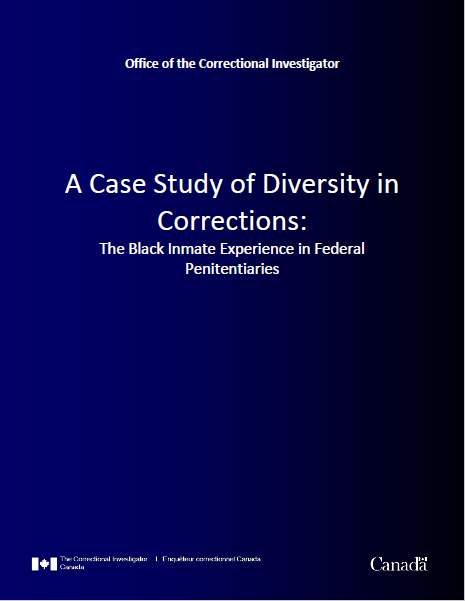
A Case Study of Doversity in Corrections report cover page
In November 2013, the Office publicly released its groundbreaking investigation examining the experiences of Black persons in federal custody. Footnote 26 At that time, the incarcerated Black population was one of the fastest growing sub-populations in federal corrections, representing 9.5% of the total incarcerated population, while representing less than 3% of the Canadian population. The major findings from the investigation included the following:
Incarcerated Black people were overrepresented in maximum security and segregation (solitary confinement), incurred a disproportionate number of institutional charges, and were more likely to be involved in use of force incidents.
Though only one in five Black persons had an identified gang affiliation, discriminatory and prejudicial attitudes by some CSC staff often meant that those without a gang affiliation were labelled and treated as such.
Correctional programs needed to be reviewed and updated from a diversity perspective and emphasis needed to be given to hiring and retaining more diverse frontline and program delivery staff.
Cultural programming and relevant community support was limited.
Diversity and sensitivity training for CSC staff was required.
The Office made two recommendations, which included the development of a National Diversity Awareness Training Plan for staff and the establishment of an Ethnicity Liaison Officer position at each institution. In response to the Office’s recommendations, the Service was generally supportive and committed to monitoring offender grievances to identify organizational learning needs in this area and to integrating specific scenarios addressing diversity, sensitivity awareness and cultural competency into its training programs. CSC did not agree to establish an Ethnicity Liaison Officer (ELO) at each institution because there were “…staff members at each site performing the duties of the Ethnocultural Site Coordinator (ESC) as an extension of their duties… [so] the roles and responsibilities of ESC are similar to what is expected from the ELO.” However, there was a commitment that clear and specific direction would be provided to regions and sites to ensure national consistency to respond to ethnocultural offenders. For example, CSC would ensure defined roles and responsibilities of ESC, develop a National Strategy that identifies the specific needs of ethnocultural offenders, strategies to ensure equal access to services and interventions, and build on community partnerships to expand the range of interventions for this segment of the prison population.
Context
When the Office conducted its investigation in 2013, the only major study in Canada identifying systemic bias and racism within the criminal justice system went back to a 1994 report published by the Commission on Systemic Racism in the Ontario Criminal Justice System . Footnote 27 The Commission found evidence of systemic racism within each of the components of the Ontario criminal justice system and made a number of recommendations to improve its accountability. Since that time, public discourse surrounding use of force on Black individuals and systemic racism within the criminal justice system have gained increasing momentum both internationally and domestically and successive academic studies and government reports have since followed repeating the findings from the Commission.

Banner for the UN's International Decade
for People of African Descent
At the international level, in order to “Promote respect, protection and fulfillment of all human rights and fundamental freedoms by people of African Descent,” the United Nations General Assembly proclaimed the period from 2015 to 2024 as the International Decade for People of African Descent. This proclamation commits UN member states, including Canada, to ensuring that people of African descent have full access to effective protection and remedies against racial discrimination.
With respect to Canadian federal corrections, the UN Working Group of Experts on People of African Descent reported on its mission to Canada in 2016, stated the following:
According to the Office of the Correctional Investigator of Canada, in 2015-16, Black inmates represented 9 per cent of the federal prison population and 7.5 per cent of the federal supervised population although Black Canadians comprise just 3 per cent of the Canadian population. In terms of correctional outcomes, Black persons in federal custody are overrepresented in maximum security, segregation (or solitary confinement) and use of force incidents. They incur a disproportionate number of institutional charges, particularly those that could be considered discretionary on the part of correctional staff, and are released later in their sentence and less likely to be granted day or full parole.
The Office of the Correctional Investigator reported that Black prisoners were 1.5 times more likely to be placed in maximum-security institutions where programming, employment, training, education upgrading, rehabilitative programming and social activities are limited. Furthermore, Black persons experience discrimination by correctional officials through the use of racist language, as well as being ignored and disregarded in ways that increase feelings of marginalization, exclusion and isolation. Those inmates are also often labelled with discriminatory stereotyping such as being called a gang member or troublemaker or drug dealer or womanizer. A review of data from 2008 to 2013 showed that Black persons were consistently overrepresented in administrative segregation, particularly involuntary and disciplinary placements, and in 2012-2013, they were disproportionately involved in use of force incidents.
The UN Working Group of Experts on People of African Descent further recommended that Canada:
Develop and implement a national corrections strategy to address and correct the disproportionately high rates of African Canadians in the correctional system and ensure anti-discriminatory and culturally specific services for African Canadian offenders; and,
Develop a national diversity-awareness training plan for the federal and provincial correctional services and appoint an ethnicity liaison officer in each institution. Urgently increase the staffing of the correctional service and explore alternatives to lockdowns that will not result in the impairment of the human rights of detainees.
To date, these two key recommendations have not been substantially implemented by CSC.

Logo for the Black Lives Matter movement
In Canada, current events have also contributed to a greater collective awareness of the importance of addressing discrimination and other forms of race-based violence against Black people. Footnote 28 One of the most publicized of these events was the murder of American George Floyd in May of 2020 at the hands of members of the Minneapolis police force, which resulted in an international mobilization against anti-Black racism. In Canada, the Black Lives Matter social movement shook the country, a disturbing reminder of the Black lives lost in interactions with Canadian police forces. It was also a reminder of numerous cases of racial profiling that resulted in Black individuals experiencing abusive arrests and detentions. Among the serious incidents that have unnerved Canada’s public opinion of the criminal justice system is the case of Abdirahman Abdi, an Ottawa resident of Somali origin who died in July 2016 during a police intervention while suffering from mental health problems. More recently, Guinean student Mamadi Camara, falsely accused by the Montreal police of the attempted murder of a police officer, was brutally arrested and detained in January 2021. Footnote 29
In 2019 and 2021, the Canadian Government released reports on the human rights of federally sentenced persons. These reports have concluded that there is an urgent need to develop targeted strategies, “…to address the root causes of the over-representation of Black persons in the federal correctional system, including systemic racism and historical discrimination.” Footnote 30 For example, the Standing Senate Committee on Human Rights made the following preliminary observations Footnote 31 after visiting federal penitentiaries:
The committee wishes to draw attention to the fact that it has heard personal stories of racism and discrimination from almost every Black individual with whom it has had contact during its fact-finding visits. This includes persons serving sentences and those administrating them. Discrimination was often based on multiple, intersecting identity factors like gender, race, language and ethnic origin. These experiences transcend the correctional environment and condition the way Black people in Canada experience the world. As one witness stated, “one aspect of anti-Black racism in the prison system is that it is not only applied to prisoners but also to Black communities, families and advocates.” Another told the committee that they would need to live a year in her skin to fully understand her testimony.
The Correctional Investigator indicated to the committee that the CSC has not addressed the systemic issues related to racism and discrimination against federally sentenced Black persons that the OCI documented in a 2013 report.
The Standing Senate Committee on Human Rights in its final report made the following observations:
The committee met with a number of federally sentenced Black persons during site visits who were discouraged by the quality and availability of culturally appropriate programming. The committee heard that the lack of culturally appropriate programming perpetuates the cycle of criminalization and the systemic discrimination against Black Canadians.
The committee heard many stories from federally sentenced Black persons about instances of blatant anti-Black racism against federally sentenced Black persons and Black correctional officers. Some of these instances include being called derogatory names, not having work opportunities available to them, being assumed to be gang affiliated for wearing a do-rag or being seen in a group of other federally sentenced Black persons.
These condemnatory findings prompted the Prime Minister of Canada to issue a mandate letter to the Minister of Public Safety to address systemic racism in the criminal justice system, including federal corrections. The PM directed the Minister to:
Continue to combat systemic racism and discrimination in the criminal justice system, including across all federal departments and agencies responsible for national security and the safety of Canadians. This also includes supporting the Minister of Justice and Attorney General of Canada in their work to address systemic racism and the over-representation of Black and racialized Canadians and Indigenous Peoples in the justice system.
My Office is very encouraged by these recent new commitments and offers this update on the experiences of Black persons in Canadian federal penitentiaries as an opportunity for the Government of Canada to address key concerns about systemic racism in federal corrections. A positive response to my recommendations will go a long way to addressing the systemic human rights concerns in federal corrections.
Methodology
Similar to the 2013 investigation, this investigation used a qualitative and quantitative approach that included the following:
A review of relevant research and policies;
Analysis of data from CSC; and,
Interviews with CSC staff, incarcerated persons, academics and Black community group representatives.
Interviews were conducted in the Ontario, Quebec and Atlantic regions. The largest proportion of Black individuals are incarcerated in the Ontario region (54.8%), followed by the Quebec region (19.2%), the Prairie region (13.6%), the Pacific region (7.1%) and the Atlantic region (5.3%). Due to ongoing concerns of the COVID-19 pandemic, interviews were mostly conducted virtually with the exception of those conducted at Grand Valley Institution for women, which were completed in-person.
Table 1. Federal Institutions where Interviews were conducted.
| INSTITUTION | REGION | SECURITY LEVEL | BLACK PERSONS AS A PROPORTION OF THE OVERAL INSTITUTIONAL POPULATION |
| ATLANTIC | ATLANTIC | MAXIMUM | 12.8% |
| SPRINGHILL | ATLANTIC | MEDIUM | 6.5% |
| COLLINS BAY | ONTARIO | MAXIMUM AND MEDIUM | 29.6% |
| WARKWORTH | ONTARIO | MEDIUM | 21.9% |
| GRAND VALLEY INSTITUTION FOR WOMEN | ONTARIO | MAXIMUM, MEDIUM AND MINIMUM | 8.2% |
| COWANSVILLE | QUEBEC | MEDIUM | 13% |
In total, 56 interviews were conducted with incarcerated Black persons, seven CSC staff members, and Preventive Security and Intelligence at National Headquarters. Consultations were also conducted with five Black community groups/advocates working with incarcerated Black persons.
Profile of Incarcerated Black Persons
Similar to the Office’s findings in 2013, Black individuals continue to be overrepresented in federal custody. In 2021-22, Black persons represented 9.2% of the overall incarcerated population, despite representing about 3.5% Footnote 32 of the Canadian population. The total number of Black people in federal penitentiaries has decreased by 12.4% since 2012. This decrease should be understood in the broader context where the total federal prisoner population declined by 16.5% over the same period and the number of White individuals decreased by 23.5%. For this investigation, Black refers to those self-identifying as Black, Sub-Saharan African and Caribbean, self-reported racial and geographical categories used by CSC.
Complaints to the OCI
Over the period December 31, 2017 to November 6, 2021, 110 individual complaints (105 men and 5 women) from Black individuals were made to the Office. The majority of these complaints came from individuals in maximum (36%) and medium security (35%) institutions. Most reported that they had experienced discrimination, victimization, racism, harassment or physical and/or verbal aggression. The number of complaints to the Office where discrimination and/or racism was the basis of the complaint appears to be increasing over time. In 2018, 16 complaints were filed with the Office compared to 24 in 2019, 39 in 2020 and 30 as of November 6, 2021.
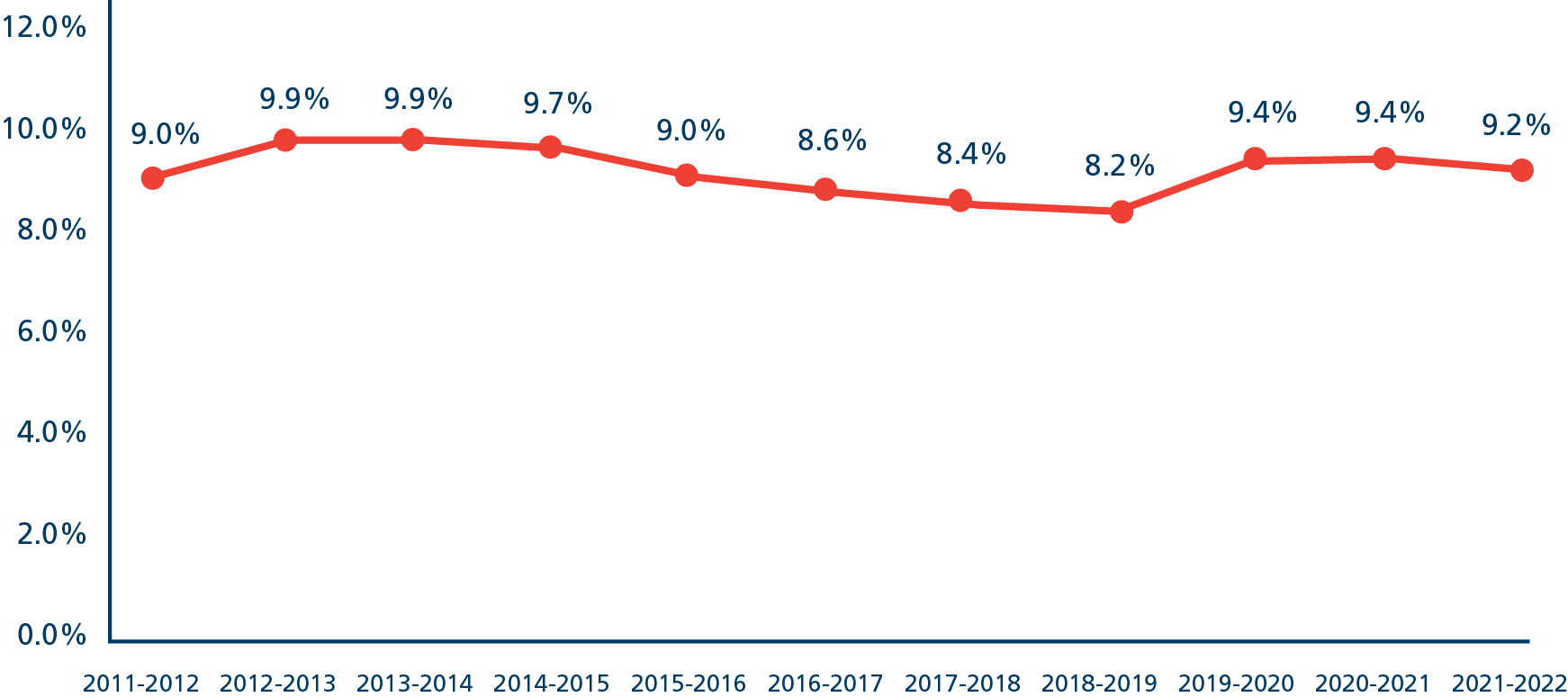
Graph 1. Incarcerated Black Individuals as a Proportion of
the Total In-Custody Population
Snapshot of the Incarcerated Black Population
The following is a general profile of demographic and sentencing characteristics of individuals who self-identified, at admission to a federal penitentiary, as Black, Sub-Saharan African and Caribbean. Statistics have also been provided for those identifying as White Footnote 33 , Indigenous Footnote 34 and persons of colour Footnote 35 for comparison purposes (See Appendix A: Population Profile, at the end of this investigation).
The majority of incarcerated Black persons are young men with the largest proportion of Black individuals falling between the ages of 18 and 30 years. As is the case with all federal prisoners, Black individuals are mostly housed in medium security; however, larger proportions of Black individuals are housed in maximum security compared to other groups. One of the most apparent differences between Black persons and other ethnic groups is the proportion serving their third or more federal sentence. White (15.3%) and Indigenous (15.1%) individuals are three times more likely to be serving their third or more federal sentence compared to Black persons (5.4%). This difference corroborates previous findings that Black individuals tend to do better once returned to the community (i.e.; less likely to reoffend or return to federal custody on a new offence). Black persons are similar to those with an Indigenous ancestry in terms of gang affiliation, where 23.8% of Black and 21.9% of Indigenous individuals have a gang affiliation. By comparison, only 5.7% of White individuals and 12.7% of People of Colour have a gang affiliation. Finally, Black individuals appear to be similar to White prisoners with respect to risk, need, motivation, accountability and reintegration potential though the proportion of Black individuals with low accountability and low reintegration potential is slightly higher than it is for White prisoners.
What Has CSC done since the Office’s 2013 Investigation?
As part of the current investigation, CSC was asked to provide documentation showing where progress had been made with respect to the findings and recommendations in the Office’s 2013 report. Overall, many of the initiatives identified by CSC since the Office’s 2013 report were already in place during the Office’s first investigation; however, this time around, there were a number of corporate initiatives identified by the Service. CSC conducted a review of Commissioner’s Directive (CD) 767: Ethnocultural Offenders: Services and Interventions to reflect CSC’s new organizational structure and a new CD was promulgated in January 2021. In addition, an ethnocultural aspect was added to a number of policy directives. For example, among others, the following CDs have been revised to include ethnocultural elements:
CD 705-6 Correctional Planning and Criminal Profile (ANNEX E) – “Dynamic Factor Identification and Analysis – instructs staff completing the assessment to factor in cultural differences when completing the assessment.” Footnote 36
CD 715-2 Post-Release Decision Process – “The Parole Officer and the person with designated authority will consider the factors outlined in the Risk Assessment Framework (Annex D) in determining the most appropriate intervention among the following: (f) suitable cultural alternatives or interventions.” Footnote 37
CSC also developed an Ethnocultural Action Framework (EAF, April 2021), which “…provides guidance to ensure cohesive and consistent approaches across sites, and encourages collaboration at all levels of the organization” Footnote 38 for ethnocultural offenders. The EAF is comprised of four phases: 1) Identify Needs, 2) Develop the Team, 3) Make Strides, and 4) Maintain Momentum. All four phases can be actioned at any time, and are specific to ethnocultural individuals. In addition, as part of the EAF, CSC has identified over sixty Ethnocultural Site Coordinators to provide support in meeting the needs of ethnocultural persons at the institutional level.
The vast majority of Black persons interviewed for this investigation expressed scepticism about the real-world impact of the Ethnocultural Site Coordinators, which appear to be primarily staffed by part-time volunteers. Many incarcerated Black people, including those leading the Black Inmate and Friends Associations (BIFAs), stated that they doubted the value of these volunteers in meeting their needs within the institution. Some indicated they had not even met the Ethnocultural Site Coordinator within the past year. Positions staffed by volunteers are unlikely to meet the needs of all ethnocultural offenders. Moreover, categorizing such a broad range of racialized individuals under an umbrella such as “Ethnocultural” ignores the heterogeneity and complexities of each of these groups. The Black community in Canada is extremely diverse and heterogeneous, comprising many regional and ethnic backgrounds, varied historical circumstances, speaking numerous languages, and representing various religious affiliations.
The EAF is situated within CSC’s Anti-Racism Framework (updated October 2021), which contains a number of corporate-wide actions aimed at engaging staff, incarcerated persons and stakeholders to “create an anti-racist organization that is more inclusive, diverse and equitable.” Footnote 39 The Anti-Racism Framework takes a three-pronged approach involving working with key partners:
- Focus on staff: building a diverse, representative, inclusive and respectful workforce.
- Focus on offenders: evaluating tools and practices for offender assessments, engaging with inmates and supporting safe and respectful environments.
- Focus on stakeholders, Indigenous Peoples, and external experts: listening to external voices, input and lived experience, and evidence to inform the way forward.
While these frameworks are important steps toward addressing issues of discrimination and racism, they are high-level, corporate-driven frameworks that must be implemented and understood at the operational level and in day-to-day interactions. In December 2021, CSC announced a Champion for Anti-racism, Diversity and Inclusion and soon after, a unit dedicated to anti-racism, diversity and inclusion at its national headquarters. Again, this is an important step forward; however, it is just as important that individuals who occupy these positions (i.e., Champions and members of the Anti-racism, Diversity and Inclusion unit) can relate to those who have experienced racism and discrimination. Finally, CSC has committed to developing additional staff training on topics such as identifying and combatting unconscious bias and a manager’s toolkit to help support employee conversations on systemic racism and racial discrimination.
Little Progress on Issues the Office Identified in 2013
Despite CSC’s concerted efforts to make changes with respect to inclusion, diversity and anti-racism, incarcerated Black persons reported to OCI investigators that very little had materially changed for the better over the years. They continue to experience pervasive racism and systemic discrimination, have difficulties accessing culturally relevant services and interventions and must engage in correctional programming that does not reflect their lived experiences.
It has been nearly ten years since the Office completed its investigation examining the experiences of Black persons in federal penitentiaries. Our review suggests that very little has changed for Black persons and in many respects, their situation has deteriorated even further. All of the issues identified in 2013 remain today. What follows is a review and assessment of CSC’s progress in addressing the issues previously identified by the office. Incarcerated Black persons also identified a number of new issues during interviews, which are included below.
Black Women
The number of federally sentenced Black women is at its lowest point in ten years with a total of 21 Black women in-custody on April 24, 2022. Footnote 40 Currently, Black women comprise 3.5% of the federally sentenced woman population. In 2011-12, there were 55 Black women, which was the highest it had been in the past ten years. On average, there have been approximately 36 federally incarcerated Black women over the past 20 years (ranging from a low of 24 in 2005-06 to a high of 58 in 2012-13). Many of the issues raised by Black women in the Office’s 2013 investigation continue to be relevant today.
Discrimination and differential treatment
Black women continue to experience differential treatment in a variety of circumstances, particularly when they are gathered together and how their behaviour is interpreted by staff and other incarcerated women. Groups of Black women are often approached by CSC staff and asked what they are “planning” or “plotting.” Black women reported not being permitted to live together in the same house, even if they requested to do so. When one small group of Black women did reside in the same house, staff labelled them the “Jamaican gang” and chastised them for speaking their own language together. Black women also reported that staff would attempt to mediate disagreements between other women, but when a Black woman was involved, she was immediately identified by staff as the “instigator,” “bully,” or “aggressor.” Several Black women reported that CSC staff entering a house would often speak to all the women while ignoring the one Black woman in the house. One woman stated, “They [CSC] strip everything from me, but I still don’t belong and I am treated differently.” Most Black women stated that they did not report incidents of discrimination or stereotyping to staff because they were “…afraid of the backlash” and “…knew that nothing would be done anyway.”
There are still very few opportunities for Black community groups to provide support to incarcerated Black women. Women reported having to fight to get the food they wanted or speakers to celebrate Black History Month every year. For example, one woman reported that the Black Women of Diversity group was forced by CSC staff to accept coffee and cake to celebrate Black History Month when they would have preferred food that better represented their culture. At the time of this investigation, the Black Women of Diversity group at GVI had stopped its work as a way of protesting the way the women on the committee had been treated by staff at GVI.
Availability of personal care products
We repeatedly heard concerns again regarding the difficulty in accessing the necessary personal care products for hair and skin. While Grand Valley Institution Footnote 41 has a process in place to purchase specialized products for Black women every three months, in practice, it is often delayed. At the time of interviewing for this investigation, the institution had just completed an order for the Black women, which was six months overdue. Several women showed OCI investigators how their hair had fallen out due to the lack of appropriate products and one woman reported using olive oil in her hair as a substitute. Black women are forced to ration their personal care products with the hope that they can make another order every three months whereas other women can order products from the canteen at any time. Products for Black women also tend to be more expensive leaving them with fewer resources to purchase other items. The women reported that the Ontario provincial system had better hair care products available on the canteen for Black women and that hair caps, which can help protect their hair, were permitted in the provincial system, but not in the federal system (see text box on do-rags below).
The unique hair and skin-care needs of both Black women and men have been ignored for decades in academic and professional circles. Footnote 42 However, there is now growing recognition of the unique conditions experienced by individuals with dark skin, e.g., melasma, keloids, razor bumps ( pseudofolliculitis barbae ), and acanthosis nigricans . This recognition has prompted corporate cosmetic giant, L’Oréal, to award three leading African scientists its African Hair and Skin Research grant. Footnote 43 To prevent and treat these skin conditions, Black individuals need access to specific skincare products beyond what is commonly available for non-melanated skin types. Similarly, Black hair has unique needs due to its elasticity, tight coils, and texture. Footnote 44 However, natural hairstyles that have emerged both as an expression of identity and as a means of maintaining healthy hair have long been the target of discrimination. This includes barriers to accessing products such as oils and shampoos aimed at maintaining Black hair. Consequently, there has been a push to protect individuals from race-based hair discrimination by passing the CROWN Act (Creating a Respectful and Open World for Natural Hair) in every American state.
Access to Do-rags
During interviews, a number of Black persons complained that they were not able to have a do-rag as part of their personal property. This policy seemed to vary by institution, where some institutions allowed them and others did not, usually because do-rags are viewed as a gang symbol. In addition to being an expression of cultural identity, do-rags are often used to protect the hair. When my Office brought the complaint forward to CSC, National Headquarters (NHQ) agreed that while Commissioner’s Directive (CD) 566-12: Personal Property of Offenders does not provide specific direction about do-rags, the direction on cultural items would apply to do-rags as they can be considered cultural items for Black inmates.
CD 566-12, paragraph 6 specifies:
The Deputy Warden, or delegate, not below the Assistant Warden level, will approve non-essential health care items (including medical bracelets), religious, spiritual or cultural articles, educational textbooks or supplies, and arts and crafts raw materials following consultation with the appropriate department.
CD 566-12, paragraph 25 specifies:
Prior to approving non-essential health care, religious, spiritual or cultural articles, educational textbooks or supplies (including dictionary and/or thesaurus), and arts and crafts raw materials, the Deputy Warden or delegate, not below the Assistant Warden level, will consult with the head of the appropriate department and consider security and fire safety requirements.
CD 566-12, paragraph 27 specifies:
The Deputy Warden or delegate, not below the level of Assistant Warden, may disallow religious and cultural items if it is determined, in consultation with Chaplains, Elders/Spiritual Advisors, that the religious or cultural items are being used in a way other than what was intended.
An institution’s standing order may limit that do-rags be black in order to avoid colours that could be associated with particular gangs. Given this, communication should be sent out from NHQ to ensure all institutions allow the use of do-rags.
Several women also raised issues with CSC’s unsubstantiated security concerns with respect to hair extensions. Women reported being forced to cut off their hair extensions upon admission because they were deemed not part of their person and a possible security concern. These prohibitions do not appear to be consistently applied across CSC women’s sites. Almost every Black woman interviewed at GVI raised this issue. One woman who was forced to remove her hair extensions and subsequently reported hair loss stated, “I can’t wait to get out and do my hair and feel good and have worth.” Another woman, speaking about her appearance before the Parole Board stated, “I hope they don’t look at me differently for parole because of my hair.” Not providing regular access to appropriate hair care products to the point that a woman’s hair is falling out, or forcing Black women to cut off their hair extensions because of a security concern that not one CSC staff member could explain or legitimize with a recorded incident, is unacceptable.
Diverse staffing
There was a very strong sentiment from Black women that they wanted more staff that resembled them and had similar life experiences, including primary workers, parole officers, and mental health staff. The women reported that currently, many Black staff are afraid to help them or be seen to be favouring them by their colleagues so some would resort to only speaking with Black women, “…in the corners of the institution.” A more diverse staff complement would help reduce the gap in trust that currently exists between incarcerated persons and CSC staff.
Overall, the situation for Black women has changed very little since the Office conducted its 2013 investigation. All of the issues raised previously, continue to be problems with a few additional areas identified in the current investigation. When asked what would improve their situation, Black women most often stated the following concrete changes:
Consistent access to appropriate personal care products;
More diverse food items on the canteen list;
A liaison to assist with making community connections;
A house designated for Black women and a place where Black women can heal;
A more diverse staff complement (including Primary Workers, Parole Officers, and mental health staff); and, Correctional programming with examples and scenarios that resonate with Black women.
These suggestions are far from complicated, costly or difficult to implement. Most of the suggestions could be implemented easily and quickly and would go a long way to addressing many of the long-standing issues identified by Black women over the years.
- I recommend that CSC:
Develop policy to ensure all Black prisoners have consistent access to appropriate personal care products and that a wider selection of food items that reflect the cultural diversity of the prison population is included on the national canteen list.
Develop and immediately distribute a bulletin ensuring all institutions are aware that do-rags are considered a cultural item and can be part of an individual’s personal property. This should be incorporated into the next review of CD 767: Ethnocultural Offenders – Services and Interventions.
Review its positions with respect to hair extensions from a dignity and diversity perspective rather than solely through a security lens.
Security Classification
Similar to the Office’s previous findings, Black persons are overrepresented in maximum security and underrepresented in minimum security. In 2021-22, Black persons comprised 14% of those in maximum security and 6.5% of those in minimum security while representing 9.2% of the federal prison population. Moreover, Black individuals have the largest proportion incarcerated in maximum security and the smallest proportion incarcerated in minimum security, particularly when compared to those identifying as White. For example, on December 12, 2021, 18.4% of Black individuals were in maximum security and 12.3% were in minimum security compared to 10.3% of White prisoners in maximum security and 19.8% in minimum security. These trends hold over several years (see Appendix B for more data). Footnote 45
Interviews with Black persons identified possible reasons why larger proportions of Black individuals are incarcerated in maximum security or why they tend to spend longer periods in maximum security when compared to other groups. There are a number of factors (e.g.; severity of index offence, risk level, escape risk, completion of correctional programming, security incidents) that are considered in security classification. Many Black persons reported that their Parole Officers (POs) could not give them a specific reason why they could not be reclassified or exactly what they needed to do to cascade to a lower level of security. Interviewees reported that POs “blamed others or processes,” claimed to be “looking into it” for months or “did not have any time to look into the issue.” Most Black men reported the following with respect to their PO:
very little support with respect to advancing their correctional plan;
high turnover rates of POs;
long periods without a PO;
an unwillingness to explore their social history, and;
POs with very little knowledge of their lived experience.
Many Black men reported waiting sometimes years for correctional programming, often because they had long sentences. Correctional programming is prioritized for those with short sentences and those with upcoming parole eligibility dates. While this approach to correctional programming has some merit, it discriminates against those with long(er) sentences, potentially leaving them to linger in maximum-security environments longer than if they were able to participate in programming earlier. For example, Black persons are more likely than other groups to be serving an indeterminate (life) sentence (Black: 34.6%, White: 32%, Indigenous: 27.2%). Black persons serving a determinate sentence are, on average, serving a slightly longer sentence when compared to other groups (Black: 5.93 years, White: 5.67 years, Indigenous: 5.32 years). Footnote 46 Even so, consideration should be given to providing correctional programming earlier for those serving long sentences in maximum security to allow them to cascade to lower levels of security more quickly where there are more opportunities for meaningful work, and to engage in a wider variety of rehabilitative activities.
Black prisoners are overrepresented and over-securitized in federal custody. CSC must systematically examine security classification at admission to minimize unconscious bias, discriminatory practices, and systemic barriers (e.g., access to correctional programming, frequent changes in POs, and long periods without POs) for Black individuals seeking to cascade.
- I recommend that CSC conduct a comparative review, in partnership with Black community groups or external experts, to examine cumulative time spent by Black individuals before reclassification and cascading to lower levels of security.
Involuntary Transfers
Both Black community advocates and incarcerated Black persons identified involuntary transfers as an issue of concern. Involuntary transfers from the Ontario region to the Quebec region in particular are forcing some Black individuals to serve their sentence far from their family and social supports. It is very difficult for these individuals to be paroled in Quebec or find a place in a halfway house. Moreover, it can be difficult to access programming or interventions in the language of their choice. A review of the data indicates that Black individuals are consistently overrepresented in involuntary transfers. For example, in 2020-21, while representing 9.4% of the incarcerated population, Black people represented 14.6% of those involuntarily transferred (see Appendix C for more data). While involuntary transfers are no doubt the result of CSC attempting to manage incompatibles and gang affiliations, these dislocations further disadvantage a group that already faces an inordinate number of barriers and obstacles.
Gang Labelling and Stereotyping
Nearly one quarter (23.8%) of the incarcerated Black population has an identified security threat group (STG) or gang affiliation. By comparison, 21.9% of Indigenous, 5.7% of White and 12.7% of Peoples of colour have a gang affiliation on file. While Black persons appear to be more statistically likely to be gang affiliated, similar to previous findings, many Black persons reported being labelled or treated like gang members by CSC staff despite not having an official STG affiliation on their file. Footnote 47 They indicated that staff referred to them as gang members based on a variety of factors including the neighbourhood where they grew up, the people they associate with on their range, groups of Black individuals congregating together, the clothes they wear or the way they interacted with other Black individuals. One staff member confirmed to the Office that labelling and stereotyping happens:
“Normal things like walking, talking, dialect, handshakes are stereotyped as gang behaviours. Black prisoners are often guilty by association as well, or by the colour of their clothing. Staff have little education on the significance of various colours. This might affect how staff view offenders or mislabel them as gang members, but operationally it affects work opportunities.”
The tendency to view behaviours, language and background information through a “gang lens” is detrimental to these individuals as a gang affiliation label makes it difficult to cascade to lower levels of security, obtain employment or garner support from a case management team to participate in other rehabilitative activities.
Several Black men also reported being assigned an active gang affiliation by CSC with little or no evidence. They told the Office that there were no court documents or rulings on their file indicating a gang affiliation, but that they were given this designation by CSC. One Black individual stated:
“It doesn’t matter if your criminal conviction has nothing to do with real or perceived STG membership, for about 95% of the cases that we know of, it’s after you get to prison that CSC, through information fabricated by security intelligence, sticks you with that status which you will then have a hard time getting rid of, with all the consequences imaginable for your stay in prison.”
On the surface, gang affiliation as identified, assessed and defined by CSC appears to be based on objective criteria:
reliable source identification (informants, community or institutional sources);
law enforcement information;
tangible written or electronic evidence (e.g. pictures);
self-disclosure or admission;
arrested while participating in a criminal activity with known associates;
criminal involvement in a criminal organization activity;
a judicial finding that the offender is an associate;
common and/or symbolic identification (e.g. scars, marks and tattoos or criminal organization paraphernalia); and,
observed behaviour that by its nature or association gives reasonable and probable grounds to believe that the offender has a gang affiliation. Footnote 48
In practice, some of these criteria are discretionary and prone to confirmation bias (the tendency to interpret information or behaviour in a way that confirms preconceptions and subjective judgments). Once applied, the validity and reliability of the gang label appear to be rarely questioned, particularly among those in operational positions. This kind of labelling is particularly questionable when it relies on internal security intelligence information or prison informants, which are not always corroborated by external law enforcement, court or judicial authorities. In order to investigate this issue further, the Office requested and reviewed thirty random forms used to designate an STG affiliation (Form 184-02: Assessment of Affiliation with a Security Threat Group ). We found that the majority indicated that the gang affiliation was based on police information. Caution should be exercised as even law-enforcement officers are prone to racial profiling and the over-policing of racialized communities. Footnote 49 Based on the findings of this investigation, I agree with The Standing Senate Committee on Human Rights (2021) that called on CSC to conduct a systematic review of its use of the Security Threat Group classification and “…its disproportionate application to Indigenous Peoples and racialized groups.” Footnote 50
The Experience of One Individual Trying to Have a Gang Affiliation Removed
After arriving at a federal institution from a provincial jail without gang affiliation, he reported that CSC applied the affiliation, “simply because I was from Montreal North. I challenged this and refused to sign. Transferred to Donnacona, faced with the obstacles of getting a so-called trust job, I was informed that the information on my affiliation came from Montreal… my lawyer contacted the SPVM [Montreal Police Services] who replied in writing that I was unknown to their services. The SIO then changed the version of events and stated that the province had provided the information. This is false, since I was in the general population at the provincial level where no one ever mentioned such a status. I had to fight for five years to remove this mention, to no avail… my requests to transfer to facilities where I could have had better support, my job searches in facilities, suffered. I moved from Drummondville to Cowansville where I immediately alerted preventive security to the error. They gave me six months to prove my non-affiliation. Since my conduct was beyond reproach, they gave me a non-active status, which is absurd, but I was at my wits’ end. They wore me down.”
Once a gang affiliation is applied to an individual, it is nearly impossible to have it removed. The Office heard from several Black persons who have been trying for years to have an affiliation removed, have isolated themselves from others and not participated in Black organizations (i.e., Black Inmate Committee) or events to prove they are not associated. Some have retained legal counsel.
Moreover, for those wishing to disaffiliate, there are few options or resources offered by CSC. The only assistance identified in Commissioner’s Directive 568-3: Identification and Management of Security Threat Groups is that should an individual wish to disaffiliate from a gang, they must submit written notification of their intent to terminate their affiliation with a security threat group. A Security Intelligence Officer then interviews the offender, compiles relevant information relating to the termination notification and completes the applicable parts of the Assessment and Affiliation with a Security Threat Group form. The final decision to accept or reject the disaffiliation request rests with the Institutional Head, in consultation with the Chair of the Regional Strategic Intelligence Committee.
When asked about programming specifically for those who wish to disaffiliate, CSC only highlighted the correctional programming offered through the Integrated Correctional Program Model which “…include multi-target streams that holistically target individual risk factors and criminogenic needs, including those behaviours that are common to STG members such as antisocial personality, attitudes/cognition, and associates.” Footnote 51 In short, there are no programs specifically targeting gang affiliation for those wishing to disaffiliate.
- I recommend that CSC conduct a systemic review of its use of the Security Threat Groups classification criteria to ensure that only relevant information corroborated by external law enforcement, court or judicial authorities, and supported by evidence, are used to designate an individual with a Security Threat Group.
- I recommend that, within the next year, the Service develop a gang disaffiliation strategy. This strategy should:
Be responsive to the unique needs of young Black, Indigenous and Peoples of Colour as well as women.
Include opportunities (e.g. workshops, seminars, public speakers) where individuals can engage with their culture and/or spirituality.
Incorporate best practices and lessons learned from community-based initiatives, correctional jurisdictions, and other public safety domains.
Use of Force
In my most recent Annual Report (2020-21), released in February 2022, I reported on an investigation conducted by my Office examining the intersection of race and involvement in use of force incidents where race was found to be uniquely associated with the over-representation of Black, Indigenous, and Peoples of Colour (BIPOC) in use of force incidents in federal prisons. Specifically, BIPOC persons accounted for 60% of all uses of force, while representing 44% of the federally incarcerated population. Regardless of risk level, security level, age, sentence length or gender, identifying as Indigenous or Black was associated with a greater likelihood of involvement in a use-of-force incident. Specifically, Black and Indigenous prisoners accounted for 51% of all individuals involved in use-of-force incidents over the last five years, while representing 37% of the federal prison population. As well, Black and Indigenous individuals experience more uses of force on average per person. Based on these findings, I concluded that force is disproportionately used against incarcerated Black and Indigenous persons in federal corrections and that race is significantly and uniquely associated with the application of force in federal prisons.
My primary recommendation called on CSC to address systemic bias and to publicly report on actionable changes to use of force policy and practice that would reduce the causes of over-representation of Indigenous and Black individuals. As I stated at my press conference (February 10, 2022), I am not convinced that CSC has adequately acknowledged or answered my concerns regarding the unique role that race seems to play in how force is applied, how frequently it is used and against whom . In their response to my recommendation, CSC committed to conduct “…a comprehensive data analysis with respect to use-of-force incidents to ensure that only strategies that were necessary and proportionate to manage the incidents were used.” The disproportionate representation of Black and Indigenous persons in use of force incidents would seem to warrant a response that goes beyond reviewing the necessity or proportionality of the level or type of force used in these incidents. In this time and place, those in positions of public trust and power must answer to evidence of bias or discrimination that results in differential or unfair treatment. CSC can and should do better.
I again recommend that CSC promptly develop an action plan in consultation with stakeholders to address the relationship between use-of-force and systemic racism against Indigenous and Black individuals and publicly report on actionable changes to policy and practice that will effectively reduce the over-representation of these groups among those exposed to uses of force.
Institutional Charges
Although prison rules are rigorously framed, institutional or disciplinary charges can be highly discretionary or subjective. Between 2016-17 and 2020-21, the number of disciplinary charges incurred by incarcerated Black persons increased by 16.7% despite the fact that the total number of disciplinary charges laid over the same period decreased by 3.8%. Similar to my Office’s previous finding Footnote 52 , Appendix D shows that between 2016-17 and 2020-21, incarcerated Black persons were consistently overrepresented for discretionary charges such as disobeying an order or a rule, disrespect toward a person or staff member and jeopardizing the safety of the institution. Conversely, Black prisoners were underrepresented in categories of charges requiring less discretion and more concrete evidence, such as damaging or destroying property, possession of an unauthorized item and failing a urine test. During interviews, Black individuals described being targeted with institutional charges. Black women discussed how they were often labelled as the “aggressor” by CSC staff and incurred institutional charges as a result. One woman stated, “I am labelled a bully and charged because I speak my mind and stand up for myself.” Another woman talked about how she rarely spoke around CSC Primary Workers because “…if you don’t say anything, they don’t have anything to write you up for.”
The Ontario Human Rights Commission (OHRC), in its report, A Disparate Impact: Second interim report on the inquiry into racial profiling and racial discrimination of Black persons by the Toronto Police Service found a very similar pattern with respect to charges filed by the Toronto Police Service. Overall, the OHRC found that Black people living in Toronto had a charge rate 3.9 times greater than White people in Toronto and that “Black people are grossly overrepresented in discretionary, lower-level charges and are more likely than White people to face low-quality charges with a low probability of conviction.” Footnote 53 For example, while representing 8.8% of Toronto’s population, Black people represented 42.5% of those involved in obstruction of justice charges, 35.2% of people involved in “out-of-sight” driving charges (i.e., driving without valid insurance) and 37.6% of those involved in cannabis charges. Moreover, the report concludes, “Despite being charged at a disproportionately higher rate, Black people were overrepresented in cases that resulted in a withdrawal of charges; and their cases were also less likely to result in a conviction compared to cases involving White people.” Footnote 54
CSC must ensure discrimination and unconscious bias are not resulting in institutional charges inappropriately or disproportionately targeting Black individuals. While CSC does conduct sensitivity training, CSC staff told us that not all staff take the training seriously. One CSC staff member stated that diversity training is “…purely theoretical, PowerPoint training that colleagues skim over and then answer the tests by checking boxes, without providing any practical experience that is useful to their work in the prison.” Another CSC staff member stated, “It’s hard to give diversity training to a White man with 25 years of service through a boring PowerPoint presentation. Twenty-five to 50% of the course was on race and ethnicity. Most of the rest was on LGBTQ+ and the proper words to use. It’s pretty corporate.” This staff member continued stating the following:
“Diversity training should be done during [core training]. We’re taught about it during core, but not ‘how’ to actually do it, like listening with empathy. They should also bring in the community to be involved with the training. Right now, they’re not involved much at all. Once a month there’s a BIFA activity and then there’s Black history month, but these are poorly done. An Ethnocultural Officer is needed and should be similar to the ALO [Aboriginal Liaison Officer].”
- I recommend that CSC expand its staff diversity training to include representation from Black community groups and external experts who can provide a more complete and relevant perspective. This training should be mandatory, in-person and oriented to practical and lived experiences of Black people.
Structured Intervention Units
In 2013, the Office found that Black persons were consistently overrepresented in segregation (solitary confinement) placements. In November 2019, the Corrections and Conditional Release Act was amended to abolish solitary confinement as defined by the Mandela Rules (confining prisoners for 22 hours or more a day without “meaningful human contact”) by replacing the previous administrative segregation regime with Structured Intervention Units (SIUs). Implemented at the end of November 2019, there are now SIUs at ten men’s institutions as well as all five regional women’s facilities. A snapshot of SIU statistics indicates the following:
Black persons are overrepresented in SIUs, comprising 15% of the SIU population (Indigenous: 49%, White: 28%, other people of colour: 5%).
Black persons are housed in SIUs at a rate of 173 per 1,000 Black prisoners, followed by Indigenous prisoners (137 per 1,000) and White prisoners (95 per 1,000).
Black individuals were almost two times more likely than White individuals to experience at least one SIU stay, and were more likely to experience stays of 60 days or more.
The Use of Black Social History
In 2021, Nova Scotia’s top court ruled that trial judges must consider the history of racism and marginalization experienced by the Black community during sentencing. Footnote 55 In a seminal ruling, Justice Anne Derrick wrote that, “It may amount to an error of law for a sentencing judge to ignore or fail to inquire into the systemic and background factors detailed in an IRCA [Impact of Race and Culture Assessment] or otherwise raised in the sentencing of an African Nova Scotian offender.” Justice Derrick also highlighted the importance of understanding Black social history in sentencing as a way of reducing the levels of incarceration within the community. Much like Gladue reports Footnote 56 , IRCAs are pre-sentencing reports that help sentencing judges understand the effects of racism, discrimination, poverty, marginalization, as well as other factors, on the life experiences of a Black individual. Justice Derrick wrote, “The moral culpability of an African Nova Scotian offender has to be assessed in the context of historic factors and systemic racism.”
An IRCA report was first used in sentencing a person of African Canadian descent in the 2014 decision, R. v. “X”. Footnote 57 The IRCA closely examined the intersection of race, mental health, child welfare, and the justice system in this case. A number of IRCAs have been completed since 2014; however, until recently, they have remained a tool primarily used in Nova Scotia. On August 13, 2021, the Honourable David Lametti, Minister of Justice and Attorney General of Canada, announced the Government of Canada’s investment of $6.64 million over five years beginning April 1, 2021, followed by $1.6 million annually on an ongoing basis, for the implementation of IRCAs across Canada. Footnote 58 The funding is intended to assist in the development of a training program for IRCA writers, education for lawyers and judges and drafting of the reports. One community advocate the Office spoke to for this investigation stated that IRCA reports have been successful in Nova Scotia:
“…because of the expertise behind those reports. You need a community of support and expertise, working from an anti-Black racism lens. Not anti-Black racism in the abstract. You need to see the whole person in context of African descent and in relation to community and culture. With IRCAs we can confidently speak to the needs of Black individuals.”
The use of social history in correctional case management decision-making is not new for CSC. Following the 1999 Supreme Court of Canada ruling that required judges to consider the years of systemic disadvantage of Indigenous Peoples in reaching sentencing decisions, CSC incorporated this principle into its policy for Indigenous offenders. Given recent court decisions and the Government of Canada’s commitment to IRCA reports, CSC should, as they are required to do with Indigenous case management, immediately move forward with a similar approach for incarcerated Black persons, ensuring that the factors contained in a social history report are used to inform sentence management.
Discrimination and Differential Treatment
Similar to my Office’s previous findings, many Black persons reported multiple incidents of explicit discrimination, stereotyping, bias, and/or differential treatment by CSC staff, despite CSC’s efforts to engage staff, offenders and stakeholders to create an organization that is more diverse, inclusive and equitable through the development of its Ethnocultural and Anti-Racism Frameworks. One individual who was previously at Edmonton Institution had a very negative experience, claiming that the discrimination and racism toward Black prisoners (as well as staff) was both intentional and pervasive. Footnote 59
“At Edmonton, some Black guards straight up told us that they’re experiencing racism. Racism at Edmonton is bad. There’s no BIFA [Black Inmates and Friends Association] committee at Edmonton. As soon as three to four Black inmates are seen together, they’re broken up or seg’d [put in segregation]! Every time a Black inmate became unit rep, they got nothing. Even White inmates were like, ‘this is racist!’”
Another individual, referring to discrimination stated, “You get used to it and you get immune to it.”
Black individuals told us that they do not typically report incidents of discrimination or racism because either nothing happens or it is systematically dismissed or refused. They are also afraid to file a grievance because they fear drawing attention from officers, being searched every day or having their urine constantly tested. One prisoner stated; “It is a losing battle for inmates to go back and forth with the guards; it could put your correctional plan in jeopardy.” Another individual told OCI investigators that after submitting a grievance against a correctional officer for what he perceived to be a racial slur, his PO sat him down in his office. He then put the list of observation reports written against him next to his complaint and “…asked me what my choice was: withdraw the complaint or let the charges against me destroy my correctional plan. I didn’t really have a choice, I knew they had done it to others before me.” My Office has made several recommendations over the years regarding the accessibility and effectiveness of CSC’s grievance system. It was clear from interviews that the grievance system has not been improved and remains a broken system. Though my Office is not making a specific recommendation regarding the system at this time, I remain concerned that this is an issue that warrants a separate investigation, particularly in light of complaints about racism and discrimination.
Voices of Black Persons and CSC Staff on Discrimination and Racism
As reported by a CSC staff member: A Black man laid on the ground asking for medical assistance, one of the correctional officers who approached him began to laugh at him, “Look at him, he’s choking like George Floyd.” His White colleagues laughed.
Black individuals reported that it is common for correctional officers to use racist language against them or call them “monkeys” verbally or by gesturing. One Black person, who was following up with a CSC staff member for an escorted temporary absence (ETA), was asked in the presence of other incarcerated individuals, “So you want an ETA to go to the zoo. Is it to go visit friends?”
A group of Black individuals sitting together enjoying coffee is asked, “What was the gang discussion about?” or “What was said today at the gang meeting?”
As reported by a CSC Staff member: “Having witnessed so many racist comments and behaviours from White colleagues myself, the advice I regularly give to Black inmates is that they must behave in a way that does not serve as an alibi for racists who have power over them. Yet they should not be required to be more careful than other inmates.”
From a volunteer who has been working with CSC in the penitentiaries for over 10 years: “Black inmates report to me a lot of racism that they experience. Nevertheless, what I have noticed since I have been in Quebec is that English-speaking Black offenders experience even more racism. It is as if they have two aggravating circumstances in the eyes of some staff: skin colour and English language.”
Unlike in the Office’s previous investigation, most of those interviewed felt strongly that more Black representation among CSC staff would help to reduce the gap of trust between staff and prisoners. As one member of the Black Inmates and Friends Association (BIFA) put it, “These [White] officers don’t know how to associate with us. They’re afraid, or hesitate to get to know us.” Another stated, “I was able to have a Black PO [Parole Officer] for the first time here in [institution] and I saw the difference in the way she worked, in taking into account all my background which was not so foreign to her.” The impact of a lack of diversity among staff can be significant as explained by one interviewee:
“Because they are not familiar with our cultures and how we interact in the community, even the smallest sign that seems unusual or odd to them is interpreted negatively: just a piece of clothing worn in a certain way, tone of voice, no eye contact, too much cheerfulness, will all be evidence for a report that will then be used against you by your PO [Parole Officer] or CMT [Case Management Team], with no recourse.”
CSC staff also confirmed Black prisoners appear to feel more comfortable approaching staff that look like them. One CSC staff explained how important representation is to provide role models to young Black men behind bars, “These guys had few positive role models in the community, and that spills into the institution. They’re also generally mistrusting of White men in uniform.” Black officers create an environment which facilitates discussion and engagement, rooted in shared experiences.
At the national level, new hires at CSC who self-identify as a visible minority, exceed their workforce availability. Footnote 60 While this is encouraging, visible minority representation among correctional officers is particularly low at some of the most diverse institutions (see Table 2 below). For example, while 43.3% of incarcerated persons identify as a visible minority at Collins Bay Institution, only 9.3% of correctional officers identify as a visible minority. More emphasis must be put on hiring diverse correctional staff, particularly at institutions with diverse populations, as they are the staff that have daily face-to-face interactions with incarcerated persons and can have the biggest impact in terms of providing guidance, support and leadership.
Table 2. Percentage of Incarcerated Population and CX Staff Self-Identifying as Visible Minority by Select Institution
| INSTITUTION | % OF INCARCERATED POPULATION SELF-IDENTIFYING AS A VISIBLE MINORITY | % OF CORRECTIONAL OFFICERS SELF-IDENTIFYING AS A VISIBLE MINORITY |
| COLLINS BAY | 43.3 | 9.3 |
| MILLHAVEN | 31 | 7.1 |
| WARKWORTH | 30.8 | 8.4 |
| GRAND VALLEY INSTITUTION FOR WOMEN | 15 | 27.3 |
| ATLANTIC | 19.5 | 3.6 |
| SPRINGHILL | 7.9 | 9.8 |
| COWANSVILLE | 20.9 | 6.9 |
Source: CSC CRS-M for the incarcerated population numbers and CSC information and document request for staff numbers (received from CSC on December 20, 2021).
Racial Bias and Health Care
“A Black inmate in pain will often be treated with contempt. They will accuse him of exaggerating the pain, of trying to elicit pity, even though his suffering is actually unbearable. But if a White guy shows up with much less pain, he will be taken at his word. He will be prescribed painkillers right away or transferred to a hospital for a thorough examination.”
“They don’t understand or seek to understand our psychological distress. On the contrary, any information that can be used against us by the Service ends up backfiring after we confide in them. I have seen the difference since the institution recently started a one-on-one mental health consultation program with a Black specialist who sees us via video. You can tell right away that he wants to build trust to help you.”
– Interview excerpts with two different Black incarcerated persons
During the course of the investigation, several Black prisoners complained of racial bias on the part of CSC health care staff because at times, they minimized physical or mental health pain experienced by Black incarcerated persons. Complaints about discrimination in diagnosis and treatment of Black incarcerated persons are indicative of a problem that has been increasingly documented in medicine and psychology in recent years. For example, recent studies in the United States have shown that Black persons are systematically undertreated for pain compared to White persons. This racial bias is thought to be related to false beliefs about biological differences between Blacks and Whites. Health care professionals may use erroneous beliefs about biological differences between Black and White persons to support medical judgments, which may contribute to racial disparities in pain assessment and treatment. Footnote 61
In a prison environment, health care professionals are challenged when prescribing pain medication as many prisoners have addiction issues and may seek pain medication for managing addictions. Nevertheless, physical and psychological pain comes in many forms, and racial bias in the assessment, management and treatment of pain can have severe consequences for Black patients. Health care professionals must be sensitive to potential unconscious bias when assessing and treating Black prisoners.
- I recommend that CSC develop a training program for front-line health professionals. This program should draw on the most recent research on racial bias and its impact on medical decisions and procedures.
Correctional Interventions
Despite attempts by CSC to make correctional programs more accessible to diverse cultures and backgrounds, we heard that the course content continues to be too generic and not informed by the sociocultural or lived experiences of Black people. While it is difficult to decipher exactly what specific changes have been implemented by CSC to correctional programs to better reflect the experiences and needs of the Black community, they appear to only scratch the surface of what is in fact required. One interviewee commented that:
“We’re dealing with programs that deal with violence, for example, but at no point do they take into account the family patterns that many of us come from, the poverty that we grew up in, the stigma that we experienced both in school and in our neighbourhoods, especially in our relationships with anything that represented authority. How can such a program be useful to us when we can see that it was designed for a White inmate?”
A community advocate put it this way, “They [referring to CSC] lack powerfully informed interventions that can connect with a Black prisoner’s history.” This is the case despite the fact that Commissioner’s Directive 726-1: National Correctional Program Standards states that all CSC correctional programming must “include methods that are responsive to each offender’s specific responsivity factors, such as the needs of women, Indigenous offenders, offenders with health needs, and other groups ” (emphasis added). Many of those interviewed for this investigation, including community groups/advocates, told my Office that they would like to see CSC develop correctional programs adapted specifically for Black persons in order to maximize the effectiveness of correctional programming for the Black community.
Some Black persons found themselves with a difficult choice. On the one hand, they see correctional programming as completely irrelevant to their cultural and social reality, focused on crime cycles, and unrelated to their future success in the community. On the other hand, by not participating in correctional programs they risk low motivation scores, which directly affects their correctional trajectory, including parole eligibility, employment prospects and pay levels, to name just a few. Correctional programs need to be rooted in the experiences of those it is targeting and delivered by Correctional Program Officers who have been exposed to, sensitized or trained in these particular realities. Having diverse experts and community groups come in to discuss and share their experiences, or allowing Black individuals to use escorted temporary absences (ETAs) to participate in relevant programming with appropriate community organizations as part of their correctional program, would go a long way to addressing many of the issues brought forward by Black individuals with respect to what most perceive as irrelevant correctional programming.
While Black individuals are benefiting from ETAs in the community for programming purposes, they are consistently underrepresented in those approved for programming ETAs. For example, between 2015-16 and 2019-20, Black persons represented between 5.4 and 7 percent of those on temporary absences for the purposes of programming (during this time Black people comprised between 8.2 and 9.4 percent of the incarcerated population). The only exception was in 2020-21, where they represented 14.8% of those who accessed an ETA for programming purposes, while representing 9.4% of the population (see Appendix E for data). Community access is an effective way to broaden the supports and services available to Black persons. Community programming is often more effective and relevant.
Employment
Employment while in prison is important as it can aid in an individual’s reintegration into society by offering an opportunity to learn skills and acquire work experience. CORCAN Footnote 62 employment is often seen as the preferred type of employment as many CORCAN jobs offer marketable skills such as welding, construction and small engine repair. In 2020-2021, Black individuals comprised 7% of all CORCAN assignments and 7.3% of incarcerated persons assigned to work in CORCAN, while representing over 9% of the prison population. Participation rates in CORCAN may be influenced by the fact that Black individuals are overrepresented in maximum security where CSC does not offer CORCAN on-the-job training opportunities at all maximum facilities. CSC also offers several different types of job opportunities within the institution. Institutional jobs are often described as “busy work” and offer little in the way of skills or training. In terms of CSC employment, incarcerated Black persons comprised 8.8% of institutional job assignments and 9.2% of individuals employed in a CSC institutional job in 2020-21.
During the interviews, many reported that they were discriminated against during the employment process. They stated that it is very rare for a Black offender to get a “job of trust,” for example in the canteen. “These types of jobs are almost exclusively for White people, even though it’s not written down anywhere,” said one prisoner who has been employed as a cleaner for several months. The top five jobs for Black individuals included the following: cleaner, food prep worker, inmate committee, dishwasher, and recreation worker. While the majority of incarcerated persons earn Level C pay ($5.80/day), Black persons are less likely to be earning the highest levels of pay (level A pay: $6.90/day and level B pay: $6.35/day). As of April 2022, 3.7% of Black persons were earning level A pay compared to 6.2% of Whites prisoners, and 18.1% of Black prisoners were earning level B pay compared to 21.7% of White prisoners. Footnote 63
Promising Practices
Inclusion Officer: Cowansville created an Inclusion Officer position aimed at addressing issues of racism and discrimination. This position was staffed by two Correctional Officers. According to Black individuals and CSC staff, this position has resulted in situations of discrimination or racist behaviours being denounced more often, including among colleagues. Various approaches are taken to deal with these situations, such as mediation or reporting to management, depending on the seriousness of the situation and the circumstances surrounding it. Unfortunately, because of staffing shortages during COVID-19, these two staff members returned to their former positions.
African Canadian Reintegration Assignment: Atlantic Institution established an African Canadian Reintegration assignment where CSC staff member worked directly with community groups to identify community-based resources and employment counsellors who could come into the institutions to identify the needs of incarcerated Black persons prior to release. The objective of the program was to set black individuals up for successful employment or vocational support once released back to the community. Unfortunately, it appears that funding and support for this initiative has ended.
Resilience and Mental Toughness for African Canadian Inmates Program
In 2018, the Resilience and Mental Toughness for African Canadian Inmates program was offered at four locations: Keele Parole Office, Warkworth Institution, Beaver Creek Institution, and Grand Valley Institution. The program content focused on enabling participants to:
Find their personal Adinkra symbol and powerful affirmation*
Assess their challenges associated to reoffending
Identify their personal priorities related to Black Manhood
Many incarcerated individuals found this program to be beneficial; however, it has not been continued.
Black Social History
The Central Ontario District has launched a pilot initiative called the Black Social History (BSH). This initiative considers BSH in correctional planning. Parole Officers are provided with guidance on how to consider the needs and cultural interests of Black individuals in correctional planning. CSC is in the process of expanding the BSH to all Ontario community sites and the Joyceville Assessment Unit. It has been integrated into the 2021 Anti-Racism Framework.
Jamieson Community Correctional Centre
Jamieson CCC has established an African-Scotian reintegration Officer position responsible for developing programs for ethnocultural individuals in the community and providing ongoing support. This individual also reaches out and liaises with community support representatives.
*For more information: MacDonald, J. (March 26, 2007). West African Wisdom: Adinkra Symbols & Meanings. Adinkra.Org.
Involvement of Black Community Groups
Commissioner’s Directive (CD) 767 – Ethnocultural Offenders: Services and Interventions requires that CSC:
8(c) facilitate the implementation of ethnocultural initiatives in the regions to address the cultural needs of ethnocultural offenders;
8(d) engage community organizations, and build partnerships with ethnocultural communities, to support ethnocultural offenders throughout their sentence and upon release into the community; and,
8(e) develop and manage a list of ethnocultural resources, in consultation with ethnocultural communities, advisory committees and/or ethnocultural associations, which will be available to CSC staff and updated, as necessary.
Despite this guidance, and similar to the Office’s previous findings, the review found that linkages to Black community groups are mostly non-existent. While COVID-19 has certainly made access to community groups more difficult, we consistently heard that Black Inmate Committees could not even connect with Black community groups or leaders using virtual technology over the past two years. Moreover, CSC has made it even more difficult for Black community groups and leaders to access the prison, often citing security concerns. As one incarcerated Black individual put it:
“Perhaps some of these individuals have had a criminal past, but that is not a reason to exclude them, on the contrary, it is the way they have come out of it to become role models that offers us who are locked up prospects for a future other than going back to jail.”

Rack card from The Peoples’ Counselling Clinic.
One Black community leader told us: “They are mistrustful of community. They say we’re ‘gang members.’ I’m a university professor for goodness’ sake! Volunteers and advocates are powerless and at the mercy of institutions. It’s a completely impermeable system, and if you try to permeate it, they sideline you. If the only options are close family and friends, then how else can I visit them? Under what framework?”
Black Inmate Committee members told us that organizing events and speakers for Black History Month was challenging, often with little assistance from CSC staff. During a Black History Month event at one of the men’s institutions, CSC staff were invited to join the event, however, not one CSC staff member showed up. One organizer stated, “We had representatives from the Black community in Toronto, people who are doing great things for young people in our neighbourhoods and with whom the Service could have started a dialogue to work together. They’re just not interested and they don’t even bother to hide it.” Clearly, significant work is still required.
There are a number of Black community organizations doing impactful work for the Black community. Only a few have been listed below:
Community Enhancement Association: This initiative involves discharging Black individuals from federal institutions and placing them in halfway houses for day programs. One individual involved in providing this programming stated, “It was transformative for participants … It was their first intro to Black psychology.”
The Peoples’ Counselling Clinic in Nova Scotia is a community-based mental health clinic that provides direct services and public education focused on issues of trauma, race, sex and gender. The Peoples’ Clinic also manages the intake and assignment of Impact of Race and Culture Assessments for Nova Scotia courts.
902 Man-Up is a community-based reintegration program serving Nova Scotia. This group provides reintegration support for young Black men and women in Nova Scotia. One of the individuals who runs this group stated, “We connect with them while they’re incarcerated and then help them connect with the community. Sometimes they come with a bad reputation, so we put them in a more positive light with the community.” This group reported that CSC has been more willing to work with 902 Man-Up than the provincial system.
DESTA is a Montreal-based organization that provides re-entry and advocacy services to currently and formerly incarcerated Black individuals who are preparing for release, in transitional housing, or who have a history of criminal justice involvement.
There is not a lack of services and interventions available within the community; however, there does appear to be a lack of a concerted effort or willingness on the part of CSC to connect with, consult and develop strong partnerships with these groups. As stated by one advocate interviewed for the investigation:
“Religious institutions have the greatest access and capacity to do reintegration work from the community, so we’re working with them… [However] We don’t have the ability to do programs behind bars… Access to prisoners is generally difficult for Black people and our relationships with justice-involved folks makes this harder. If they do an enhanced security assessment on me, they’ll definitely find folks connected to me who are involved . When we start bringing people into institutions to help us with our work or when we get enhanced security checks, anyone with a spotty history is frowned upon. Their access is limited and this scrutiny is flavoured by racism. In sum, being Black can negatively affect my access.”
Conclusion
It is clear that very few substantive initiatives or programs, directed at the incarcerated Black community, have been implemented that have significantly improved the lives of Black individuals in federal penitentiaries. All of the problems and concerns identified in the Office’s 2013 investigation, including racism, discrimination, stereotyping and labelling of Black prisoners remain pervasive and continue to raise significant concerns. The failure of CSC to fully recognize and acknowledge the unique experiences and needs of Black persons and implement appropriate interventions, has prevented it from providing this segment of the prison population with relevant programming, interventions and support. CSC lacks an overall strategy that responds to the needs of the Black community. The needs of Black persons are unique and grounded in the historical consequences of slavery and systemic racism throughout Canada’s history. Footnote 64 Given this, and the poor correctional outcomes identified in this report, I am recommending that CSC develop and implement a strategy that is responsive to the voices of Black prisoners, stakeholders and communities.
- I recommend that CSC develop a national strategy that specifically addresses the unique lived experiences and barriers faced by federally sentenced Black individuals. This strategy should include the following elements:
Targeted and adapted correctional programming;
Liaison Officer program dedicated to the needs of Black people;
Use of Social History in case management decision-making drawing on what has been learned through the use of IRCA’s in Nova Scotia;
A targeted research program examining correctional outcomes;
Regular involvement of Black Community Groups in prison in-reach that removes the barriers to their participation; and,
Dedicated and long-term funding.
Appendix A. Population Profile
| BLACK (n = 1,207) | WHITE (n = 5,737) | INDIGENOUS (n = 3,757) | PEOPLE OF COLOUR* (n = 686) | |
| GENDER** | ||||
| % MALE | 97.4 | 95.7 | 93.2 | 95.9 |
| % FEMALE | 2.6 | 4.3 | 6.7 | 4.1 |
| AGE | ||||
| % 18-30 | 37.7 | 16.3 | 32.5 | 30.5 |
| % 31-40 | 33.3 | 26.9 | 33.8 | 32.8 |
| % 41–50 | 16.7 | 22.4 | 17.5 | 18.9 |
| % 51+ | 12.3 | 34.3 | 16.2 | 17.8 |
| SECURITY LEVEL*** | ||||
| % MAXIMUM | 17.1 | 10.2 | 15.4 | 11.4 |
| % MEDIUM | 59.1 | 60 | 62.9 | 59.2 |
| % MINIMUM | 12.2 | 19 | 12.9 | 17.1 |
| FEDERAL SENTENCE NUMBER | ||||
| % FIRST | 75.1 | 64.6 | 62.2 | 86.3 |
| % SECOND | 19.5 | 20 | 22.7 | 10.5 |
| % THIRD OR MORE | 5.4 | 15.3 | 15.1 | 3.2 |
| RISK*** | ||||
| % HIGH | 65.5 | 65.7 | 69.8 | 53.2 |
| % MEDIUM | 24.7 | 24.8 | 23.9 | 33.4 |
| % LOW | 4.0 | 3.5 | 2.1 | 6.3 |
| NEED*** | ||||
| % HIGH | 65.5 | 65.5 | 78.1 | 58 |
| % MEDIUM | 26.1 | 26 | 17 | 29.9 |
| % LOW | 2.6 | 2.4 | 0.7 | 4.8 |
| ACCOUNTABILITY*** | ||||
| % HIGH | 9.4 | 12.9 | 10.3 | 12.2 |
| % MEDIUM | 54 | 56.5 | 65 | 53.5 |
| % LOW | 28.7 | 21.7 | 18.3 | 25.4 |
| MOTIVATION*** | ||||
| % HIGH | 13.8 | 17.9 | 13.9 | 17.2 |
| % MEDIUM | 60.7 | 58.3 | 66.6 | 57.9 |
| % LOW | 19.6 | 17.6 | 15.3 | 17.2 |
| REINTEGRATION POTENTIAL*** | ||||
| % HIGH | 8.7 | 10 | 4 | 17.1 |
| % MEDIUM | 37.3 | 39.7 | 33.1 | 40.1 |
| % LOW | 48.1 | 44 | 58.7 | 34.4 |
| % WITH A GANG AFFILIATION | 23.8 | 5.7 | 21.9 | 12.7 |
Source: CSC Data Warehouse (July 18, 2021).
*Self-identified race is based on categories defined and collected by CSC for each individual upon admission to custody. The category of Peoples of Colour includes 14 self-identified visible minority groups (excluding Indigenous and Black) based on race categories in CSC’s Offender Management System (OMS).
**There is an “other” gender category with very small numbers so are not reported in this table. Given this, percentages may not add up to 100.
***There was missing information on security level, risk, need, accountability, motivation and reintegration potential for each racial group; therefore, percentages do not add up to 100.
Appendix B. Proportion of Black and White Individuals by Security Level
| 2016-04-10 | BLACK (n=1,319) | WHITE (n=8,143) |
| MAXIMUM | 20.8 | 12.8 |
| MEDIUM | 59.7 | 58.1 |
| MINIMUM | 14.3 | 22.1 |
| 2017-04-09 | BLACK (n=1,215) | WHITE (n=7,646) |
| MAXIMUM | 19.2 | 12.1 |
| MEDIUM | 58.2 | 56.6 |
| MINIMUM | 14.2 | 22.2 |
| 2018-04-08 | BLACK (n=1,179) | WHITE (n=7,325) |
| MAXIMUM | 16.1 | 11.6 |
| MEDIUM | 59.5 | 55.8 |
| MINIMUM | 15.0 | 23.8 |
| 2019-04-07 | BLACK (n=1,166) | WHITE (n=6,994) |
| MAXIMUM | 17.4 | 10.8 |
| MEDIUM | 58.7 | 59 |
| MINIMUM | 15.6 | 21.9 |
| 2020-04-12 | BLACK (n=1,308) | WHITE (n=6,779) |
| MAXIMUM | 17.6 | 10.8 |
| MEDIUM | 60.9 | 60 |
| MINIMUM | 12.8 | 21.5 |
| 2021-04-11 | BLACK (n=1,168) | WHITE (n=5,901) |
| MAXIMUM | 17.8 | 10.9 |
| MEDIUM | 60.7 | 62.2 |
| MINIMUM | 11.4 | 19.2 |
| 2021-12-12 (year to date) | BLACK (n=1,172) | WHITE (n=5,900) |
| MAXIMUM | 18.4 | 10.3 |
| MEDIUM | 61.8 | 60.1 |
| MINIMUM | 12.3 | 19.8 |
Source: CSC Data Warehouse (January 28, 2022)
Note: There was missing information on security level for both racial groups; therefore, percentages do not add up to 100. It should be noted that on average, over the seven-year period shown in the table, 8.2% of Black individuals and 8.3% of White individuals were missing security-level information.
Appendix C. Proportion of Involuntary Transfers Involving Black Persons, 2015-16 to 2021-2022
| 2015-16 % Black (Black persons comprise 9% of the prison population) | 2016-17 % Black (Black persons comprise 8.6% of the prison population) | 2017-18 % Black (Black persons comprise 8.4% of the prison population) | 2018-19 % Black (Black persons comprise 8.2% of the prison population) | 2019-20 % Black (Black persons comprise 9.4% of the prison population) | 2020-21 % Black (Black persons comprise 9.4% of the prison population) | 2021-22 % Black (Black persons comprise 9.2% of the prison population) |
| 12.5 | 10.4 | 9.9 | 12.2 | 12.3 | 14.6 | 12.7 |
Source: CSC Data warehouse, access April 1, 2022
Appendix D. Proportion of Black Individuals Receiving Institutional Charges
| 2016/2017 % Black (Black persons comprise 8.6% of the prison population) | 2017/2018 % Black (Black persons comprise 8.4% of the prison population) | 2018/2019 % Black (Black persons comprise 8.2% of the prison population) | 2019/2020 % Black (Black persons comprise 9.4% of the prison population) | 2020/2021 % Black (Black persons comprise 9.4% of the prison population) | |
| All charges | 11.3 | 10.8 | 12.3 | 12.7 | 13.7 |
| Top 10 Institutional Charges | |||||
| Possession of contraband | 9.9 | 12.1 | 12.1 | 11.8 | 13.6 |
| Damage or destroy property | 9.5 | 10.4 | 10.4 | 9.4 | 5.8 |
| Disobey an order | 21.1 | 16.7 | 17.6 | 18.1 | 20.7 |
| Disobey a rule | 12.9 | 12.4 | 15.1 | 15.3 | 15.8 |
| Disrespect toward a person or staff member | 12.1 | 9.5 | 12.2 | 9.4 | 12.3 |
| Fight/assault | 10.7 | 9.1 | 10.3 | 10.8 | 13.9 |
| Intoxicant in the body | 10.7 | 11.1 | 12.8 | 10.4 | 10.6 |
| Jeopardize the safety of the institution | 9.1 | 9.4 | 12.8 | 22.3 | 15.7 |
| Unauthorized item | 6.9 | 6.2 | 6.7 | 8.6 | 7.6 |
| Urine sample (fail or refuse to provide when demanded) | 7.8 | 8.6 | 7.8 | 8.1 | 9.0 |
Source: CSC Data Warehouse (July 2021)
Appendix E. Proportion Escorted Temporary Absences for the Purposes of Programming Accessed by Black Individuals
| 2015-16 % Black (Black persons comprise 9% of the prison population) | 2016-17 % Black (Black persons comprise 8.6% of the prison population) | 2017-18 % Black (Black persons comprise 8.4% of the prison population) | 2018-19 % Black (Black persons comprise 8.2% of the prison population) | 2019-20 % Black (Black persons comprise 9.4% of the prison population) | 2020-21 % Black (Black persons comprise 9.4% of the prison population) |
| 5.5 | 5.9 | 5.4 | 6.4 | 7.0 | 14.8 |
Source: CSC Data Warehouse (April 1, 2022)
Note: One individual may have more than one ETA. Also, there were significantly fewer ETAs for 2020-21 (2,580) due to COVID-19 compared to an average of 50,387 ETAs between 2015-16 and 2019-20.
Appendix F. Proportion of Black and White Individuals Released by Year and Release Type
| 2016-17 | 2017-18 | 2018-19 | 2019-20 | 2020-21 | 2021-22 | |
| Day Parole | ||||||
| Black | 29.3 | 33.2 | 38.6 | 36.6 | 36.4 | 39.3 |
| White | 37.3 | 40.4 | 41.5 | 40.6 | 39.7 | 34.3 |
| Full Parole | ||||||
| Black | 2.9 | 3.8 | 5.1 | 3.3 | 2.7 | 0.67 |
| White | 2.0 | 2.8 | 2.7 | 2.4 | 1.6 | 0.8 |
| Statutory Release | ||||||
| Black | 64.9 | 60.1 | 53.5 | 56.2 | 57.1 | 56.7 |
| White | 59.8 | 55.6 | 54.9 | 56 | 57.8 | 63.9 |
| Long-term Supervision Order | ||||||
| Black | 0.5 | 0.36 | 0.19 | 0.18 | 0.39 | 0 |
| White | 0.23 | 0.44 | 0.18 | 0.32 | 0.41 | 0.38 |
| Warrant Expiry | ||||||
| Black | 1.0 | 0.73 | 0.94 | 1.47 | 2.3 | 1.3 |
| White | 0.62 | 0.79 | 0.76 | 0.66 | 0.55 | 0.59 |
Source: CSC, CRS-M (March 8, 2022)
Note: Percentages do not add to 100, as there are a number of other type releases accounting for a very small percentage of the total releases.
Appendix G. Proportion of Black and White Persons Reaching WED and Returning to CSC within Two Years
| 2013-14 | 2014-15 | 2015-16 | 2016-17 | 2017-18 | 2018-19 | |
| Black | 6.3 | 4.6 | 2.0 | 5.5 | 4.4 | 4.6 |
| White | 7.2 | 7.4 | 5.8 | 6.4 | 5.8 | 3.8 |
Restrictive forms of Confinement in Federal Corrections (Male Maximum-Security Penitentiaries)

Atlantic Institution – A camera cell with anti-suicide bedding.
I can only say that I do not think it is absurd to suggest that a person should not be kept locked up in a small cell 24 hours a day, and that if there were security concerns, they should be dealt with otherwise than by simply denying an inmate an opportunity to step out of her cell. … However, once again it seems that even if the law is known, there is a general perception that it can always be departed from for a valid reason, and that, in any event compliance with prisoners’ rights is not a priority. … it was part of a general punitive attitude which required inmates to earn entitlements to everything perceived as a privilege, rather than a right. Footnote 65
– The Honourable Louise Arbour (1996)
Despite court rulings from British Columbia and Ontario that found the practice of administrative segregation (solitary confinement) to violate fundamental rights protected by the Charter, and the subsequent elimination of that practice through the passage of Bill C-83 in 2019, a significant number of federal prisoners continue to be confined to their cells for lengthy periods.
Through Bill C-83 and the introduction of Structured Intervention Units (SIUs), the government sought to enshrine minimum standards into law for the care and custody of prisoners, such as:
Minimum four hours of out-of-cell time, including access to fresh air exercise;
Regular health checks and daily visits from institutional management;
“Meaningful” contact with others;
External oversight and independent review;
Access to programs and services; and,
The clinical independence of health care providers.
However, these standards appear vulnerable to interpretation and have not yet been recognized or applied to areas of the prison outside of SIUs. As mentioned in my previous Annual Report, the legislative framework for SIUs has failed to prevent the creation, use, or extension of segregation-like conditions. A wide range of restrictive confinement conditions and practices exist outside of SIUs that are subject to little or no external oversight or independent monitoring. These include:
Voluntary Limited Association Ranges;
Therapeutic Ranges Footnote 66 (at men’s maximum-security institutions); and,
Secure Units for women.
Some of these areas might have strict operational functions and routines under policy, but what goes on in practice often avoids external scrutiny and has the potential to violate standards of safe and humane custody.
The purpose of this investigation is to identify and describe the various forms of restrictive confinement within federal corrections Footnote 67 , specifically, at the standalone maximum-security institutions for men. Footnote 68 This investigation did not look at temporary forms of isolation such as restricted movement routines, lockdowns, and pandemic response measures such as medical isolation.
Methodology
Defining “Restrictive Confinement”
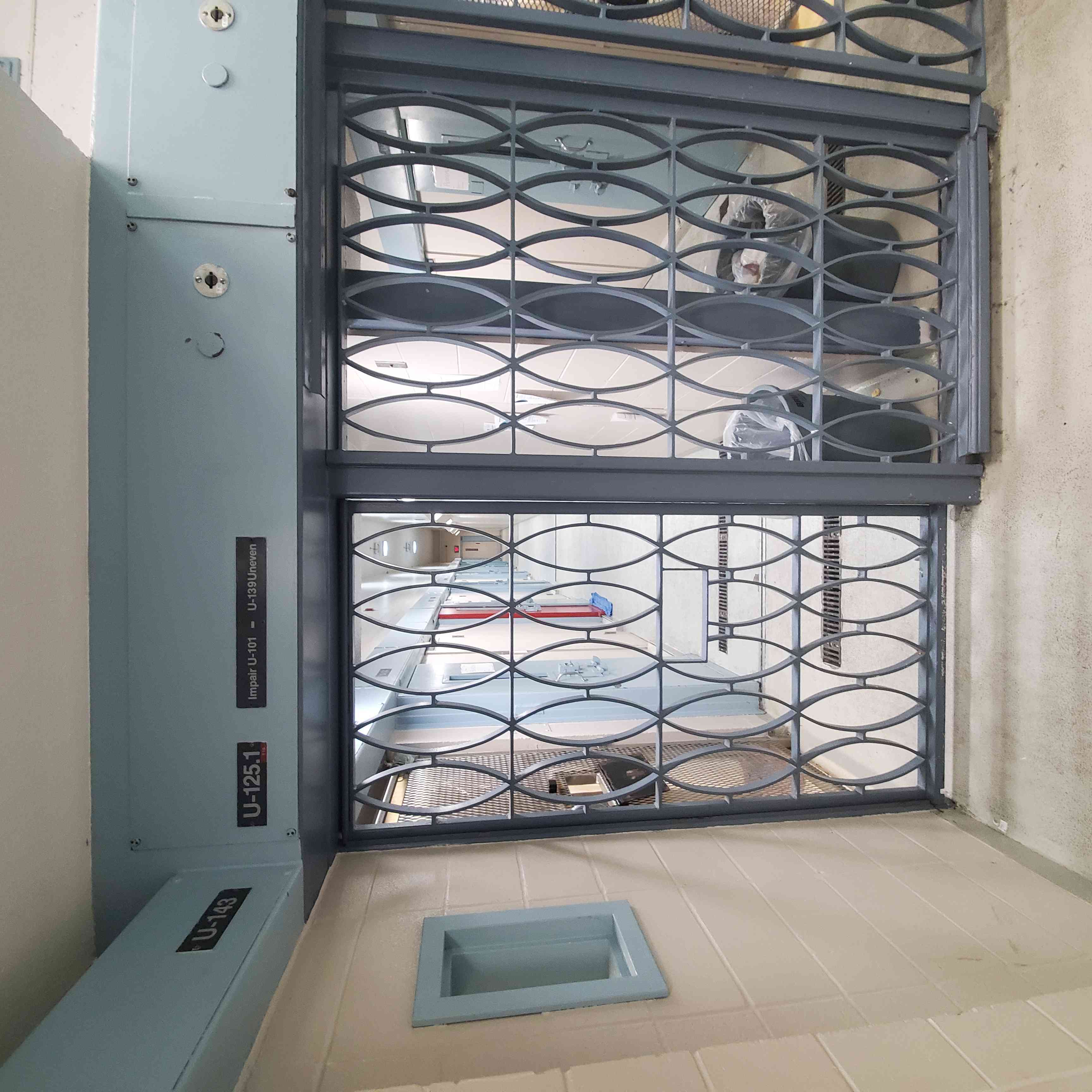
Donnacona Institution – SIU barrier.
The UN’s Standard Minimum Rules for the Treatment of Prisoners (the Mandela Rules) defines solitary confinement as 22 hours or more a day without meaningful human contact. Footnote 69 Currently, the Corrections and Conditional Release Act (CCRA) and the Corrections and Conditional Release Regulations (CCRR) provide general parameters for living conditions within federal penitentiaries, which might inform the quality and quantity of out-of-cell time outside of the SIUs. Two provisions, the “least restrictive measures” principle found under section 4(c) in the CCRA and the protection of human dignity referred to in sections 69 and 70 of the same Act, might be used as guidance. However, the only explicit mention of out-of-cell time enshrined in federal legislation (outside of provisions related to conditions in the SIU [s. 36]) is the 1-hour of daily exercise provided under section 83 (2) (d) of the CCRR.
The CCRA provisions for SIUs create a minimum legal standard of four hours of out-of-cell time. As already stated, though this standard is required by law for SIUs, the Service is not required to apply it to other areas within federal penitentiaries. In fact, during the pandemic, mainstream prisoner populations were routinely kept in their cells for 22 hours or more Footnote 70 , sometimes weeks at a time and for the most part with no access to outdoor exercise.
For the purposes of this investigation, my Office determined that it was reasonable to define restrictive confinement as anything less than four hours a day of out-of-cell time.
Data Collection
My staff reached out to all of the men’s maximum-security facilities and requested their operational routines (for the mainstream prison population and specific living units). Some routines were defined in notes or memos to staff, but most could be found in Standing Orders established under Commissioner’s Directive 566-3: Inmate Movement . Senior Investigators were asked to consult with both prisoners and staff to identify areas within institutions where prisoners might not be receiving four hours a day, out-of-cell. Based on this information, all six standalone maximum-security sites were identified for follow-up investigations and in-person visits: Edmonton Institution, Millhaven Institution, Atlantic Institution, Port Cartier Institution, Kent Institution, and Donnacona Institution.
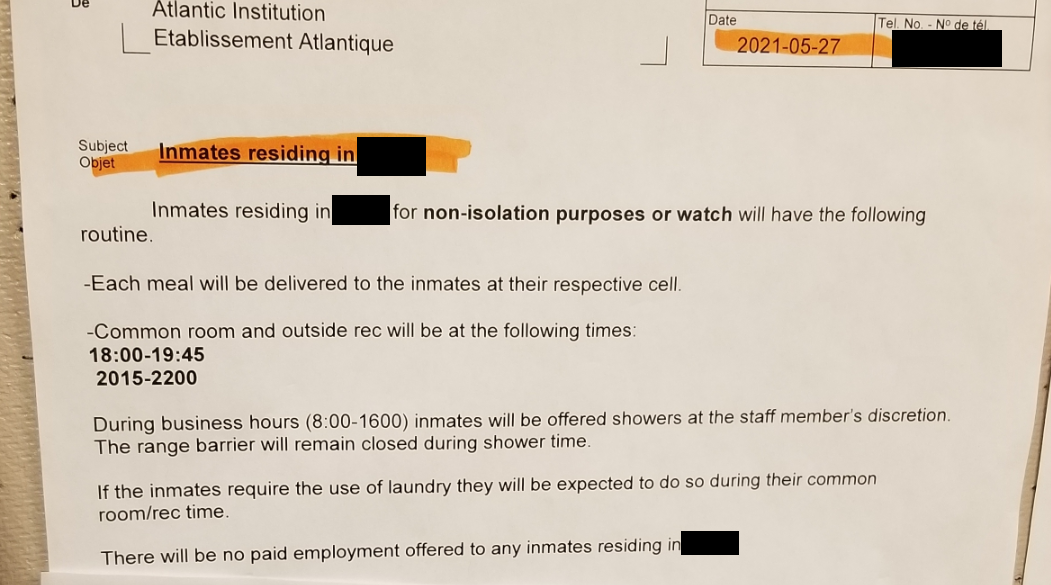
Atlantic Institution – A memo displayed in one of the units
describing the change in routine.
It was not altogether clear from reviewing the operational routines how many hours of out-of-cell time prisoners were receiving. In their application, routines are adapted to accommodate work schedules, programs, visits, the movement of incompatible sub-populations, etc. As will be demonstrated in this report, site visits revealed that institutional routines are used more as general guidelines.
In order to corroborate the operational routines and to better understand the availability of out-of-cell time, logbooks were requested for select units, questionnaires were provided to prisoners and staff, and in-person interviews were conducted. In total, 43 prisoners and more than 30 staff were interviewed between November 2021 and March 2022. Footnote 71
Findings
Limited Time Out-of-Cell
Our investigation revealed a number of areas – outside of SIUs and temporary medical isolation measures in place for COVID-19 – where prisoners were experiencing fewer than four hours of out-of-cell time.

Port Cartier Institution – SIU range.
At one institution, out-of-cell time and conditions of confinement in the regular units and the Therapeutic Range was consistently poorer and below the standards prevailing in the SIU. Indeed, outside the SIU, the rest of the institution operated as if it were a former administrative segregation range, with fewer than three hours of out-of-cell time.
At another institution, the pressure to keep SIU numbers low and an increase in incompatible sub-populations (more on this to follow) resulted in the use of “hidden cells” (a term often used by staff at this facility), where prisoners are kept in solitary confinement- like conditions for weeks on end.
In contrast, during our visit to a third institution we found that staff were using their discretion to allow for more out-of-cell time than was allotted under Standing Order 566-3. Consequently, none of the prisoners that we interviewed at that site complained about out-of-cell time, and they all reported receiving more than four hours a day. One staff member explained the situation as follows:
“If we followed 566-3 to the letter, then we would be far more restrictive. But we leave it to the unit staff’s discretion, so range doors are usually more open to allow all access to the range, fridge, amenities, etc. Normally, there’s no problem.”
Even where prisoners are receiving more than four hours of out-of-cell time, those who are not employed or choose not to participate in programs and scheduled activities tend to spend more time in their cells. Many of these individuals spend their days “locked up,” only to be let out for three hours or less to shower, make telephone calls, or to access laundry facilities, yard, or gym. Even this time is meted out in short intervals, often interrupted by operational requirements such as counts, searches, and other procedures. Some prisoners reported how routines were inconsistently applied, making it difficult to maximize their out-of-cell time. “I never know when it will happen, so it’s difficult to plan!” said one prisoner.
Some of these individuals are willing to participate in programs or are waitlisted for employment, but are locked up because opportunities are scarce or irrelevant to their needs. One prisoner rightly complained, “If guys are genuinely looking for employment or something to do, at least let them out.” Implying that individuals should not be punished for the institution’s own shortcomings.
Quality of Out-of-Cell Time
“There’s nothing to do, the days blend into each other, there’s just nothing. I want to do a program or just do something, but there’s nothing… You just sit in your cell and wait, there’s no way to better yourself, you just sit here and wait. And they wonder why you’re crazy, it’s ‘cause of the way they treat us.”
– From a prisoner interviewee

Edmonton Institution – Mini Yard.
Many of the prisoners we interviewed reported that they and others choose to remain in their cells even when offered out-of-cell time. They provided a number of reasons why they choose not to avail themselves of out-of-cell time, including:
Meaningful off-range activities are limited or unappealing. No programs, no gainful work opportunities, and access to education is restricted to cell studies.
Out-of-cell time is restricted to the range behind locked barriers, so prisoners are just pacing back-and-forth with their cell doors open.
Common areas, recreation spaces, and yards are often uninviting and austere. Access to the main yard or gymnasium is often limited, short in duration, and prisoners often complain that there is nothing to do.
Meals are commonly taken in cells or in the common rooms. Some individuals prefer to stay in their cells rather than interact with others in the common room.
A number of justifiable factors were found to affect the availability and quality of out-of-cell time such as staffing shortages, bad weather, derelict infrastructure, unanticipated lockdowns, the presence of incompatibles, and the normalization of restrictive pandemic measures. However, some reasons were less excusable, such as staff delaying out-of-cell time and then cutting it short to allow themselves longer breaks.
As per section 4 (c.2) of the CCRA , the Service assists in rehabilitating individuals and reintegrating them into society as law-abiding citizens by ensuring “the effective delivery of programs to offenders, including correctional, educational, vocational training and volunteer programs, with a view to improving access to alternatives to custody in a penitentiary and to promoting rehabilitation.” The application of this principle is not contingent upon institutional security level. Yet, as the Table 1 shows, only 61.1% of prisoners at the standalone maximums were employed as of May 2022. Donnacona Institution had the lowest employment (41.6%), while Edmonton Institution had the highest (87.1%). However, 80.2% of work assignments at Edmonton Institution were cleaning jobs. In fact, almost half of all work assignments at the standalone maximum-security institutions were cleaning positions. Other common jobs included dishwashers, food preparation work, general labourers Footnote 72 , and inmate committees. In the context of maximum-security prisons, these positions can hardly be considered gainful or to increase vocational skills and capacities that would help a person succeed in the community.
Table 1. Work Assignments Footnote 73 at Standalone Maximum-Security Institutions.
| VOCATION | ATLANTIC | DONNACONA
| PORT CARTIER
| MILLHAVEN
| EDMONTON
| KENT
| TOTAL
|
| Cook | – | 1 | 14 | – | – | – | 15 |
| Dishwasher | – | 1 | 3 | 49 | – | – | 53 |
| Care Giver | – | – | 4 | – | – | – | 4 |
| Cleaner | 56 | 45 | 52 | 41 | 174 | 7 | 375 |
| Corcan Metal Worker | – | 4 | – | – | – | – | 4 |
| Corcan Textile | – | – | 4 | 2 | – | – | 6 |
| Corcan Upholsterer | 4 | – | - | - | – | – | 4 |
| Ethnocultural | – | – | 1 | - | – | – | 1 |
| Food Services | 1 | – | – | 1 | 1 | 11 | 14 |
| Admin Clerk | 2 | 2 | 1 | – | – | 20 | 25 |
| Admin Library | 2 | – | 2 | 2 | – | 2 | 8 |
| Admin Other | – | 5 | – | – | – | – | 5 |
| Barber | – | 13 | 1 | 15 | 1 | 6 | 36 |
| Inmate Canteen | 2 | 6 | 2 | 6 | – | – | 16 |
| Inmate Committee | 12 | 1 | – | 9 | 1 | 16 | 39 |
| Recreation | – | – | – | 1 | – | 5 | 6 |
| Laundry | – | 1 | 11 | 12 | – | 2 | 26 |
| Food Prep Work | 22 | 13 | 10 | 3 | – | – | 48 |
| General Labourer | 3 | – | – | 1 | 1 | 35 | 40 |
| Peer Coordinator | – | 10 | 1 | – | 2 | 12 | 25 |
| Photographer | – | – | – | – | – | 2 | 2 |
| Prisoners’ Advocate | – | – | – | – | – | 1 | 1 |
| Range/Unit Rep | – | – | 8 | – | – | – | 8 |
| Recreation Work | 1 | 2 | 4 | 3 | – | – | 10 |
| Recycling | 1 | – | – | – | – | 3 | 4 |
| Spirit/Cultural Services | – | 1 | 1 | – | 12 | – | 14 |
| Stores | – | – | – | – | – | 5 | 5 |
| Tutor | – | – | – | 4 | – | – | 4 |
| Total Work Assignments | 106 | 105 | 119 | 149 | 192 | 127 | 798 |
| Total Prisoners Employed | 99 | 89 | 116 | 116 | 189 | 1116 | 725 |
| Total Prisoners In-Custody* | 141 | 214 | 190 | 195 | 217 | 230 | 1,187 |
| % of Prisoners Employed | 70.2 | 41.6 | 61.1 | 59.5 | 87.1 | 50.4 | 61.1 |
| Institution’s Bed Capacity | 301 | 451 | 237 | 340 | 300 | 378 | 2,007 |
Source: CSC Data Warehouse (May 2022).
*Year-to-date. May differ from custody populations for the date when employment numbers were extracted.
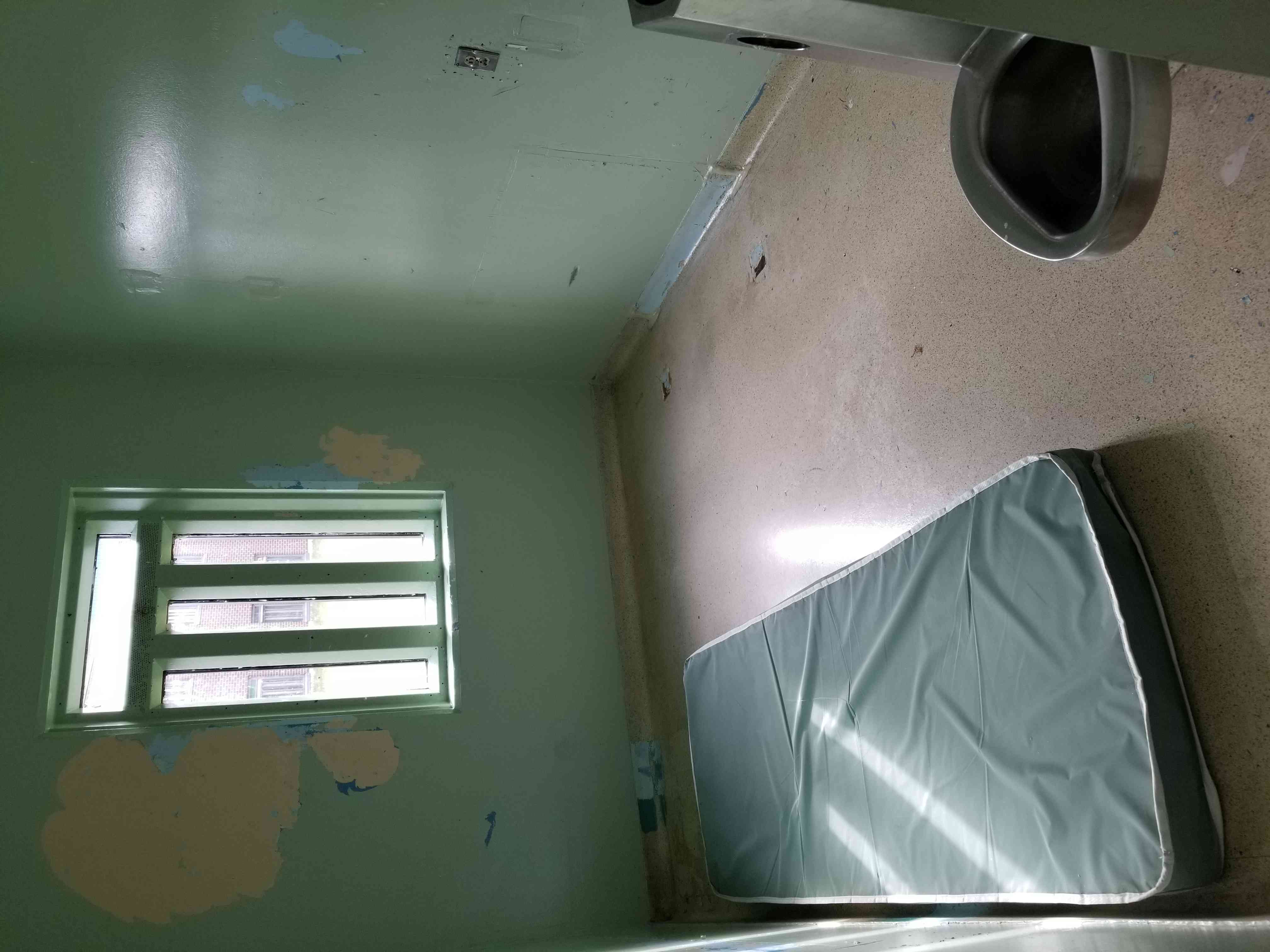
Atlantic Institution – A camera cell.
On numerous occasions, prisoners reported that they had absolutely nothing to do. Employment was scarce or unappealing and core-programs were simply unavailable due to staffing shortages or COVID-19-related restrictions. One unit representative described the situation on his unit occupied by only him and another prisoner: “We’re both medium. Been charge free for a year… literally stuck on the range. No movement, don’t get to work off range, applied for programs, applied to do this and that, no access.” Another prisoner expressed his frustration with how programs were assigned: “They force programs on people when they’re not ready or close to a transfer, but when the time comes when a program is needed, they don’t have it. Force guys who don’t want a program into a program, and guys who want programs don’t get access.”
Today, male maximum-security prisons are operating at around 60% capacity with a staff to prisoner ration of 1:1 or higher. There seems to be no excuse for further depriving individuals of quality activities such as organized sports, well-equipped weight rooms, traditional cooking, kitchen management jobs, communal meals, cultural activities led by community-based organizations, meaningful work experiences, education, and other meaningful opportunities.

Kent Institution (exterior)
In my experience, when the conditions of confinement and the quality of life improves behind bars, we also tend to see better use of dynamic security, greater trust and confidence among prisoners, fewer complaints, and better rapport with staff. Of course, every now and then an incident occurs. These events can be used to justify stripping prison environments down to the bare necessities of life, but they should not. These deprivations can only serve to further dehumanize those in custody, which has cascading effects on mental health, socialization, incidents, and feelings of hopelessness and despair. “Tightening the screws” often leads to dysfunction, staff morale problems, a rise in incidents, and is counterproductive to rehabilitation or safe and timely reintegration.
Growth in Sub-Populations

Edmonton Institution – Entrance to the therapeutic ranges (taken in 2019).
Under section 17 of Commissioner’s Directive 568-7: Incompatible Offenders (revised version promulgated on August 23, 2021), staff are required to consider “various risk management options” for “unresolved incompatibles.”
These “risk management options” sometimes result in additional restrictions for prisoners, as institutional routines have to be adapted in order to manage the movement and interaction of those deemed “incompatible.” As a result, sub-populations are created that may consist of one or more individuals.
At two institutions, the growth of sub-populations increased significantly during the pandemic to over a dozen (from four or five in 2019). The growth of sub-populations at these facilities not only limits out-of-cell time, but also restricts the movement of individuals “off range.” At one institution in particular, the inordinate number of sub-populations rendered nearly all group movement impossible. At another institution, staff reported an increase in incidents related to assaults, disruptive behaviours, and self-injury including suicide attempts following the elimination of administrative segregation, leading to a further increase in sub-populations. When I asked my staff to verify this claim, we found that the total number of such incidents increased by 117% in the one-year period between November 2019 and November 2020.
Although the exact cause of the increase in sub-populations is difficult to pinpoint, there is some evidence to suggest that it involves a combination of the following:
Elimination of administrative segregation;
Pressure to keep SIU numbers low; and,
Introduction of pandemic lockdown measures, including restrictions on transfers and limited options for cascading to lower security levels.
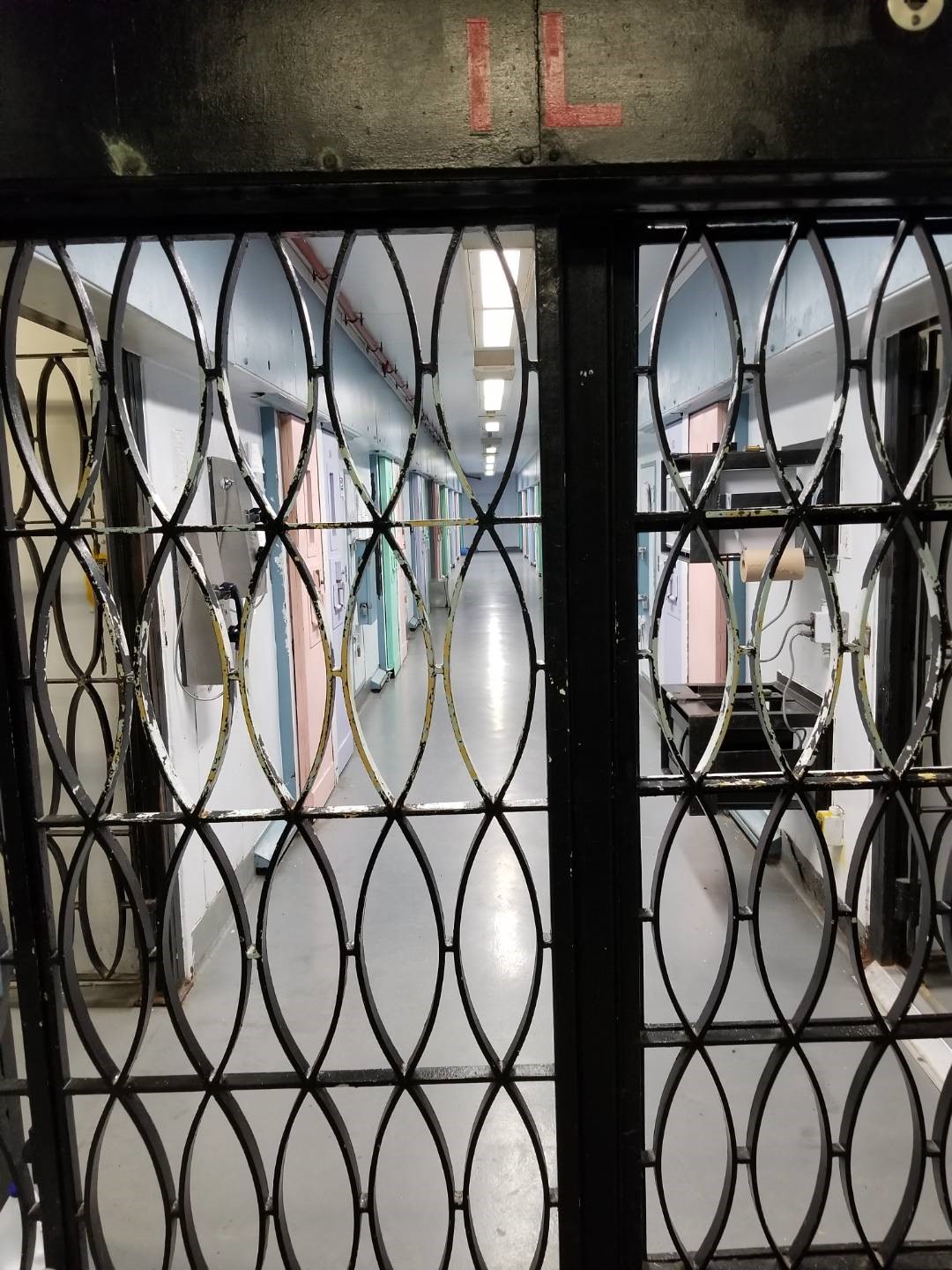
Millhaven Institution – Behind range barriers.
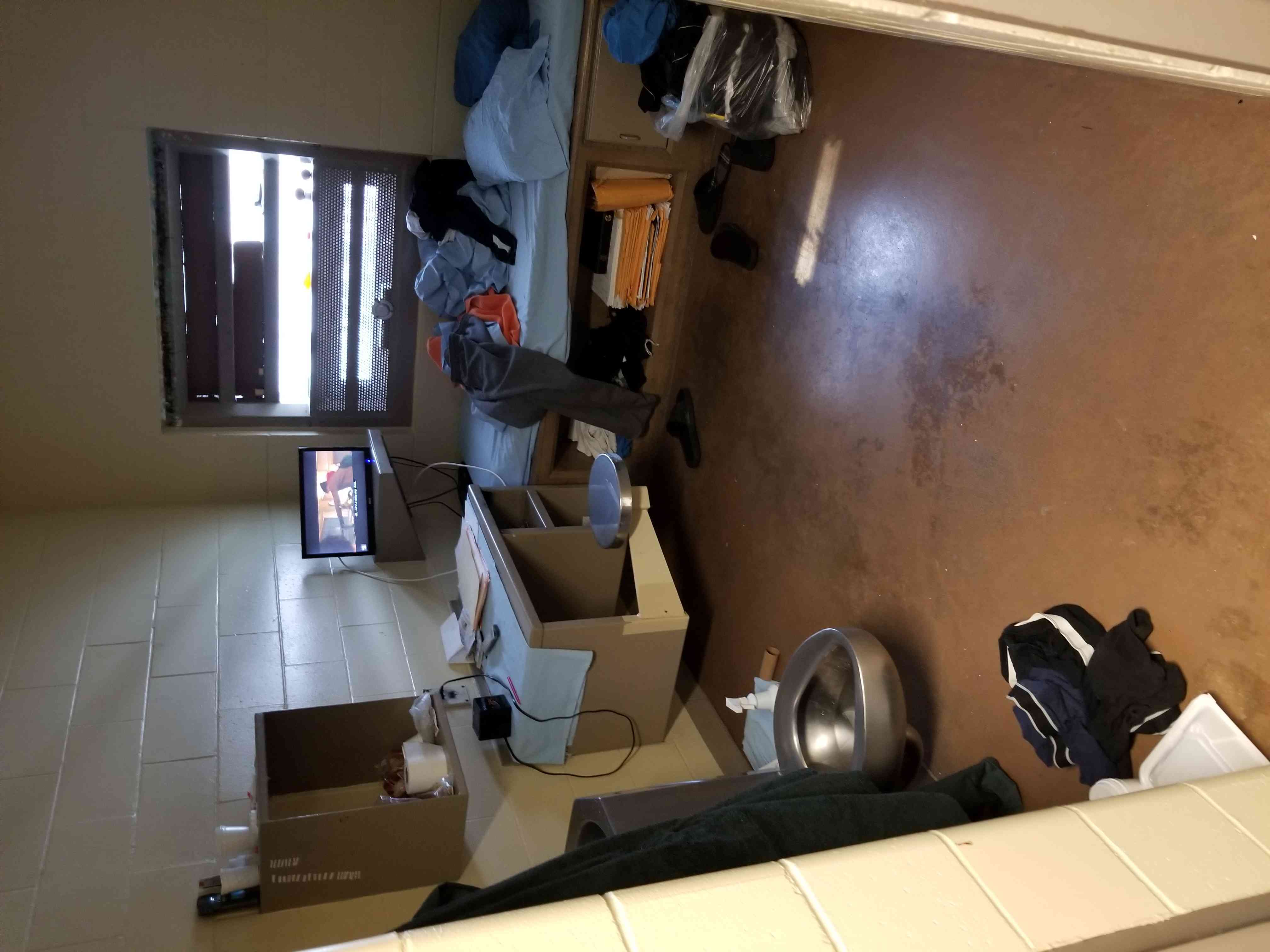
Kent Institution – Occupied SIU cell.
As described in the 2020-21 Annual Report, many prisoners continue to demand SIU placements to secure better conditions of confinement, relative safety, and personal space at maximum-security facilities. Some go so far as to threaten or commit violent acts, self-harm, or behave disruptively in order to secure an SIU placement (or to be maintained there).
To avoid placing prisoners in the SIUs the Service has directed its regions to keep their SIU numbers low. As one staff member put it, “You have to sacrifice a goat to place guys in the SIU!” As a result, most SIUs are at or below half capacity. CSC claims that this is due to a “shift in mindset on the part of both staff and inmates,” perhaps implying a change in culture that is less reliant on segregation. Footnote 74 However, our findings suggest that the low SIU numbers only tell part of the story as institutions are increasingly using stopgap measures (such as sub-populations and segregation-like alternatives) to isolate, contain, and control prisoner movement.
This is the context within which out-of-cell time must be understood. The unmanageable and growing number of sub-populations, reluctance to place individuals in SIUs, and (at some locations) the increasing number of incidents, means that prisoners are often confined to their cells or ranges for extended periods. The situation is especially problematic for individuals who need to cascade to lower levels of security, or can no longer be safely placed in one of the existing populations.
Cascading for Medium-Security Prisoners
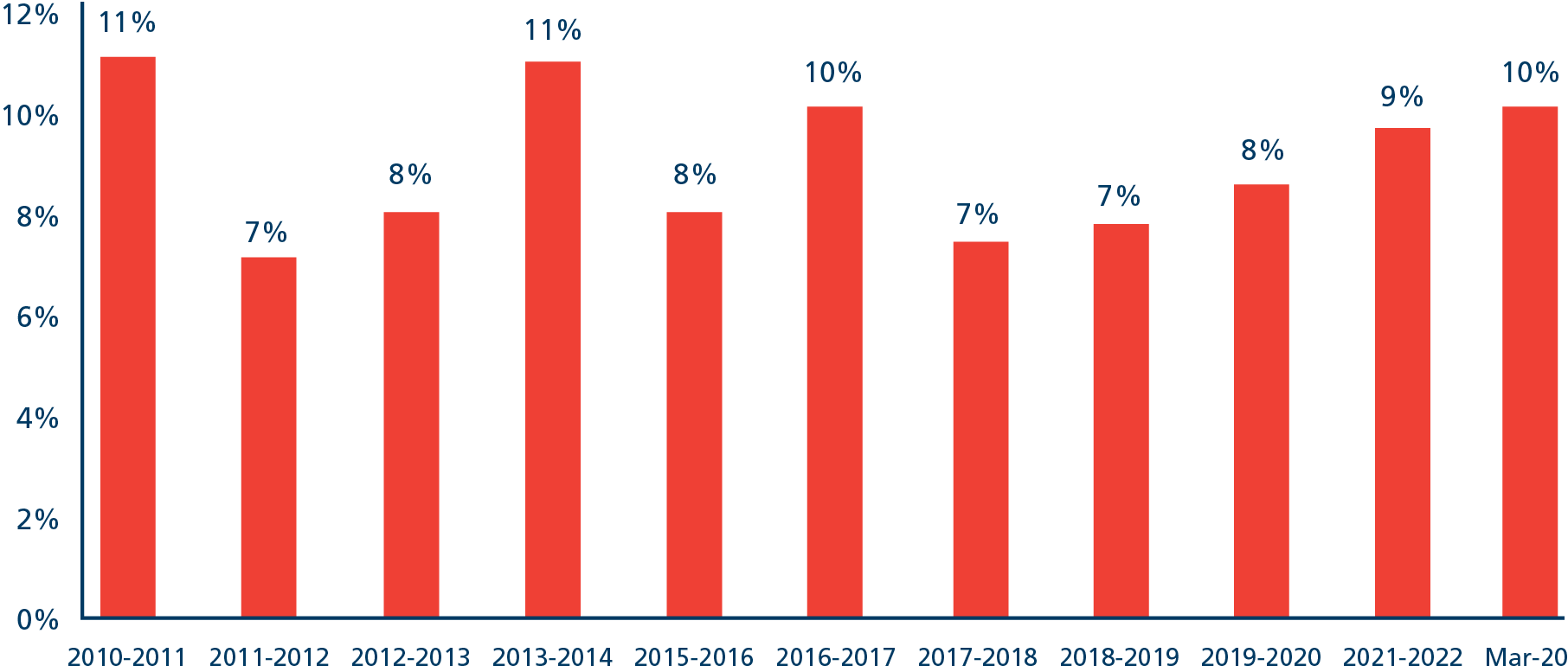
Graph 1. Percentage of Medium-Security Prisoners
in Federal Maximum-Security Institutions.
Data collected by the OCI in February 2022 shows that at almost all the standalone maximum-security institutions, roughly 10% to 15% of prisoners had a medium-security classification. Of course, restrictions on transfers during the pandemic contributed to the retention of medium-security prisoners at maximum-security facilities over the past two years; however, these proportions reflect norms from the past decade (see Graph 1). Regardless, confining a medium-security prisoner in a maximum-security institution is overly restrictive, and warranted further investigation.
Note: This data only includes standalone maximum-security facilities: Atlantic, Donnacona, Port Cartier, Millhaven, Edmonton, Kent, and Kingston Penitentiary (prior to 2013). These are facilities where cascading to lower levels of security is not possible within the institution, such as occurs in the multi-level facilities.
When asked why medium-security prisoners were not being cascaded to lower security institutions, staff cited a number of reasons such as comfort with routines, institutionalization, fear of change, and/or preference for segregated housing. One senior staff member said that medium-security prisoners “prefer the separate populations. You don’t have to integrate with the whole site,” which is the case at medium-security facilities. Another staff member talked about lifers and prisoners under the two-year rule Footnote 75 , “they come in here and don’t see light at the end of the tunnel, ‘why bother?’ they say. So they don’t want to transfer.”
At some institutions, staff reported that engagement with medium-security prisoners and case management reviews are ongoing to encourage cascading.
Idling in maximum security

Donnacona Institution – Prisoner telephone.
“[It’s] like a warehouse.”
“It’s a time-out prison.”
“You’re just sitting on ice until you leave.”
Some prisoners interviewed during site visits expressed these sentiments. They reported that their time spent in maximum security is mostly idle; jobs and programs are not preparing them for release, and they are not acquiring any useful skills. However, they were not surprised, and often declared that, after all, “This is a max!”
It is important to raise a general point about the attitude of many CSC staff toward maximum-security prisons. We frequently heard staff express “Inmates shouldn’t want to be here,” implying that maximum-security prisons should be inhospitable. In addition, placements at these facilities are often temporary, e.g., those being held under the mandatory two-year rule Footnote 76 or increased Offender Security Levels resulting from incidents at lower security institutions.
Despite the fact that CSC’s own criminological underpinnings require those with higher risk and need to receive a higher “dosage” of services and interventions, at some sites the correctional culture is resistant to making maximum-security placements more productive.
Creation of Segregation-Like Environments
The elimination of segregation through Bill C-83 limited the availability of cells that staff could use for the temporary separation of prisoners. The newly introduced SIUs guaranteed basic entitlements through legislation, which appealed to many maximum-security prisoners who found their conditions of confinement intolerable. The demand for voluntary SIU placements increased, but so did the pressure to keep SIU numbers low. At one institution, staff reported that the number of incidents increased due to prisoners “acting out” in order to be placed or retained in the SIU. Data obtained by my office confirmed these claims.
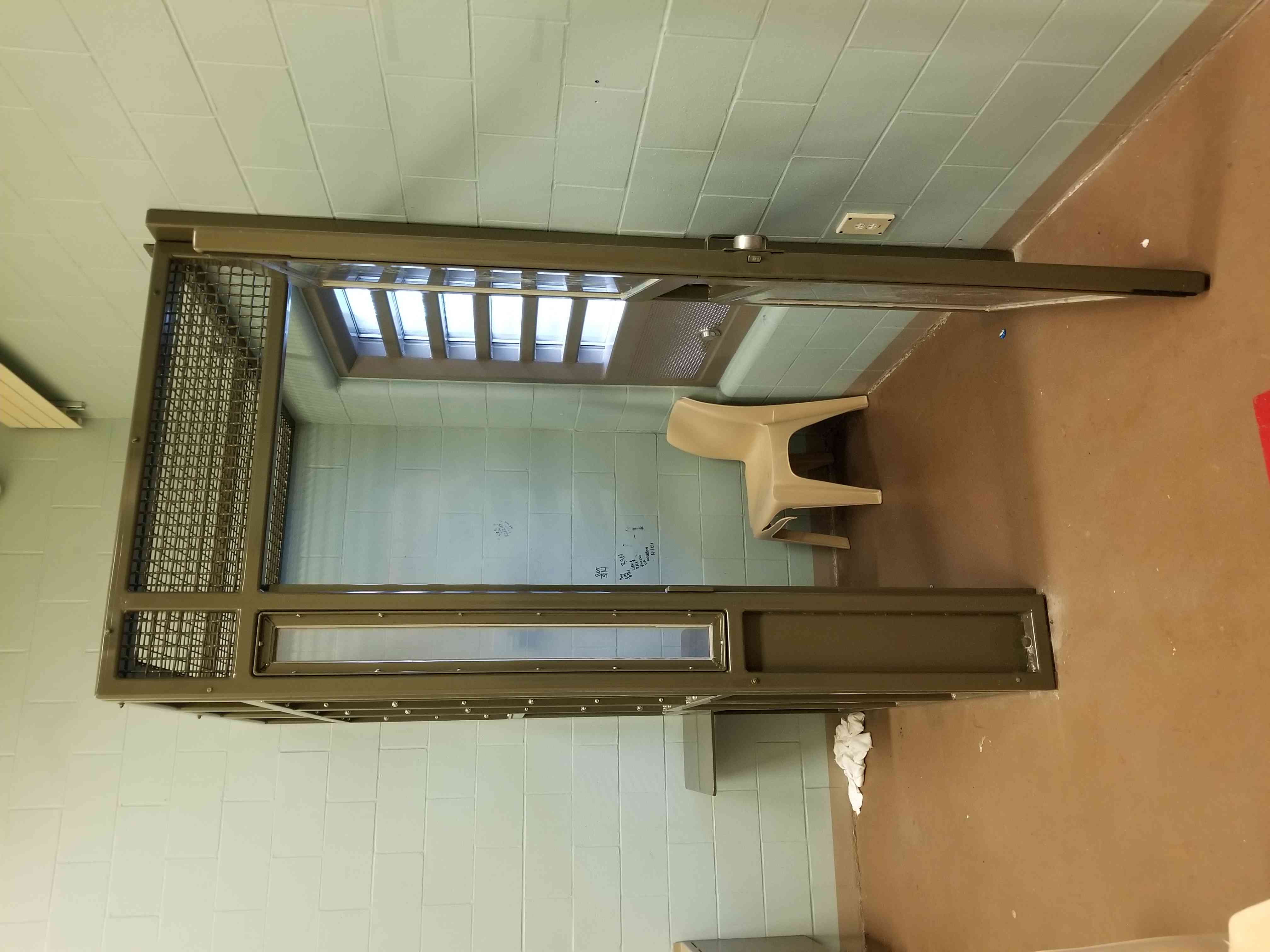
Kent Institution – Non-contact enclosure.

Kent Institution – Non-contact enclosure.
Concurrent with the implementation of SIUs, federal institutions have had to find stopgap measures to, on the one hand, segregate, contain, and control “difficult inmates”; and on the other hand, to provide safe custody for individuals at risk in the mainstream prison population. Below we discuss one such measure: Voluntary Limited Association Ranges.
Voluntary Limited Association Ranges
Our office identified a Voluntary Limited Association Range (VLAR) at each of the six standalone maximum-security penitentiaries. A single day snapshot from March 4, 2022, showed a total VLAR population of 83. These were more-or-less equally divided between the six institutions with Donnacona Institution housing the lowest (8) and Kent the highest (20). Of the total, 45 VLAR prisoners were White (54.2%), 23 were Indigenous (27.7%), 12 were Black (14.5%), and three were from other visible minorities. Thirty individuals (36.1%) held in VLARs at this time had indeterminate sentences. Footnote 77
According to a memo dated June 4, 2019, Footnote 78 from CSC’s Assistant Commissioner, Correctional Operations and Programs, the VLARs “are for inmates who do not want to integrate in mainstream inmate populations and who do not meet the criteria for placement in administrative segregation.” The memo goes on to say that VLAR prisoners “will be provided a similar routine and similar conditions of confinement to other inmates in the mainstream population at the institution.”
Five months later, SIUs replaced segregation units and the VLARs began to receive voluntary placements who did not meet the admission criteria for SIUs and refused to integrate with the mainstream population. In theory, VLAR prisoners must work toward integration. Therefore, association with one of the existing prisoner populations must be a possibility so that they can be integrated when ready.
Staff characterized the individuals residing in the VLARs, as:
Those who show signs of institutionalization or are afraid of integration, even if they could do so safely.
Those who have already integrated, but are approaching their release. These individuals sometimes ask to be transferred to the SIU and to remain there until their release. This is either due to the fact that they owe debts or because they are afraid of committing acts that could hinder their release.
Those who require protective custody.
Prisoners classified as medium security sometimes prefer to stay at maximum-security institutions because they wish to enjoy the (perceived) privacy and protection afforded by the VLAR. As one prisoner explained, “If I knew about the VLAR, I would have gone there long ago.” The VLAR allows prisoners to mostly keep to themselves, separated from the mainstream population. This is often not an option at medium-security institutions where prisoners share large open living spaces.
As per policy, the provision of out-of-cell time on the VLARs should reflect that of the mainstream prisoner population. Therefore, the more restrictive the general conditions of confinement at the institution, the more restrictive would be the conditions in the VLAR. We also observed that VLAR prisoners are virtually always restricted to their range. Off-range activities are rare for this population, especially at sites with many sub-populations where prisoner movement is difficult.
During one of my personal visits to a VLAR, I noted that the conditions of confinement were far worse than in the SIU. It was explained to me that each day the VLAR prisoners are offered a shower, one phone call, one hour of yard time, and a chance to do activities with an assigned compatible mainstream range. I reviewed the paper logs for the previous two days – all the prisoners refused to join the assigned range for out-of-cell activities. This would suggest that they had received fewer than two hours of out-of-cell time for each of those days. This is unacceptable and contrary to law. The lack of a policy for the use of VLAR creates inconsistency and does not ensure the rights of prisoners are respected.
- I recommend that CSC immediately develop national policy for the use of Voluntary Limited Association Ranges (VLARs) and any other sub-population living unit or range that clearly identifies:
The grounds for placement outside of general population.
The legal processes that define the extent to which rights, freedoms and privileges can be restricted, including association, programs and services provided, and out-of-cell time.
The rights, privileges and conditions of confinement which they should be afforded.
The degree of review (monitoring) required to facilitate the return of the incarcerated persons to a less restrictive correctional environment, including the measures which should be taken to permit release to general population as soon as possible.
Ten Years since Spirit Matters: Indigenous Issues in Federal Corrections (Part I)*
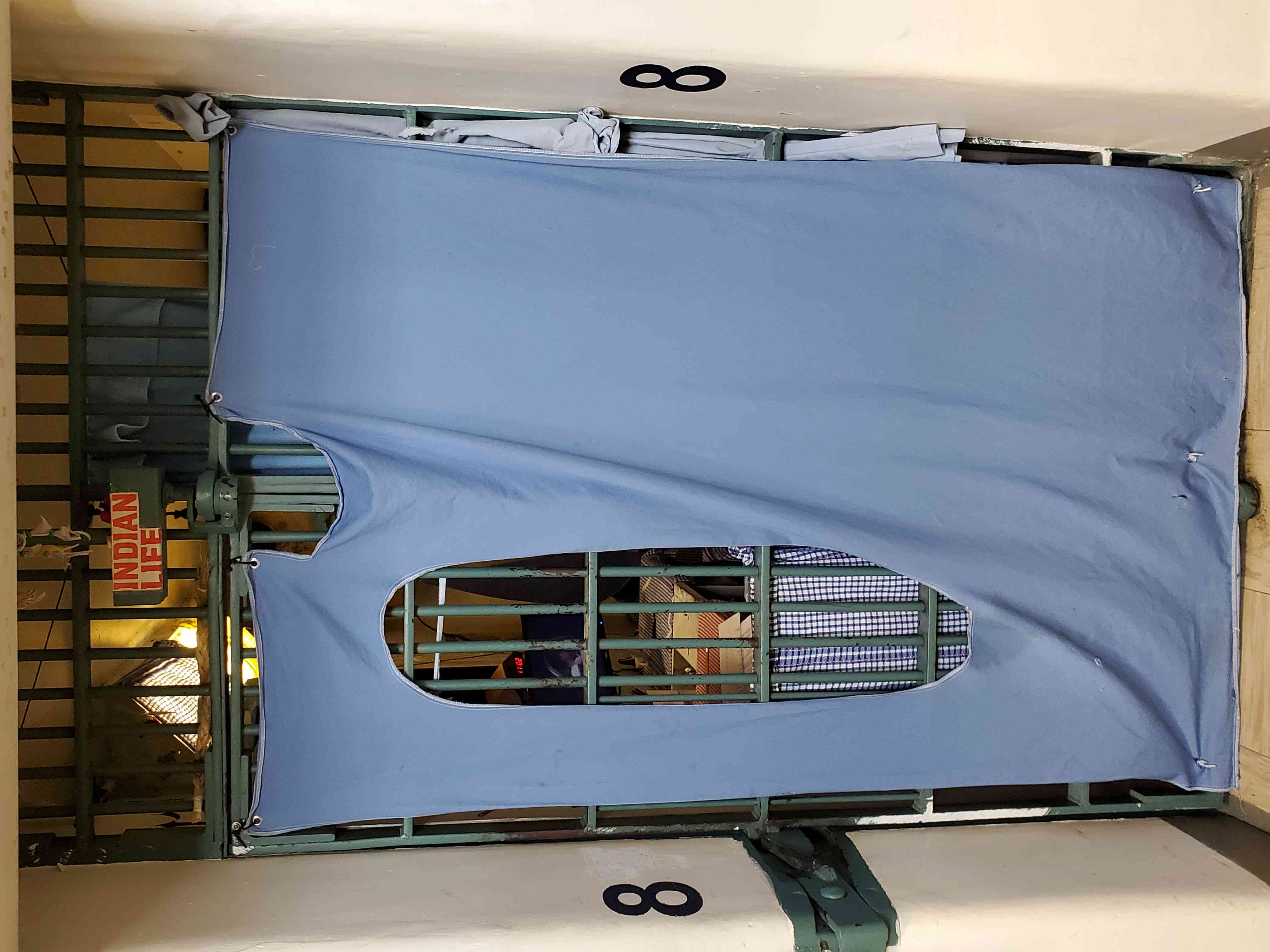
Stony Mountain Institution – Pathways unit cell.
*Part II of this national investigation will be completed during FY 2022-23 and include interviews of incarcerated and paroled Indigenous people and CSC staff, and on-site visits.
The mistreatment of Indigenous Peoples has been a long-standing blight on Canadian history, and by extension, Canadian corrections. A system that has been referred to by some as the new residential school system, corrections has become emblematic of modern neocolonialism and a microcosm for broader social ills. Footnote 79 It is true that the prison system is often blamed for, and inherits, the failures of other social institutions. While not solely responsible for who enters its doors, correctional agencies hold considerable power over how (and to whom) justice is administered behind bars, which to a large extent, dictates the composition of the correctional landscape. Moreover, correctional authorities have always had significant control over the prevailing cultural ethos of how prisons are run, who runs them, and where resources and priorities are allocated and determined. All of these realities have served to preserve the prison system as the inherently colonial institution that it has always been, despite some attempts to improve it. At an instrumental level, the federal prison system, which predates Confederation, has long served to keep Indigenous Peoples marginalized, over-criminalized, and over-incarcerated.
The inequities and disparate outcomes experienced by Indigenous Peoples under federal sentence in Canada has been a key priority and concern for this Office since its inception. Nearly 50 years ago, in the very first annual report issued by the Office in July of 1974, the discriminatory treatment of Indigenous persons in federal custody was among the inaugural set of issues raised. In the decades to follow, this Office has issued more than 70 recommendations specific to Indigenous corrections, by way of our annual reports. In 2013, the Office’s Special Report on Indigenous corrections entitled, “ Spirit Matters: Aboriginal People and the Corrections and Conditional Release Act ,” was tabled in Parliament. Twenty years out from the introduction of the CCRA in 1992, Spirit Matters sought to investigate the extent to which federal corrections had fulfilled parliament’s intent with respect to legislative provisions, with a specific focus on sections 81 (Healing Lodges managed by Indigenous communities) and 84 (Indigenous community release and reintegration planning) of the CCRA. Footnote 80 The findings from this investigation revealed numerous and significant gaps. Together, recommendations stemming from Spirit Matters and OCI annual reports on Indigenous corrections have covered numerous topics, focusing largely on the need for change in the following key areas:
Expansion of section 81 Healing Lodges (managed by Indigenous communities);
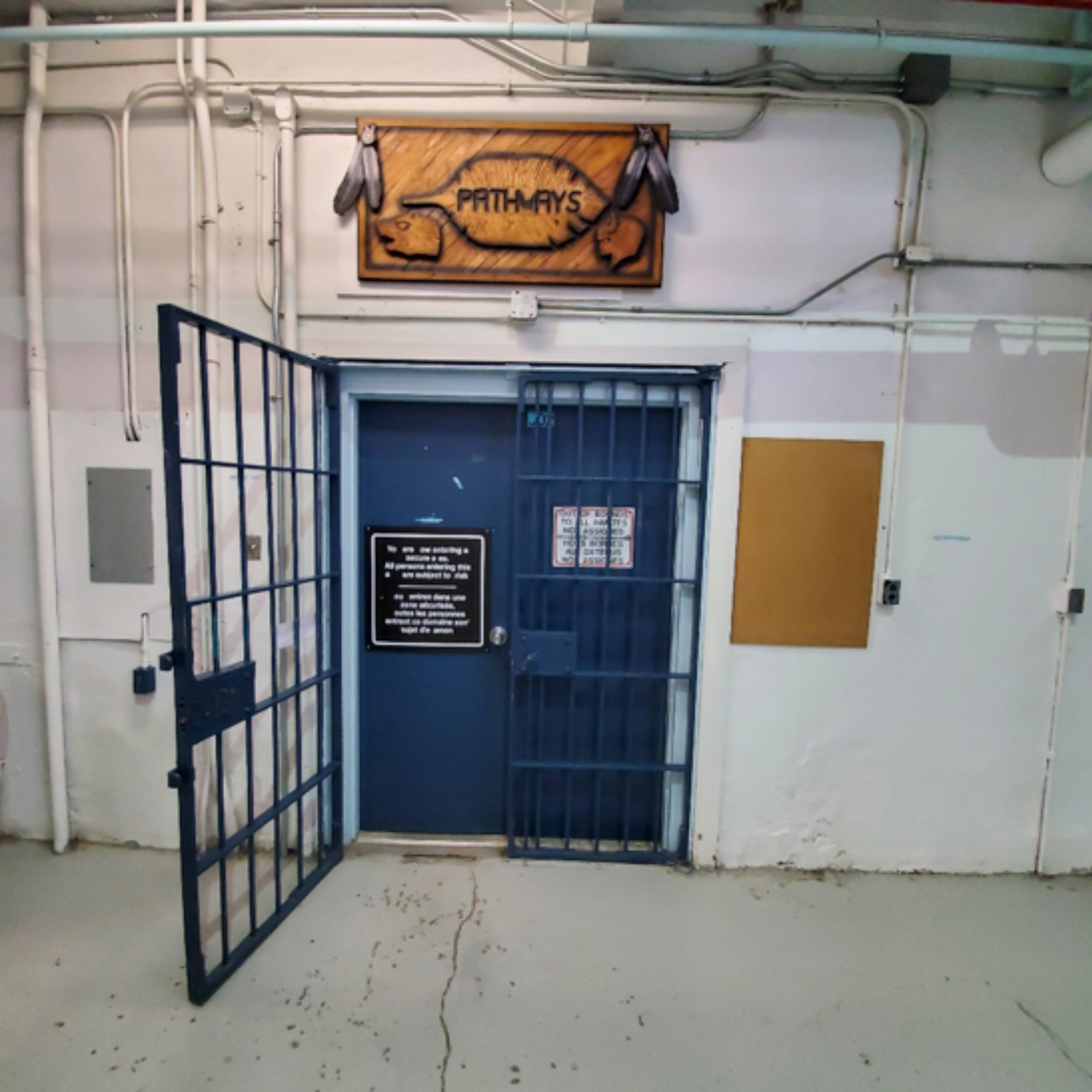
Saskatchewan Penitentiary – Pathways Unit.
Increasing the use, and facilitating the process, of section 84 releases;
Increasing Indigenous leadership (i.e., the appointment of a Deputy Commissioner of Indigenous Corrections);
Improving the timely release and reintegration of Indigenous Peoples;
More intentional and transparent analysis and public reporting on the impacts of correctional decision-making on Indigenous populations;
Increasing the allocation of resources and involvement of Indigenous communities and organizations in correctional decision-making and administration;
Improving custodial and community-based programming to address the needs of Indigenous Peoples;
Increasing the use of Gladue /Indigenous Social History factors to inform decision-making, assessment, and classification;
Resolving the recurring issues faced by Indigenous Elders;
Increasing the number of Indigenous employees and providing greater training for existing staff on Indigenous culture, history, and spirituality; and,
Developing a gang disaffiliation strategy, with a focus on Indigenous gangs.
In the years since Spirit Matters , there have been a number of commissions, inquiries, unprecedented pieces of investigative journalism, and parliamentary committee studies conducted on the needs and experiences of incarcerated Indigenous individuals. The reports stemming from most of these initiatives have issued specific recommendations and calls-to-action, many of which have been directed at federal corrections. Concerns raised in each of these reports by-and-large echo many of those made by this Office, and some (e.g., MMIWG Final Report: Reclaiming Power and Place ) have fully endorsed and reissued Office recommendations on Indigenous corrections, often verbatim. Specifically, considerable overlap in recommendations exist in the calls-for-change in the following four areas:
- Increasing the use of Healing Lodges, section 84 releases, and engagement with Indigenous communities;
- More and higher-quality culturally-informed programming;
- Improvements to screening, assessment, and classification tools; and,
- More Indigenous leadership, employee representation, and cultural competence among all staff.
Key Reports on Indigenous issues in the Correctional System since Spirit Matters (2013)
- Office of the Correctional Investigator – Spirit Matters: Aboriginal People and the Corrections and Conditional Release Act (2013)
Truth and Reconciliation Commission – Final Report: Honouring the Truth, Reconciling for the Future (2015)
Office of the Auditor General – Fall Report: Preparing Indigenous Offenders for Release (2016)
House of Commons Standing Committees on Public Safety and National Security (SECU) – Study: Indigenous inmates in the federal correctional system (2017)
House of Commons Standing Committee on the Status of Women (FEWO) – Study: Indigenous Women in the Federal Justice and Correctional Systems (2017)
National Inquiry into Missing and Murdered Indigenous Women and Girls (NIMMIWG) – Final Report: Reclaiming Power and Place (2020)
Ten Years since Spirit Matters
Indigenous Over-representation in Federal Corrections
Over the last thirty years in particular, some efforts have been made to bring greater equity to Indigenous Peoples who enter the correctional system, such as the introduction of the Corrections and Conditional Release Act (sections 79 to 84) and changes to the Criminal Code (e.g., s.718.2 [e]). In federal corrections, systemic efforts to “decolonize” prisons largely started in 2003 with the introduction of the Aboriginal Continuum of Care model. Despite the various changes, inquiries, plans, and investments, by many metrics, the various efforts have fallen disappointingly short of their goals of addressing systemic discrimination and the over-representation of Indigenous Peoples in the correctional system. While we have seen overall declines in the incarcerated population in recent years, Indigenous over-representation has not only persisted but increased at an unabated pace. Since 2012, the federally incarcerated population decreased by 16.5% and the in-custody population of White individuals decreased by 23.5%; however, during the same time, the Indigenous custodial population increased by 22.5%. Footnote 81 Over the last decade alone, the total Indigenous offender population (incarcerated and community) has increased by 40.8%. Footnote 82
In January 2016, my Office reported that the proportion of Indigenous Peoples in federal custody had reached an all-time high of 25%, and cautioned that this trend would continue, without significant intervention. Over the last two years, federal corrections reached two new historic milestones when the proportion passed the 30% mark overall, and approached 50% for incarcerated Indigenous women. Footnote 83 Today, despite accounting for approximately 5% of the adult population, Indigenous Peoples continue to be vastly overrepresented in the federal correctional system, accounting for 28% of all federally sentenced individuals and nearly one third (32%) of all individuals in custody.
Prison Health and Outcomes

Graph 1. Proportion of Indigenous and non-Indigenous
in-custody Population since 2012 Footnote 84While the worsening over-representation and deepening Indigenization of the correctional system alone serves as a grim litmus test for progress, a wide range of prison health indicators and outcomes similarly provide further evidence of the troubling trajectory of Indigenous corrections. For example, as of the writing of this report, Indigenous Peoples in federal prison continued to be overrepresented in the following areas:
Custodial settings, compared to community supervision (68.3% of Indigenous Peoples are in custody versus 54.8% of non-Indigenous individuals);
Uses of force (Indigenous individuals accounted for 39% of those involved in a use-of-force incidents over the last five years);
Maximum security (38% of individuals in maximum security are Indigenous);
Structured Interventions Units (formerly segregation, nearly 50% of individuals in SIUs are Indigenous);
Security Threat Group affiliations (the proportion of Indigenous individuals with an STG affiliation is twice that of non-Indigenous individuals in custody i.e., 22% vs. 9%) Footnote 85 ;
Self-injury incidents (55% of all incidents of self-injury involved an Indigenous person);
Attempted suicide incidents (40% of attempted suicides over last decade); and,
Suicides (83% [5 out of 6] of all incarcerated individuals whose death occurred by suicide in 2020/21 were Indigenous). Footnote 86
Furthermore, Indigenous individuals are increasingly entering the system at a younger age, Footnote 87 spending considerably longer behind bars, and returning to federal corrections at unprecedented rates compared to their non-Indigenous counterparts. Specifically, Indigenous Peoples continue to serve higher proportions of their sentences compared to non-Indigenous individuals before being released on day or full parole and receive a very low proportion of conditional releases, with statutory release being by far the most likely release type. Footnote 88 In 2020/21, 75% of releases for Indigenous offenders were statutory releases. Footnote 89 As for post-release outcomes, Indigenous men have the highest rates of recidivism than any other group (65% for any re-offence, with rates of 70%+ in the Prairie region) and nearly half of all Indigenous admissions to federal corrections last year were for revocations. Footnote 90 Footnote 91 Individually, and taken together, these indicators clearly show that Canadian corrections is, and has been for some time, at a point of perpetual crisis. Year over year, prisons are increasingly being filled by Indigenous Peoples who are caught up in the proverbial revolving door, experiencing worse circumstances while inside, with few viable options for getting out and staying out.
CSC Progress on Recommendations

Willow Cree Healing Lodge – Exterior.
While largely unresponsive to recommendations put forward by this Office and others, in the years since Spirit Matters , CSC has developed no shortage of plans and initiatives for Indigenous corrections. Mainly by way of the Aboriginal Continuity of Care Model (2003), Strategic Plan for Aboriginal Corrections in 2006 (followed by its “renewal” in 2013), and later the National Indigenous Plan – A National Framework to Transform Indigenous Corrections (2017), CSC has repeatedly made commitments to “transform” Indigenous corrections by enhancing initiatives along what it refers to as the Indigenous Continuum of Care, such as:
Expanding Healing Lodges, section 84, and Pathways capacity; Footnote 92
Increasing the numbers of Indigenous staff and cultural competence of staff;
Creating greater collaboration with Indigenous communities;
Enhancing culturally-appropriate interventions and programs;
Addressing the mental health needs of Indigenous offenders; and,
Improving reintegration results in an effort to close the gap between Indigenous and non-Indigenous offenders. Footnote 93
Despite continuously evolving and ever-expanding corporate plans and intentions for Indigenous Corrections, today’s iteration of the Indigenous continuum of care model continues to be replete with unfulfilled commitments, for example:
disparities in the validity of risk assessment remain unresolved, despite the Supreme Court of Canada ruling in Ewert v. Canada Footnote 94 ;
coordinated efforts to address the mental health needs of Indigenous individuals (in particular, Indigenous women) are non-existent;
the use of Indigenous Social History in decision-making continues to be as inconsistent and perfunctory as it was at the writing of Spirit Matters ; and,
Indigenous correctional programming is arguably less effective now than it was a decade ago.
Over the last few years, greater awareness brought about by large-scale commissions and inquiries, mounting social pressure, and a considerable (and more transparent) shift in government mandates and priorities toward reconciliation, the government has made substantial financial investments in the federal Indigenous corrections portfolio. Through Budget 2017, for example, CSC received $55.2 million dollars (and $10.9 million ongoing thereafter) to enhance its capacity to provide effective interventions for Indigenous offenders. Footnote 95 Even a cursory review of what those plans and investments have yielded are disconcerting, and the little progress CSC has made on meeting their own commitments further illustrates why this Office, among many others, are frustrated with the Service’s ineffectiveness on Indigenous corrections. Signature investments appear to be put toward CSC-developed custodial initiatives, such as Indigenous Intervention Centers (IIC) that, by all accounts, appear to be little more than early or targeted correctional case management by another name. Similarly, long-standing institutional correctional initiatives, such as Pathways, continue to receive substantial resources, with little in the way of external evaluation or validation of their effectiveness or whether they are serving the needs of Indigenous persons in custody, particularly those who need the most support. Proportionally little new funding has been allocated to Indigenous controlled or run community correctional initiatives. The focus of CSC’s Indigenous correctional efforts continues to be mainly prison-based. I would like to take a moment to highlight a few specific areas of concern where there have been focused recommendations issued and commitments made.
Healing Lodges and Section 84 Releases
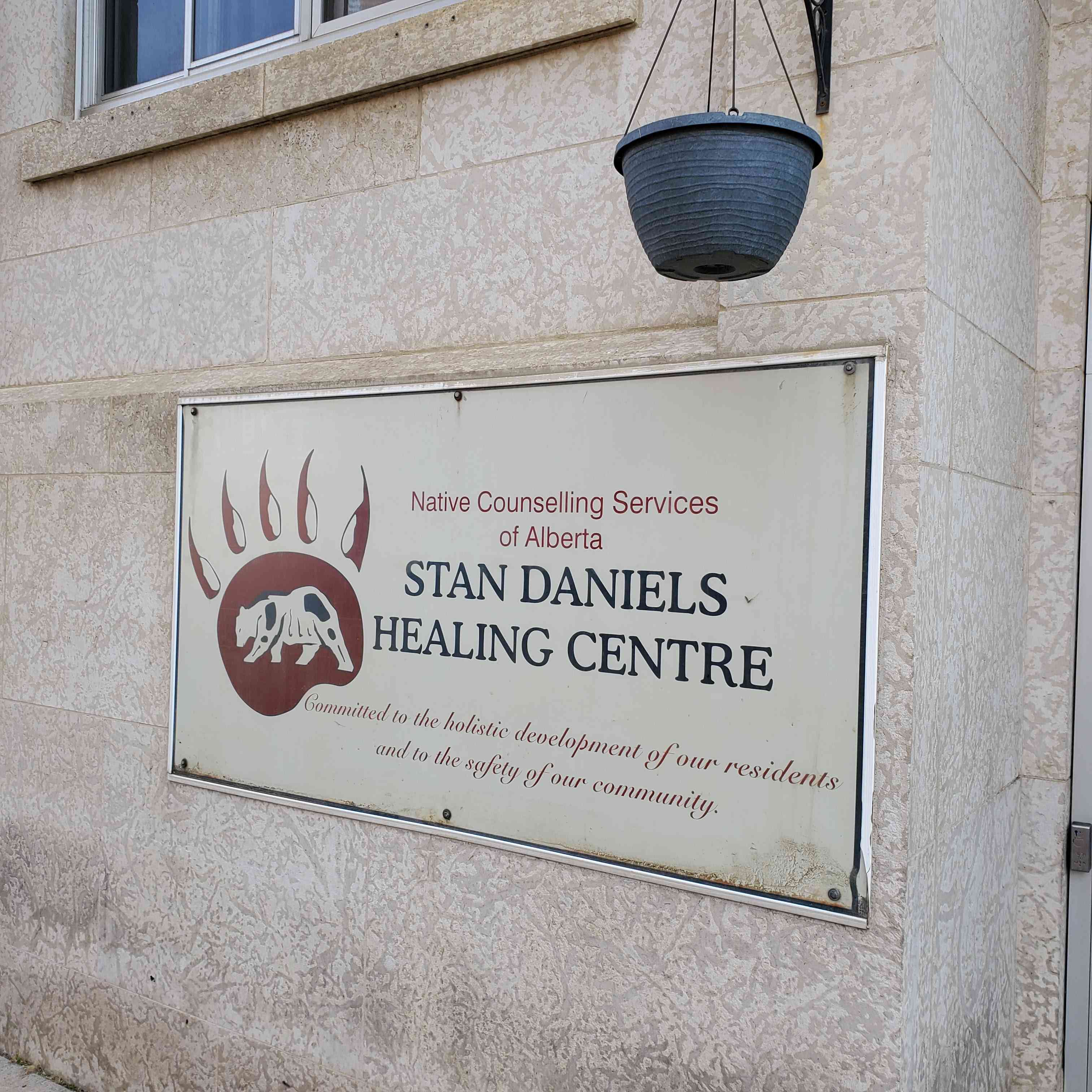
Stan Daniels Healing Centre – Exterior sign.
Of all of the recommendations that have been issued to the Service on Indigenous corrections, the expansion of Healing Lodges (Section 81) and section 84 (Community Release) are the two made most frequently. Despite identifying these sections of the law as priorities themselves, CSC has made very little progress. Since Spirit Matters , there has been the addition of one new Healing Lodge (i.e., Eagle Women’s Healing Lodge in Manitoba) and the number of spaces in community-run Healing Lodges has increased by only 53 beds – a number vastly insufficient to keep pace with the growing proportions of Indigenous people entering federal custody. Furthermore, there continues to be no Healing Lodge capacity in the Ontario and Atlantic regions, which have both seen substantial increases in Indigenous admissions, particularly the Atlantic region where the incarcerated Indigenous population has increased by nearly 90% in the last ten years.
With an already limited number of Healing Lodge spaces, it should be noted that the COVID-19 pandemic has had a marked impact on Healing Lodge occupancy rates. For example, in the two years prior to the pandemic, the average occupancy rate of Healing Lodges was around 78%. At the writing of this report, the average occupancy rate was approximately 51%, which begs the question – with so few Healing Lodges spaces available, why are occupancy rates so low? I intend to examine this question, among others, in the coming year.
Table 1. Ten-Year Comparison of Healing Lodge Capacity and Occupancy Rates
- Increasing the use of Healing Lodges, section 84 releases, and engagement with Indigenous communities;
| 2012/13 | 2021/22 | ||||||
| FACILITY | RATED CAPACITY | ACTUAL CAPACITY | % OCCUPIED | RATED CAPACITY | ACTUAL CAPACITY | % OCCUPIED | PRE-COVID 2-YEAR AVERAGE % OCCUPIED* |
| Community-run s.81 Healing Lodge | |||||||
| Stan Daniels Healing Centre | 30 | 19 | 63.33 | 30 | 13 | 43.33 | 53.33 |
| O-chi-chak-ko-sipi First Nation Healing Lodge | 24 | 22 | 91.67 | 24 | 12 | 50 | 81.25 |
| Waseskun Healing Centre | 15 | 15 | 100 | 15 | 8 | 53.33 | 80 |
| Buffalo Sage | 12 | 16 | 133.33 | 28 | 21 | 75 | 91.1 |
| Prince Albert Grand Council Healing Lodge | 5 | nr | – | 12 | 7 | 58.33 | 83.3 |
| Eagle Women’s Healing Lodge** | – | – | – | 30 | 4 | 13.33 | 0 |
| CSC-operated Healing Lodge | |||||||
| Kwìkwèxwelhp Healing Village | 50 | 44 | 88 | 50 | 20 | 40 | 81 |
| Pê Sâkâstêw Centre | 60 | 47 | 78.33 | 60 | 44 | 73.33 | 79.17 |
| Willow Cree Healing Centre | 40 | 40 | 100 | 80 | 33 | 41.25 | 66.88 |
| Okimaw Ohci Healing Lodge | 40 | 33 | 82.5 | 60 | 36 | 60 | 85.58 |
| Total | 276 | 236 | 85.5 | 389 | 198 | 50.9 | 77.97 |
Note: Occupancy data was obtained from CSC’s CRS-M Institutional Counts report; nr = not reported;
*2-year average % occupancy is based on the rated vs. actual capacity counts from 2018/19 and 2019/20, to get a sense of pre-pandemic occupancy.
**Eagle Women’s Healing Lodge opened as a s.81 facility in 2019.

Stan Daniels Healing Centre – Interior room.

Pê Sâkâstêw Centre – Interior.
In addition to the limited changes in capacity, there does not appear to have been any appreciable changes to the mechanisms for establishing section 81 or section 84 agreements with Indigenous communities or organizations. These concerns, coupled with the narrow eligibility criteria for admission to most Healing Lodges, seriously call into question whether Healing Lodges are being set up to serve the needs of a significant proportion of incarcerated Indigenous individuals.
Similarly, with section 84, we have seen little in the way of movement on commitments and recommendations since Spirit Matters . Footnote 96 The number of individuals expressing an interest in, or receiving a section 84 release, has remained essentially unchanged today compared to 2012. While the increases in the number of Indigenous admissions over time alone should have resulted in a corresponding rise in the number of section 84s, modifications to the cumbersome and bureaucratic process of section 84, as recommended, should also have theoretically resulted in improvements – and thus, increases – in the use of this release process.
Indigenous Representation and Cultural Competence
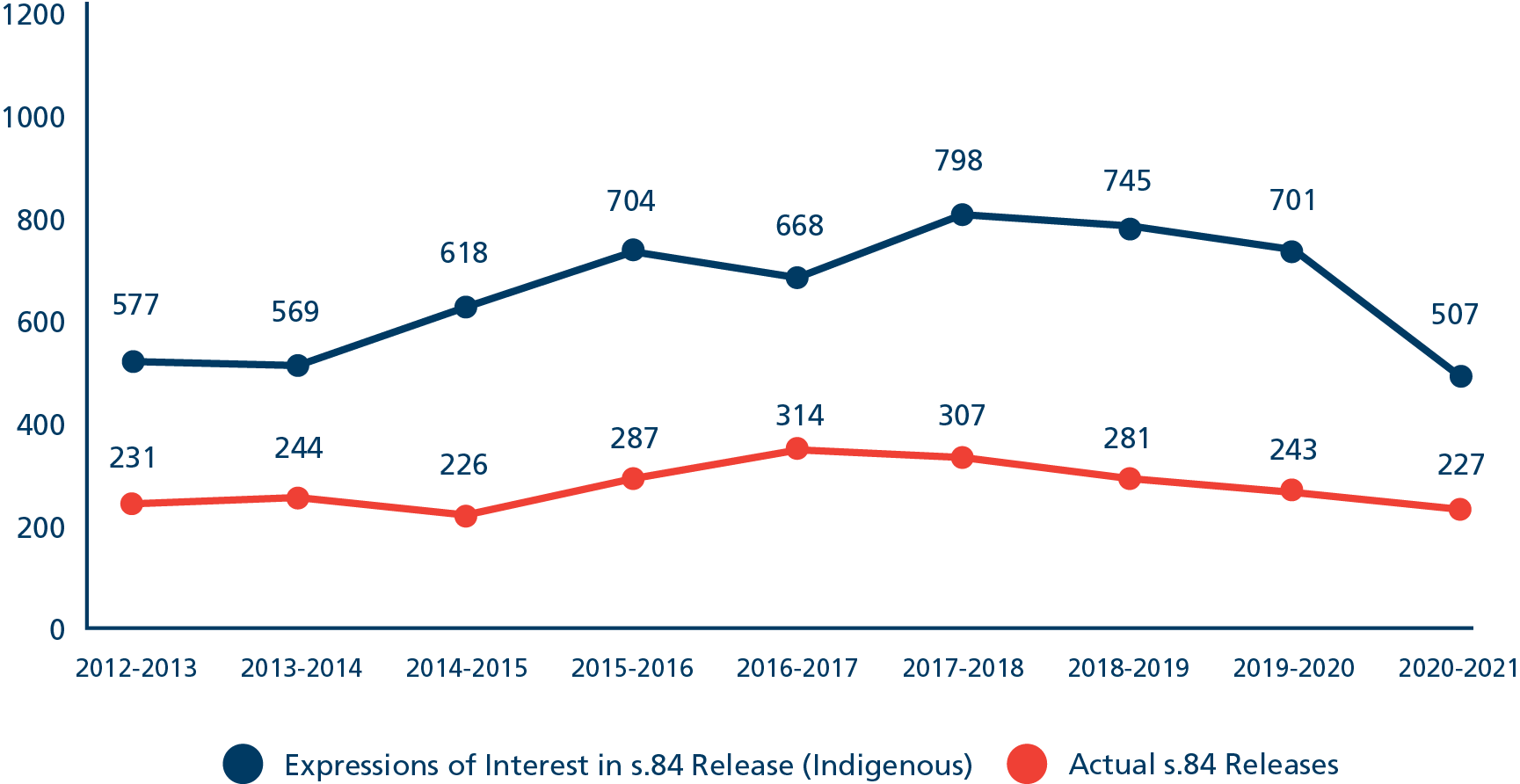
Graph 2. Expressions of Interest and Actual Releases
on Section 84 from 2012 to 2021 Footnote 97Despite various commitments in this area, the lack of Indigenous representation among CSC staff, particularly in leadership positions, as well as the reportedly low levels of cultural awareness is a long-standing problem on which CSC has made seemingly few significant inroads. Nationally, Indigenous individuals continue to be underrepresented among staff relative to the composition of the incarcerated population (i.e., 10% of CSC staff identify as Indigenous versus 32% of incarcerated individuals), and are even more vastly underrepresented in leadership positions. For example, according to data provided by CSC, of the 111 executive level positions at national headquarters, only three (2.7%) are occupied by Indigenous individuals. Similarly, for Elders, who already face numerous vulnerabilities – in large part due to their employment status as contractors – are too few in number to serve the growing population, are spread thin, and are expected to play many different roles. There are currently only 133 Elders across the country for the 3,953 Indigenous individuals in custody. While not all Indigenous individuals will seek to work with an Elder, these numbers translate to an overall ratio of 30 Indigenous persons for every one Elder. Though the ratio of Elders varies considerably by institution and region, the Prairie region has the largest number of incarcerated Indigenous individuals and the worst Elder to prisoner ratio, with an average of 35 to one. One institution has a ratio of 105 Indigenous prisoners to one Elder.
While there are complexities to recruiting and retaining Elders to work in the prison setting, many of the surmountable barriers that have existed for attracting and keeping Elders (among other Indigenous staff) have gone unresolved. Some have attributed this to a lack of understanding or appreciation for the work that Elders and other Indigenous staff do. We have heard time and time again that the work of Elders, among others, is not given the credibility it deserves, nor the credibility that is bestowed upon other sectors or positions in case management and intervention work. Clearly, more needs to be done not only to recruit more Elders and to protect those who are currently undertaking this work, but also to educate staff more broadly on the important role that Elders and Indigenous departments play in advancing rehabilitative and healing work.
Based on information and feedback we have received, the various plans and strategies that CSC has created to address the issue of representativeness and recruitment have seemingly been largely ineffective (e.g., National Aboriginal Employee Consultation : Working Together in Partnership Toward Inclusion, 2012; Connecting Spirits, Creating Opportunities , 2019). Furthermore, staff members and incarcerated persons alike have told us that cultural competency training is inherently limited in its value and impacts, often providing largely surface-level, pan-Indigenous perspectives on Indigenous worldviews and ways of knowing. Greater cultural awareness and credibility would be brought about by improved recruitment, retention, and promotion of Indigenous staff, which in turn would have a direct impact on the lives of federally sentenced individuals. Plain and simple, CSC needs to do more to attract and hire Indigenous Peoples, to recognize and promote the value of their work, and collaborate in earnest with Indigenous communities to meaningfully move the yardstick on these issues. The lack of progress on Healing Lodges, section 84, Indigenous representation, and cultural competency serve as undeniable examples of the consequences attributable to the absence of a national community engagement and co-development strategy for Indigenous corrections – a gap that, in my view, has had an unprecedented impact on the Service’s ability to produce transformative change for Indigenous corrections.
A Deputy Commissioner for Indigenous Corrections
The need to appoint a Deputy Commissioner for Indigenous corrections is a recommendation that this office has issued nearly a dozen times over the last twenty years, and has been repeated by other committees and commissions who similarly recognize the need for dedicated Indigenous leadership and decision-making power in federal corrections (e.g., NIMMIWG, 2020; House of Commons Standing Committee on the Status of Women, 2017; House of Commons Standing Committee on Public Safety and National Security, 2017).
In June 2021, in what this Office viewed as a promising step forward on this recommendation, the government identified the following short-term priority and goal in the National Action Plan in response to the final report of the NIMMIWG:
Goal #6 (d): “Create a Deputy Commissioner for Indigenous Corrections and address issues for Indigenous women and 2SLGBTQQIA+ offenders…”
In October 2021, this Office requested an update from CSC on its plans to fulfill this commitment. In January 2022, CSC provided the following response: “CSC’s position remains the same – there are no plans to create a Deputy Commissioner for Indigenous Corrections.”
On May 27, 2022, the Minister of Public Safety’s mandate letter to the Commissioner of Corrections called for the creation of a new position of Deputy Commissioner for Indigenous Corrections . Days later, in a statement released in response to the findings from the Auditor General’s report on federal corrections, the Commissioner of Corrections noted, “I am in the process of staffing a Deputy Commissioner for Indigenous Corrections position.”
I am pleased to see this item raised in the mandate letter and am encouraged by the Commissioner’s response. Given the lack of progress over the last two decades on this particular recommendation, however, I will wait to consider this issue closed once a Deputy Commissioner for Indigenous Corrections is officially in place. In the meantime, I offer the following (and hopefully last) recommendation on this issue:
- I recommend that CSC consult with Indigenous community groups on the job description, role, mandate, and hiring process for the Deputy Commissioner for Indigenous Corrections position, and that they report publicly on their plans and short-term timelines to create and staff this position.
Next Steps
In recent years, this country has faced a reckoning for the intergenerational abuses perpetrated by governments, institutions, and individuals, against Indigenous Peoples. From grassroots organizations to various levels of government, there has been a groundswell of recognition and renewed sense of urgency around the need to repair relationships and systems, including corrections, which have long been broken. In June 2021, the United Nations Declaration on the Rights of Indigenous Peoples (UNDRIP) Act came into force, providing a much-needed roadmap for broader reconciliation in Canada. In the mandate letter to the Minister of Justice and Attorney General of Canada, the government committed to the development of an Indigenous Justice Strategy “to address systemic discrimination and the over-representation of Indigenous people in the justice system”. While large-scale justice strategies in this area have tended to focus on the contributions of policing and the courts, in order to develop an effective strategy to address discrimination in the justice system, federal corrections must be part of the conversation. In an effort to leverage the momentum of existing government initiatives in this area, specifically, the development of a national justice strategy, I am issuing the following recommendation:
- I recommend the Minister of Justice and Attorney General of Canada include the Correctional Service of Canada and the Office of the Correctional Investigator in the development and implementation of the Indigenous Justice Strategy (IJS). Furthermore, the IJS should seek to redistribute a significant portion of the current resources within the federal correctional system to Indigenous communities and groups for the care, custody, and supervision of Indigenous Peoples.
Furthermore, federal corrections needs to be held accountable to concrete and measurable targets and results, particularly those under their direct control, and more effectively use its levers of influence to address long-standing barriers, such as the over-retention of Indigenous Peoples behind bars and the high rates of recidivism. Of course, federal corrections cannot meet the task on their own. Being included in a coordinated, Indigenous-led, national engagement strategy is a necessary step toward resolution. At the most basic level, the correctional system should not serve to further perpetuate disadvantage, which is precisely what we have seen reflected in the outcomes and prison health indicators for incarcerated Indigenous Peoples, particularly when compared to their non-Indigenous counterparts. The promise of administering an Indigenous person’s sentence through a Gladue -informed lens has not materialized, and, in practice, family and community histories of fragmentation, dislocation and dispossession are too commonly used to validate higher security classifications and lower reintegration potential scores. Corrections has an admittedly complex set of issues to contend with, but we have reached a point where complexity is no longer a sufficient excuse for stagnation.
Correctional Investigator’s Outlook for 2022-23
As we navigate the third year of the global COVID-19 pandemic, we have seemingly transitioned to a new endemic phase – from stopgap measures, to now thinking longer term about how we will learn to live and adapt to this so-called “new normal”. Even as we adapt and innovate and explore new ways to deliver on our mandate (such as a new intake “triage” process for responding to complaints), we must maintain and always keep the integrity and vitality of our core function in plain and permanent view. In the coming year, we look forward to getting back to conducting a full slate of in-person institutional visits and getting ourselves organized to take on and continue to roll out our new framework for prison inspections. I also look forward to the development and implementation of a comprehensive stakeholder engagement strategy.
Nearly thirty years following the introduction of the Corrections and Conditional Release Act , 2023 will also mark ten years since the Office’s Spirit Matters report was tabled in parliament. In keeping with our continued commitment to advancing progress for federally sentenced Indigenous individuals, in the coming year my Office will be conducting an in-depth investigation into Indigenous corrections. For this investigation, we will be taking a close look at what progress has been achieved on key recommendations made by this office and others, what results have been yielded from investments made, and initiatives undertaken by the Service (e.g., Indigenous Intervention Centres and Pathways), where promising practices exist, and what new challenges have emerged since Spirit Matters . Further to this investigation, we will be issuing targeted recommendations in areas where transformative changes can and should be made for Indigenous corrections going forward.
In addition to this work, we will continue to monitor, investigate, and report on systemic and/or thematic issues concerning women’s corrections, the needs of gender-diverse individuals, progress on commitments made by the Service on sexual coercion and violence in federal prisons, among other issues raised in this report.
It goes without saying that the pandemic has been challenging for everyone, including my staff. In the year ahead, I will be making organizational health and wellbeing a key priority. Among other initiatives, we will also be undertaking work to enhance our office’s effectiveness and continue to make strides toward being an employer of choice and a centre of excellence.
In closing, I want to circle back to one of the themes of my opening message by way of endorsing the Principles for the Protection and Promotion of the Institution of the Ombudsman . Created in March of 2019 by the Venice Commission of the Council of Europe, these principles, referred to as “The Venice Principles,” are the first set of independent and internationally accepted standards that define, promote, and protect the role of ombuds in strengthening democracy and promoting fundamental rights. As the 25 Venice Principles lay out, the ombuds is an important – I would even argue, essential – element of states that are based on democracy, rule of law, good administration, and respect for human rights and freedoms. It is in keeping with the spirit of these principles that, in the year ahead, my Office will continue to work tirelessly to ensure the fair and humane treatment of individuals serving federal sentences, by drawing attention to human rights obligations and holding the Service accountable for administering federal corrections in a way that is compliant with law, policy, and fair decision-making. In our daily work, we will continue to strive to embody and demonstrate leadership in our execution of these principles of good and effective ombudsmanship.

Photo of Fergus “Chip” O’Connor
Ed McIsaac Human Rights in Corrections Award
The Ed McIsaac Human Rights in Corrections Award was established in December 2008, in honour of Mr. Ed McIsaac, long-time Executive Director of the Office of the Correctional Investigator and strong promoter and defender of human rights in federal corrections. It commemorates outstanding achievement and commitments to improving corrections in Canada and protecting the human rights of incarcerated persons.
The 2021 recipient of the Ed McIsaac Human Rights in Corrections award was Fergus “Chip” O’Connor. Chip has practiced law in Kingston since 1975. He was a founding member of the Canadian Prison Law Association and served as Director of the Correctional Law Project (now Queen’s Prison Law Clinic) at Queen’s University. For more than four decades, Chip has been an active advocate for incarcerated persons. He has demonstrated exceptional leadership, commitment, and conviction, and is acknowledged among his peers as an elder statesman in the field of correctional law.
Annex A: Summary of Recommendations
- I repeat my recommendation to prohibit any indefinite dry cell placement beyond 72 hours.
- With respect to CSC’s drug strategy, I recommend the following set of measures:
- CSC’s zero tolerance policy to drug use and possession is recalibrated to focus on corrective measures for drug diversion and trafficking, rather than stigmatizing, targeting or disciplining persons struggling with addictions or substance abuse disorders.
- CSC’s zero tolerance policy to drug use and possession is recalibrated to focus on corrective measures for drug diversion and trafficking, rather than stigmatizing, targeting or disciplining persons struggling with addictions or substance abuse disorders.
- I recommend that CSC prioritize the current review of the security classification process, particularly as it applies to Indigenous women. In the interim, I recommend that Indigenous Social History (ISH) be assessed in a meaningful way for each decision rendered and that case management staff are provided with adequate training and support to apply the ISH.
- Once again, I recommend that the level system for maximum-security women be immediately rescinded.
- I reiterate my recommendation for alternative accommodations for women housed in Secure Units and their eventual closure. Funding and resources currently dedicated to Secure Unit operation should be redirected to better support and address the unique needs of women, particularly Indigenous women.
- I recommend that CSC:
- Collect, track, and publicly report on participation in the Mother-Child Program to better understand who it is serving and how the program is functioning.
- Collect, track, and publicly report on participation in the Mother-Child Program to better understand who it is serving and how the program is functioning.
- I recommend that, without any further delay, CSC outfit all of its prisoner escort vehicles, including those currently in service, with seatbelt assemblies, handholds and other safety and restraint features that would meet its obligation to provide safe and humane custody of prisoners under security escort. I further recommend that CSC return to the drawing table to reconsider its planned “modernization” of its security escort fleet that is more responsive to Office concerns and recommendations.
- I recommend that CSC:
- Review its positions with respect to hair extensions from a dignity and diversity perspective rather than solely through a security lens.
- Review its positions with respect to hair extensions from a dignity and diversity perspective rather than solely through a security lens.
- I recommend that CSC conduct a comparative review, in partnership with Black community groups or external experts, to examine cumulative time spent by Black individuals before reclassification and cascading to lower levels of security.
- I recommend that CSC conduct a systemic review of its use of the Security Threat Groups classification criteria to ensure that only relevant information corroborated by external law enforcement, court or judicial authorities, and supported by evidence, are used to designate an individual with a Security Threat Group.
- I recommend that, within the next year, the Service develop a gang disaffiliation strategy. This strategy should:
- Incorporate best practices and lessons learned from community-based initiatives, correctional jurisdictions, and other public safety domains.
- Incorporate best practices and lessons learned from community-based initiatives, correctional jurisdictions, and other public safety domains.
- I again recommend that CSC promptly develop an action plan in consultation with stakeholders to address the relationship between use-of-force and systemic racism against Indigenous and Black individuals and publicly report on actionable changes to policy and practice that will effectively reduce the over-representation of these groups among those exposed to uses of force.
- I recommend that CSC expand its staff diversity training to include representation from Black community groups and external experts who can provide a more complete and relevant perspective. This training should be mandatory, in-person and oriented to practical and lived experiences of Black people.
- I recommend that CSC develop a training program for front-line health professionals. This program should draw on the most recent research on racial bias and its impact on medical decisions and procedures.
- I recommend that CSC develop a national strategy that specifically addresses the unique lived experiences and barriers faced by federally sentenced Black individuals. This strategy should include the following elements:
- I recommend that CSC immediately develop national policy for the use of Voluntary Limited Association Ranges (VLARs) and any other sub-population living unit or range that clearly identifies:
- I recommend that CSC consult with Indigenous community groups on the job description, role, mandate, and hiring process for the Deputy Commissioner for Indigenous Corrections position, and that they report publicly on their plans and short-term timelines to create and staff this position.
- I recommend the Minister of Justice and Attorney General of Canada include the Correctional Service of Canada and the Office of the Correctional Investigator in the development and implementation of the Indigenous Justice Strategy (IJS). Furthermore, the IJS should seek to redistribute a significant portion of the current resources within the federal correctional system to Indigenous communities and groups for the care, custody, and supervision of Indigenous Peoples.
Annex B: Annual Statistics
Table A: OCI Complaints by Category and Resolution Status Footnote 98
| COMPLAINT CATEGORY OR SUBCATEGORY | ACTIVE | RESOLVED | TOTAL |
|---|---|---|---|
| ADMINISTRATIVE SEGREGATION | – | 2 | 2 |
| CASE PREPARATION | 19 | 147 | 166 |
| CELL EFFECTS | 25 | 262 | 287 |
| Exchange | – | 4 | 4 |
| Canteen | 2 | 18 | 20 |
| Search and/or Seizure | 3 | 22 | 25 |
| Pen Pack | 4 | 39 | 43 |
| Transfers | 3 | 62 | 65 |
| Other | 13 | 117 | 130 |
| CELL PLACEMENT | 6 | 46 | 52 |
| Protected Custody | – | 2 | 2 |
| Double Bunking | 1 | 12 | 13 |
| Unit/Range | 3 | 14 | 17 |
| Other | 2 | 18 | 20 |
| CLAIMS AGAINST THE CROWN | 2 | 24 | 26 |
| Processing | 1 | 4 | 5 |
| Decisions | 1 | 5 | 6 |
| Other | – | 15 | 15 |
| COMMUNITY SUPERVISION | – | 30 | 30 |
| CONDITIONAL RELEASE | 4 | 73 | 77 |
| Detention | – | 1 | 1 |
| Conditions | – | 3 | 3 |
| Revocation | – | 3 | 3 |
| Application | – | 5 | 5 |
| Day Parole | – | 5 | 5 |
| Suspension | 1 | 14 | 15 |
| Conditions | 1 | 19 | 20 |
| Other | 2 | 23 | 25 |
| CONDITIONS OF CONFINEMENT | 41 | 668 | 709 |
| Health and Safety of Inmate Worksites | 1 | 1 | 2 |
| Access to Showers | 1 | 6 | 7 |
| Sanitation/Cleanliness | 1 | 42 | 43 |
| Temperature | – | 45 | 45 |
| Recreation Time | 2 | 51 | 53 |
| Lockdown | 3 | 141 | 144 |
| Other | 33 | 382 | 415 |
| DEATH OF INMATE | 2 | 6 | 8 |
| DIETS | – | 40 | 40 |
| Special Diets | – | 3 | 3 |
| Medical | – | 5 | 5 |
| Religious | – | 28 | 28 |
| Other | – | 4 | 4 |
| DISCIPLINE | 5 | 51 | 56 |
| Major Charges | 1 | 7 | 8 |
| Procedures | 1 | 9 | 10 |
| Minor Charges | – | 13 | 13 |
| Other | 3 | 22 | 25 |
| DISCRIMINATION | 6 | 81 | 87 |
| Disability | 1 | 4 | 5 |
| Gender | – | 11 | 11 |
| Religion | 3 | 19 | 22 |
| Race | 1 | 30 | 31 |
| Other | 1 | 17 | 18 |
| EMPLOYMENT | 6 | 44 | 50 |
| Suspension | – | 15 | 15 |
| Access | 5 | 13 | 18 |
| Other | 1 | 16 | 17 |
| FILE INFORMATION | 17 | 122 | 139 |
| Access | 7 | 17 | 24 |
| Correction | 2 | 38 | 40 |
| Other | 8 | 67 | 75 |
| FINANCIAL MATTERS | 17 | 135 | 149 |
| Access | 1 | 3 | 4 |
| Pay | – | 44 | 44 |
| Other | 13 | 88 | 101 |
| FOOD SERVICES | 4 | 44 | 48 |
| GRIEVANCES | 5 | 87 | 92 |
| Corrective Action | – | 2 | 2 |
| Decision | – | 10 | 10 |
| Procedure | 2 | 34 | 36 |
| Other | 3 | 41 | 44 |
| HARASSMENT BY INMATE | 2 | 5 | 7 |
| Verbal | – | 1 | 1 |
| Physical | 1 | 1 | 2 |
| Sexual | 1 | 1 | 2 |
| Other | – | 2 | 2 |
| HARM REDUCTION | 1 | 22 | 23 |
| Needle Exchange Program | – | 1 | 1 |
| Drug Strategy | – | 5 | 5 |
| Opiate Substitution Therapy | 1 | 16 | 17 |
| HEALTH CARE | 42 | 457 | 499 |
| Hunger Strike | 2 | 6 | 8 |
| Dental | 1 | 31 | 32 |
| Decisions | 4 | 32 | 36 |
| Access | 14 | 114 | 128 |
| Medication | 9 | 159 | 168 |
| Other | 12 | 115 | 127 |
| IMMIGRATION/DEPORTATION | – | 1 | 1 |
| INMATE REQUEST PROCESS | 3 | 17 | 20 |
| Procedure | – | 2 | 2 |
| Response | – | 7 | 7 |
| Other | 3 | 8 | 11 |
| LEGAL ACCESS | 12 | 116 | 128 |
| 3 | 81 | 84 | |
| Seizure | – | 4 | 4 |
| Delivery/Pickup | 1 | 28 | 29 |
| Other | 2 | 49 | 51 |
| MENTAL HEALTH | 7 | 59 | 66 |
| Decisions | – | 1 | 1 |
| Quality of care | – | 1 | 1 |
| Self-Injury | 1 | 9 | 10 |
| Access | 2 | 27 | 29 |
| Other | 4 | 21 | 25 |
| OCI | 52 | 213 | 265 |
| Alleged Reprisal from Contact | 1 | 9 | 10 |
| Decisions/Operations | 8 | 22 | 30 |
| Other | 43 | 182 | 225 |
| OFFICIAL LANGUAGES | – | 4 | 4 |
| OUTSIDE COURT | – | 5 | 5 |
| OUTSIDE JURISDICTION | – | 20 | 20 |
| PAROLE BOARD OF CANADA DECISIONS | 2 | 22 | 24 |
| PROGRAMS | 3 | 70 | 73 |
| Quality/Content | – | 3 | 3 |
| Decisions | – | 5 | 5 |
| Access | 3 | 39 | 42 |
| Other | – | 23 | 23 |
| PROVINCIAL/TERRITORIAL MATTERS | 1 | 26 | 27 |
| RELEASE PROCEDURES | 3 | 62 | 65 |
| SAFETY AND SECURITY | 19 | 201 | 220 |
| Staff | 3 | 27 | 30 |
| Incompatibles/Other Offenders | 6 | 66 | 72 |
| Other | 10 | 108 | 118 |
| SEARCH | 2 | 25 | 27 |
| Strip Search | – | 1 | 1 |
| Dry Cell | 1 | 3 | 4 |
| Regular | – | 4 | 4 |
| Other | 1 | 17 | 18 |
| SECURITY CLASSIFICATION | 10 | 70 | 80 |
| Initial | – | 4 | 4 |
| Review | 4 | 29 | 33 |
| Other | 6 | 37 | 43 |
| SENTENCE ADMINISTRATION | – | 16 | 16 |
| SERIOUS INJURY OF IMNMATE | – | 1 | 1 |
| SHU-NAC REVIEWS | – | 1 | 1 |
| STAFF | 40 | 438 | 478 |
| Management | – | 16 | 16 |
| Correctional Staff | 12 | 138 | 150 |
| Case Management | 14 | 147 | 161 |
| Other | 14 | 137 | 151 |
| STRUCTURED INTERVENTION UNITS (SIU) | 9 | 36 | 45 |
| Placement/Review | 5 | 8 | 13 |
| Conditions | 3 | 13 | 16 |
| Other | 1 | 15 | 16 |
| TELEPHONE | 4 | 123 | 127 |
| Use Suspension | – | 6 | 6 |
| Access to a Telephone | – | 33 | 33 |
| Pin | 2 | 37 | 39 |
| Other | 2 | 37 | 39 |
| TEMPORARY ABSENCE | 9 | 30 | 39 |
| Escorted | 1 | 5 | 6 |
| Unescorted | 2 | 5 | 7 |
| Compassionate | 5 | 19 | 24 |
| Other | 1 | 1 | 2 |
| TRANSFER | 19 | 156 | 175 |
| URINALYSIS | 2 | 20 | 22 |
| USE OF FORCE | 14 | 46 | 60 |
| VISITS | 16 | 124 | 140 |
| VRB Decision | 1 | – | 1 |
| Regular Visits | – | 3 | 3 |
| Treatment of Visitors | – | 3 | 3 |
| Primary Family Visit | – | 20 | 20 |
| Cancellation/Suspension | 2 | 19 | 21 |
| Private Family Visit | 5 | 25 | 30 |
| Other | 8 | 54 | 62 |
| VLAR CONDITIONS | – | 1 | 1 |
| GRAND TOTAL Footnote 99 | 431 | 4,330 | 4,761 |
Table B. Interactions and Interviews by Region and Institution
| REGION OR INSTITUTION | CASES | INTERVIEW | DAYS IN INSTITUTIONS | |
|---|---|---|---|---|
| ATLANTIC | 370 | 12 | 10 | |
| Atlantic | 106 | – | 4 | |
| Dorchester | 112 | 3 Footnote 101 | 1 | |
| Nova Institution for Women | 64 | 5 | 1 | |
| Shepody Healing Centre | 25 | – | – | – |
| Springhill | 63 | 4 | 4 | |
| QUEBEC | 999 | 43 | 16 | |
| Archambault | 121 | 0 Footnote 102 | 1 | |
| Centre régional de santé mentale | 7 | – | – | |
| Cowansville | 128 | 9 | 3 | |
| Regional Reception Centre | 75 | 0 Footnote 103 | 1 | |
| Donnacona | 73 | 1 | 4 | |
| Drummond | 36 | 6 | – | |
| Federal Training Centre | 109 | 8 | - | |
| Joliette | 41 | – | 3 | |
| La Macaza | 72 | 2 | – | |
| Port-Cartier | 214 | 17 | 4 | |
| Special Handling Unit | 119 | – | – | |
| Waseskun Healing Lodge | 4 | – | – | |
| ONTARIO | 899 | 53 | 15 | |
| Bath | 129 | 4 | 1 | |
| Beaver Creek | 135 | 4 | – | |
| Collins Bay | 58 | 17 | 3 | |
| Grand Valley Institution for Women | 97 | 3 | 3 | |
| Joyceville | 31 | 4 Footnote 104 | 2 | |
| Joyceville Assessment Unit | 87 | – | – | |
| Joyceville TD Unit | 1 | – | – | |
| Millhaven | 143 | 0 Footnote 105 | 3 | |
| Millhaven Assessment Unit | 2 | – | – | |
| Millhaven TD Unit | 1 | – | – | |
| Millhaven – Regional Treatment Centre | 13 | – | 3 | |
| Warkworth | 203 | 21 | – | |
| PRAIRIES | 1,289 | 61 | 29 | |
| Bowden | 192 | 23 | 3 | |
| Drumheller | 133 | 14 | 3 | |
| Edmonton | 304 | – | 6 | |
| Edmonton Institution for Women | 46 | – | 4 | |
| Grande Cache | 186 | – | 2 | |
| Grierson | 9 | – | – | |
| Okimaw Ohci Healing Lodge | 5 | – | – | |
| Pê Sâkâstêw Centre | 2 | – | 1 | |
| Prince Albert Grand Council Spiritual Healing Lodge | 3 | – | – | |
| Regional Psychiatric Centre | 76 | 3 | 2 | |
| Saskatchewan | 239 | 13 | 4 | |
| Stan Daniels Healing Centre | 4 | – | – | |
| Stony Mountain | 88 | 8 | 4 | |
| Willow Cree Healing Lodge | 2 | – | – | |
| PACIFIC | 881 | 39 | 12 | |
| Fraser Valley Institution for Women | 118 | 37 | 4 | |
| Kent | 114 | – | 5 | |
| Kwìkwèxwelhp Healing Village | 3 | – | 1 | |
| Matsqui | 77 | - | – | |
| Mission | 287 | 1 | 1 | |
| Mountain | 112 | – | – | |
| Pacific | 91 | 1 Footnote 106 | – | |
| Regional Reception Centre - Pacific | 21 | – | – | |
| Regional Treatment Centre - Pacific | 53 | – | 1 | |
| William Head | 5 | - | - | |
| CCC-CRC/ PAROLEES IN THE COMMUNITY Footnote 107 | 285 | - | 1 | |
| CCC-CRC-Atlantic | 14 | – | 1 | |
| CCC-CRC-Quebec | 67 | – | – | |
| CCC-CRC-Ontario | 28 | – | – | |
| CCC-CRC-Prairies | 32 | – | – | |
| CCC-CRC-Pacific | 12 | – | – | |
| Community-Atlantic | 10 | – | – | |
| Community-Quebec | 23 | – | – | |
| Community-Ontario | 38 | – | – | |
| Community-Prairies | 32 | – | – | |
| Community-Pacific | 29 | – | – | |
| UNSPECIFIED INSTITUTION Footnote 108 | 38 | - | - | |
| GRAND TOTAL | 4,761 | 208 | 83 |
Table C. Cases and Interviews for Federally Sentenced Women’s Institutions
| REGION OR INSTITUTION | CASES | INTERVIEWS |
|---|---|---|
| ATLANTIC | 64 | 5 |
| Nova Institution for Women | 64 | 5 |
| QUEBEC | 41 | – |
| Joliette | 41 | – |
| ONTARIO | 97 | 3 |
| Grand Valley Institution for Women | 97 | 3 |
| PRAIRIES | 51 | – |
| Edmonton Institution for Women | 46 | – |
| Okimaw Ohci Healing Lodge | 5 | – |
| PACIFIC | 118 | 37 |
| Fraser Valley Institution for Women | 118 | 37 |
| GRAND TOTAL | 371 | 45 |
Table D. Disposition of Cases
| ACTION | # |
|---|---|
| Internal Resolution Footnote 109 | 2,912 |
| Inquiry Footnote 110 | 1,633 |
| Investigation Footnote 111 | 317 |
| TOTAL | 4,862 Footnote 112 |
Table E. Cases, Individual Complainants, and In-Custody Population by Region
| REGION | CASES | INDIVIDUALS Footnote 113 | IN-CUSTODY POPULATION Footnote 114 |
|---|---|---|---|
| Atlantic | 362 | 167 | 1,057 |
| Quebec | 986 | 367 | 2,608 |
| Ontario | 872 | 416 | 3,285 |
| Prairies | 1,264 | 586 | 3,761 |
| Pacific | 871 | 298 | 1,617 |
| TOTAL Footnote 115 | 4,355 | 1,834 | 12,328 |
Table F. Top Ten Most-Frequently Identified Complaint Categories by Population
| Total In-Custody Population | ||
|---|---|---|
| CATEGORY | # | % |
| Conditions of Confinement | 709 | 14.9 |
| Health Care | 499 | 10.5 |
| Staff | 478 | 10.0 |
| Cell Effects | 287 | 6.0 |
| OCI | 265 | 5.6 |
| Safety and Security | 220 | 4.6 |
| Transfer | 175 | 3.7 |
| Case Preparation | 166 | 3.5 |
| Financial Matters | 149 | 3.1 |
| Visits | 140 | 2.9 |
| Indigenous Prisoners | ||
| Conditions of Confinement | 207 | 14.6 |
| Health Care | 162 | 11.5 |
| Staff | 134 | 9.5 |
| Cell Effects | 107 | 7.6 |
| Safety and Security | 75 | 5.3 |
| Transfer | 66 | 4.7 |
| OCI | 61 | 4.3 |
| Financial Matters | 44 | 3.1 |
| Legal Access | 40 | 2.8 |
| File information | 37 | 2.6 |
| Telephone | 37 | 2.6 |
| Federally Sentenced Women | ||
| Conditions of confinement | 57 | 14.4 |
| Staff | 56 | 14.1 |
| Health Care | 51 | 12.9 |
| OCI | 23 | 5.8 |
| Transfer | 21 | 5.3 |
| Safety and Security | 19 | 4.8 |
| Cell Effects | 16 | 4.0 |
| Temporary Absence | 13 | 3.3 |
| Security Classification | 10 | 2.5 |
| Financial Matters | 10 | 2.5 |
Annex C: Other Statistics
A. Mandated Reviews Conducted in 2021-22
As per the Corrections and Conditional Release Act (CCRA), the Office of the Correctional Investigator reviews all CSC investigations involving incidents of inmate serious bodily injury or death.
Mandated Reviews by Type of Incident
| INCIDENT TYPE | REVIEWS |
|---|---|
| Death (Natural Cause) Footnote 116 | 9 |
| Assault | 24 |
| Overdoses | 11 |
| Injuries | 17 |
| Attempted Suicide | 7 |
| Suicide | 2 |
| Murder | 2 |
| Self-Injury | 2 |
| Death (Other) | 1 |
| TOTAL | 75 |
B. Use-of-Force Reviews Conducted by the OCI in 2021-22
The Correctional Service of Canada is required to provide all pertinent and relevant use-of-force documentation to the Office. Use-of-force documentation typically includes:
Use-of-force report;
Copy of incident-related video recording;
Checklist for Health Services review of use-of-force;
Post-incident checklist;
Officer’s Statement or Observation Report; and
Action plan to address deficiencies.
Note: The data in the following tables represent only incidents reviewed by the OCI in 2021-22, which is a subset of all use-of-force cases received during the same period.
Table 1. Frequency of Most Commonly Used Use-of-force Measures
| ATL | QUE | ONT | PRA | PAC | NATIONAL | |
|---|---|---|---|---|---|---|
| Reported incidents reviewed by the OCI | 129 | 264 | 267 | 338 | 101 | 1,099 |
| MOST COMMON MEASURES USED Footnote 117 | ||||||
| Physical Handling | 84 | 175 | 155 | 205 | 73 | 692 |
| Restraint Equipment (handcuffs, leg irons) | 56 | 82 | 160 | 171 | 60 | 529 |
| Inflammatory Spray (IS) or Chemical Agent (CA) Footnote 118 | 49 | 138 | 82 | 162 | 40 | 471 |
| MK-4 (IS) | 18 | 58 | 37 | 101 | 29 | 243 |
| MK-9 (IS) | 17 | 36 | 19 | 44 | 8 | 124 |
| T-21 Muzzle Blast (IS) | 6 | 12 | 13 | 10 | 1 | 42 |
| MK-46 (IS) | 1 | 24 | 7 | 6 | 2 | 40 |
| OTHER (IS) | 1 | 4 | 2 | 1 | 0 | 8 |
| T-21 (CA) | 2 | 6 | 0 | 1 | 0 | 9 |
| ISPRA (IS) | 3 | 1 | 2 | 0 | 0 | 6 |
T-16 (IS)
| 2 | 1 | 1 | 0 | 0 | 4 |
T-21 (CA)
| 0 | 1 | 1 | 0 | 0 | 2 |
T-16 (CA)
| 1 | 0 | 0 | 0 | 0 | 1 |
Other CAS)
| 0 | 1 | 0 | 0 | 0 | 1 |
| Verbal Intervention | 31 | 75 | 63 | 148 | 58 | 375 |
| Pointing IS or CA with Verbal Orders | 10 | 16 | 26 | 55 | 17 | 124 |
| Emergency Response Team (ERT) | 7 | 14 | 23 | 10 | 2 | 56 |
| Shield | 5 | 15 | 4 | 9 | 4 | 37 |
| Soft (Pinel) Restraints | 3 | 10 | 0 | 11 | 5 | 29 |
| Direct-Impact Round Fired | 1 | 2 | 4 | 4 | 9 | 20 |
| Pointing Direct Impact Round | 1 | 0 | 2 | 7 | 4 | 14 |
| C8 Carbine (firearm) | 1 | 0 | 1 | 8 | 1 | 11 |
| Baton | 2 | 5 | 0 | 0 | 2 | 9 |
| Display and Charge of Firearm | 0 | 0 | 2 | 6 | 0 | 8 |
| Warning Shots Fired | 1 | 0 | 0 | 3 | 2 | 6 |
| Distraction Device DT-25 (Flash Grenade) | 0 | 0 | 1 | 1 | 1 | 3 |
GRAND TOTAL Footnote 119
| 251 | 535 | 527 | 804 | 278 | 2,395 |
Table 2. Frequency of Most Commonly Used Use-of-force Measures at Women’s Institutions
| REPORTED INCIDENTS REVIEWED BY THE OCI | 96 |
|---|---|
| MOST COMMON MEASURES USED | FREQUENCY |
| Physical Handling | 76 |
| Verbal Intervention | 76 |
| Restraint Equipment (handcuffs, leg irons) | 47 |
| Inflammatory Spray (IS) or Chemical Agent (CA) | 24 |
| MK-4 (IS) | 13 |
| MK-9 (IS) | 11 |
| Pointing IS or CA with Verbal Orders | 16 |
| Soft (Pinel) Restraints | 5 |
| Emergency Response Team (ERT) | 4 |
| Baton | 1 |
| Grand Total | 257 |
C. Toll-Free Contacts in 2021-22
Federally sentenced individuals and members of the public can contact the OCI by calling our toll-free number (1-877-885-8848) anywhere in Canada. All communications between federally sentenced individuals and the OCI are confidential.
Number of toll-free contacts received in the reporting period: 17,116
Number of minutes recorded on toll-free line: 54,481
D. National Level Investigations in 2021-22
- Update on the Experiences of Black Persons in Canadian Federal Penitentiaries (date of 2021-22 Annual Report tabling).
- Restrictive Forms of Confinement in Federal Corrections (Male Maximum-Security Penitentiaries) (date of 2021-22 Annual Report tabling).
- Ten Years since Spirit Matters: Indigenous Issues in Federal Corrections (Part 1) (date of 2021-22 Annual Report tabling).
Response to the 49th Annual Report of the Correctional Investigator
Commissioner’s Message
As Commissioner, I am pleased to present the Correctional Service of Canada’s (CSC) response to the recommendations outlined in the Office of the Correctional Investigator’s 2021-22 Annual Report.
Over the course of the year, CSC continued to deliver on its mission to support offenders in becoming law-abiding citizens, while continuing to face various operational challenges brought on by the COVID-19 pandemic, including the implementation of necessary measures to limit the spread of the virus in federal institutions. Ensuring that offenders have access to quality, safe, patient-centered services from qualified health care professionals remained a priority this year. CSC also made system-wide enhancements to help identify mental health needs and continued to implement harm reduction initiatives to prevent the spread of HIV and hepatitis C.
Advancing reconciliation and supporting safe reintegration of Indigenous, Black and other racialized individuals into the community is another priority for CSC. Performance results for 2021-22 indicate that high percentages of Indigenous and Black offenders are not re-admitted to federal custody within 5 years following the expiration of their sentence (83.2% and 85.8%, respectively).
As outlined in my mandate letter from the Minister of Public Safety, CSC will continue its work to combat systemic racism and discrimination, and the overrepresentation of Black, racialized Canadians, and Indigenous Peoples in the criminal justice system. To support this priority, CSC developed an Anti-Racism Framework and Actions, focusing on employees, offenders, and stakeholders. We also continue to implement training for staff on topics such as anti-racism, unconscious bias, Indigenous culture, and cultural competency. CSC has a number of culturally appropriate initiatives in place to support offenders while in our custody – and ultimately, to reduce recidivism. To further relationships with Indigenous Peoples and achieve coordination at multiple levels to address this overrepresentation, I am in the process of staffing a new position of Deputy Commissioner for Indigenous Corrections.
CSC continues to refine the operation of Structured Intervention Units (SIU) within federal institutions. During 2021-22, this historic transformation that saw the abolition of administrative segregation reached the two-year mark. An external SIU Implementation Advisory Panel (IAP) was renewed, whose members monitor, assess, and report on issues related to SIU operations. In addition to the IAP, CSC consulted with stakeholders and individuals with diverse perspectives in order to ensure the success of the SIU model.
Significant change management initiatives implemented within SIUs have resulted in a steady increase in compliance with offering 4 hours of out of cell time, including 2 hours of meaningful interaction for each individual offender. In 2021-22, the percentage of offenders in SIUs offered opportunities for 4 hours out of cell had increased to 95% from 85% in 2020-21. As well, the percentage of time offenders actually availed themselves of the 2 hours of interaction time also increased to 55% from 45% in 2020-2021. Furthermore, the percentage who remained in the general population for 120 days or more after being released from a SIU increased to 66% from 56% in 2020-21.
This year, two new Commissioner’s Directives (CDs) were developed and promulgated, in consultation with experts and stakeholders. CD 100 Gender Diverse Offenders and CD 574 Sexual Coercion and Violence provide direction on procedural changes that reflect CSC’s commitment to meeting the needs of its offender population in ways that respect their human rights, ensure their safety and dignity as well as the safety of others in the institutions and community.
In 2021-22, sustained reductions in federal admissions and ongoing efforts for safe releases have resulted in a decline in federal inmates during the pandemic period. Again, this fiscal year, there has been an increase in the percentage of offenders not readmitted to federal custody within 5 years following sentence expiry, from 84.7% in 2016-17 to 87.8% in 2021-22.
I am proud of CSC’s accomplishments in 2021-22 and look forward to continuing work to enhance correctional environments, deliver positive results and keep Canadians safe.
Responses to Recommendations
- I repeat my recommendation to prohibit any indefinite dry cell placement beyond 72 hours.
No dry cell placement is indefinite. CSC has improved oversight of dry cell placements that exceed 72 hours. As stated in Interim Policy Bulletin 684, which came into effect on April 28, 2022, when a dry cell placement exceeds 48 hours, the Institutional Head (IH) will notify, in writing, the Assistant Deputy Commissioner, Correctional Operations (ADCCO) in the Region. When the placement exceeds 72 hours, the IH, must notify, in writing, both the ADCCO and the Director General (DG), Security at National Headquarters. The ADCCO and DG, Security, will then receive an update every 24 hours thereafter, which will include a detailed rationale for maintaining the offender in the dry cell. The review conducted by RHQ and NHQ must ensure the rationale to maintain the inmate in a dry cell is well supported, dynamic, and subject to ongoing review.
With the passing of Bill C-19, which received Royal Assent on June 23, 2022, changes to the Corrections and Conditional Release Act (CCRA) now requires that inmates be visited daily by a registered health care professional to ensure the ongoing monitoring of their physical and mental health. Furthermore, the Minister will be putting forward additional reforms in the near future.
- With respect to CSC’s drug strategy, I recommend the following set of measures:
- The Overdose Prevention Service (OPS) be rolled out nationally, in tandem with PNEP implementation.
- The Overdose Prevention Service (OPS) be rolled out nationally, in tandem with PNEP implementation.
CSC has received and reviewed the external evaluation reports that have been completed to support the effective implementation of the PNEP and OPS programs. The expert report on PNEP indicated that participation rates may be the result of considerations such as stigma, fear, lack of understanding of harm reduction initiatives, and the nature of addiction.
CSC has established an action plan in response to the report including the above mentioned considerations, and has begun consultation with national stakeholders. To date, in response to the report, CSC has updated health promotion information for PNEP and OPS and has implemented the availability of tools in the OPS including safer snorting supplies and vein finders to reduce the risk of infection and trauma associated with poor injection practices. A training to increase understanding of substance use and stigma is currently being provided by an external expert to CSC’s health staff. Recent funding received has expanded CSC’s health resources including the recruitment of nurses and psychiatrists to ensure timely assessment, expanded hours of service delivery and staffing of future OPS at additional CSC institutions.
Similarly, these resources along with the engagement of National Opioid Agonist Treatment (OAT) Medical Advisor is helping CSC to eliminate its OAT waitlist. Naloxone is now available in every site, accessible to health care staff in the emergency drug kits and to correctional staff in strategic various locations within accommodation units where there are dedicated staff, or in inmate accessible storage kits in accommodation units where there are no dedicated staff (e.g., private family visits structures, houses). In addition, the officer in charge of conducting external escorts or ground transfers of inmates carry naloxone on their person as part of the required equipment. It is also provided to offenders upon release to the community. CSC is also exploring opportunities to further increase availability of naloxone to inmates. In the coming year CSC will implement other recommendations including consideration of the distribution of a discrete transport case to facilitate the safer return of used needles and an update of materials to inform individuals that there is no requirement to share PNEP participation with the Parole Board of Canada. In addition, external experts have resumed PNEP evaluation visits to institutions with the objective to consult with patients and staff, provide additional information and enable further review and input on the effective implementation of the PNEP in CSC.
The interim external expert’s report highlighted the importance of adequate preparation for the effective implementation of these programs. In keeping with the report’s recommendations and given the ongoing impacts of the COVID-19 pandemic, it is not feasible to implement PNEP and OPS at all sites in twelve months. Before implementation, extensive work is required, including engagement with the sites, consultation with stakeholders and labour partners, infrastructure changes, procurement of supplies, and a review of Standing Orders. The identification of sites for implementation will be based on the current health needs of the population as well as enabling infrastructure. The four sites that had been identified for implementation of PNEP and OPS prior to the pandemic will be prioritized, and CSC will work towards identifying additional sites for implementation within the next twelve months.
Consistent with the Canadian Drugs and Substances Strategy (CDSS) and in recognition that problematic substance use is a health issue, CSC has implemented a range of prevention, harm reduction and treatments to work with individuals in response to this need. CSC is currently revising Commissioner’s Directive (CD) 585 - National Drug Strategy to align with the CDSS and reflect the interdisciplinary, evidence based approach that is being implemented to respond to federally-incarcerated persons who have a substance use disorder.
CSC recognizes the importance of preventing drug and substance use and has implemented prevention initiatives, including outreach programs such as Narcotics Anonymous/Alcoholics Anonymous, Peer Education Counsellors, and pathways initiatives for Indigenous inmates.
In addition, OAT, psychosocial support and peer support are among CSC’s suite of comprehensive health services. CSC is currently implementing Self-Management and Recovery Training, an evidence-based approach to substance use disorder.
CSC has recently made enhancements to its Correctional Training Program (CTP) curriculum to include modules on substance use and harm reduction initiatives. As well, CSC is developing a substance use workshop for correctional program officers to enhance their knowledge and skills for working with offenders for whom substance use is a risk factor. The workshop will be delivered to correctional program officers by end of fiscal year 2023. With the enhancement to training activities for officers who are often in direct and frequent contact with offenders, it is CSC’s objective that appropriate interventions and corrective measures will be used as part of their considerations in addressing offenders with addictions or substance abuse disorders.
In addition, to support the safety and security of the offenders, staff and visitors in institutions, CSC will continue to implement measures to address the introduction of contraband and trafficking within federal institutions. The implementation of effective contraband detection technologies, such as Body scanners and more sophisticated drone detection systems will assist in reducing the presence of drugs within correctional facilities and in the identification of those involved in the introduction and trafficking of drugs and substances.
- I recommend that CSC prioritize the current review of the security classification process, particularly as it applies to Indigenous women. In the interim, I recommend that Indigenous Social History (ISH) be assessed in a meaningful way for each decision rendered and that case management staff are provided with adequate training and support to apply the ISH.
CSC uses a comprehensive and holistic approach to determine initial security classification, including actuarial tools, structured professional judgment approaches, assessment of individual case specifics, a comprehensive analysis and, when applicable, consideration of Indigenous Social History factors.
With respect to reclassification, CSC uses the Security Reclassification Scale for Women (SRSW), in conjunction with professional judgment to determine a woman’s security level.
CSC is proactively undertaking a revalidation exercise of the Custody Rating Scale (CRS) for women and racialized offenders, in collaboration with external experts, to ensure the tool remains valid and reliable. CSC has also partnered with the University of Regina who is working, at arms-length, to develop an Indigenous-informed security classification process, from the ground up, to ensure it is gender-informed and culturally relevant for Indigenous peoples. This project is in its third year and, as a next step, Indigenous communities will be consulted.
CSC has engaged in significant staff training to ensure staff consider Indigenous Social History (ISH) in a meaningful way for initial security classification decisions and re-classification. ISH training is included in the initial training for Parole Officers and is also a component of the Indigenous Intervention Centres (IIC) training. In addition to that training, in 2018, CSC developed the Indigenous Social History Tool (ISHT) that provides guidance on how to consider Indigenous Social History in case management practices, recommendations and decisions for Indigenous offenders. Indigenous Intergenerational Trauma and its impact on Indigenous offender rehabilitation was included in the Parole Officer Continuous Development (POCD) 2019/2020 training. CSC also collaborated with KAIROS Canada in 2019 to facilitate Train-the-Trainer sessions, which resulted in CSC staff being certified in the KAIROS Blanket Exercise (KBE). This training better positions staff to understand the impacts and to make trauma informed recommendations and decisions, ensuring that the ISH is appropriately considered. Foundations for Indigenous Corrections (FIC) is a new mandatory training for all non Correctional Officer (CX) staff focusing on knowledge of Indigenous history and culturally specific considerations including: recognizing ISH and its application within CSC and the implementation of ISH considerations when working with Indigenous offenders.
CSC is strengthening its compliance monitoring and reviews to ensure that there is proper consideration of the ISH for security decisions.
- Once again, I recommend that the level system for maximum-security women be immediately rescinded.
The level system is an essential element in the effective management of women offenders as it provides opportunity for maximum security offenders to engage in their correctional interventions while modeling acceptable behaviour to support their transition from maximum security to lower security levels. In addition to the interventions, services and activities offered to maximum-security women on the Secure Unit (SU), inmates have access to shared space such as healthcare, spiritual, recreational and vocational areas outside of the unit. They are also provided access to activities and interventions outside of the SU deemed appropriate to the needs and risk specific to the offender. This is unique to women’s corrections and allows for a graduated transition and ultimately a more successful reintegration. This is facilitated through the Reintegration Movement Levels that are outlined in CD 578 Intensive Intervention Strategy in Women Offender Institutions/Units. This responsive approach allows for earlier interaction with general population and eases the transition from a highly structured environment to a community-living environment.
The Reintegration Movement plans are reviewed every two weeks at the Interdisciplinary Team meeting with the aim of reducing security restrictions and successfully integrating the women into lower security levels as soon as possible. Without the ability to allow interaction and access to general population activities, the transition to lower security classification will inevitably be slower. As such the Reintegration Movement levels is an integrated model that allows SU women to minimize time spent on the SU and maximize reintegration outcomes.
- I reiterate my recommendation for alternative accommodations for women housed in Secure Units and their eventual closure. Funding and resources currently dedicated to Secure Unit operation should be redirected to better support and address the unique needs of women, particularly Indigenous women.
Alternative accommodations, such as the Structured Living Environment, Pathways Unit, Enhanced Support Houses and Structured Intervention Units are well established at women offender institutions, and provide responsive interventions in accordance with risk assessments, security needs and correctional planning.
The secure units are there to manage the higher risks that some women present. In addition, maximum-security women who reside in the SU have access to shared spaces in the main compound of the institution (e.g., gym, recreation facilities, health services, spiritual and vocational areas) as well as activities and interventions provided outside the SU, as appropriate.
CSC will continue to examine its policies and procedures to identify further opportunities to facilitate the timely assessment for the movement of women offenders to lower security levels, while ensuring the continuum of mental health supports, cultural activities, and correctional programming and interventions as required. Through robust review and inclusion of the Indigenous Social History in all decision-making, CSC has noted some improvements.
In 2014-15, there were an average of 71 women classified as maximum security, and this number has decreased to 56 in 2021-2022. In addition, the rate of transition to higher classification for women has steadily declined since 2017-18 from a rate of 92.6 (rate per 1000) to 62.8 in 2021-2022.
Building on the current allocations of funding and resources, CSC will explore other avenues for funding to better support and respond to the unique needs of women, particularly Indigenous women.
- I recommend that CSC:
- Collect, track, and publicly report on participation in the Mother-Child Program to better understand who it is serving and how the program is functioning.
- Collect, track, and publicly report on participation in the Mother-Child Program to better understand who it is serving and how the program is functioning.
Building on the several decades of the operation of the mother-child program, the Women Offender Sector (WOS) has engaged with the Internal Audit & Evaluation Sector to include the evaluation/audit of the Mother-Child Program in its annual plan and to inform any adjustments that may be required. In the meantime, WOS will continue to review the programs requirements with a view to increasing the participation of eligible women offenders, especially Indigenous offenders.
In the meantime, to increase women offenders’ awareness of the program, WOS will develop and distribute a bulletin to be posted at all women offender institutions promoting the program, its admission criteria and the application process. In addition, WOS will enhance its engagement with external partners and agencies (e.g. provincial and territorial corrections as well as child welfare agencies and where applicable, Indigenous child welfare agencies, etc.) to strengthen our mutual collaboration. As a first step, WOS will engage with provincial and territorial correctional partners through a Heads of Corrections meeting where individual and shared responsibilities will be discussed to enhance case preparation and transition for women offenders.
With respect to reporting, WOS has engaged with the Information Management Services (IMS) Branch to explore ways to ensure information related to participation in the Institutional Mother-Child Program is captured to allow for collection, tracking and analysis of the program data. CSC will continue to ensure that participation data is adequately collected and, where appropriate and with due consideration to the Privacy Act requirements, publicly reported.
- I recommend that, without any further delay, CSC outfit all of its prisoner escort vehicles, including those currently in service, with seatbelt assemblies, handholds and other safety and restraint features that would meet its obligation to provide safe and humane custody of prisoners under security escort. I further recommend that CSC return to the drawing table to reconsider its planned “modernization” of its security escort fleet that is more responsive to Office concerns and recommendations.
CSC has made considerable progress with the modernization of the escort fleet. To date, approximately 21% of our fleet of security escort vehicles have been replaced with new models with another 14% scheduled for this fiscal year. These are equipped with cameras to allow live viewing by escort officers in the main cabin, improved heating/air conditioning for offenders, emergency exits, an L-shaped bench in both sides of the insert allowing taller offenders to extend their legs along the length of the insert, and the extension of the length of the security insert.
Additionally, CSC will be seeking official confirmation from Transport Canada that the current security escort vehicles are in compliance with the provisions of the Canadian Motor Vehicle Safety Standards.
- I recommend that CSC:
- Develop policy to ensure all Black prisoners have consistent access to appropriate personal care products and that a wider selection of food items that reflect the cultural diversity of the prison population is included on the national canteen list.
- Develop policy to ensure all Black prisoners have consistent access to appropriate personal care products and that a wider selection of food items that reflect the cultural diversity of the prison population is included on the national canteen list.
Based on consultation with inmates at various sites, CSC has made available culturally appropriate items such as food, and hygiene and hair products of various brands.
Commissioner’s Directive (CD) 890, Inmate Owned Canteens specifies that regional canteen lists are to include products, such as personal care and food items, that take into consideration the religious, spiritual, cultural, and gender diversity needs of the inmate population. To ensure consistent access for all Black inmates, CSC will highlight the importance of this existing policy requirement with Regions, and will conduct a review exercise to confirm that personal care and food items are available in all canteens.
Do-rags and hair extensions are currently being assessed for inclusion on the list of approved items in CD 566-12, Personal Property of Offenders. The CD is currently being updated and going through formal consultation. The OCI’s recommendations and comments, along with those offered by internal and external stakeholders, will be taken into consideration.
- I recommend that CSC conduct a comparative review, in partnership with Black community groups or external experts, to examine cumulative time spent by Black individuals before reclassification and cascading to lower levels of security.
CSC is currently finalizing a quantitative research study examining admission, in-custody, and community supervision indicators for ethnocultural offenders. This includes results that are relevant to the issue of classification, and incorporates sub-analyses specific to Black offenders. The quantitative study will provide critical information for evidence informed services, programs and interventions by looking at: diversity trends, admission profiles, in-custody experiences, and release outcomes. CSC is also finalizing qualitative research, in collaboration with Nipissing University, to better understand the correctional experience of offenders on conditional release who self-identified during CSC’s admission screening protocol as being of ethnocultural background, including Black offenders.
In addition, CSC will take the following actions:
Conduct research examining the cumulative time spent by Black individuals before reclassification and cascading to lower levels of security. This research will be completed during 2023-24.
Develop and implement a consultation strategy that includes consultations on the research questions and methodology, before being launched, as well as a follow up discussion on the results. Consultations would include members of CSC’s advisory committees, Black community groups and/or external experts with interest in criminal / social justice matters. Consultations will begin in 2022-23 and continue into 2023-24.
- I recommend that CSC conduct a systemic review of its use of the Security Threat Groups classification criteria to ensure that only relevant information corroborated by external law enforcement, court or judicial authorities, and supported by evidence, are used to designate an individual with a Security Threat Group.
Commissioner’s Directive 568-3, Identification and Management of Security Threat Groups is currently under review. The Preventive Security and Intelligence (PSI) Branch recognizes the need to place more emphasis on dynamic behaviours and that Security Threat Groups (STG) affiliation alone should not preclude an offender’s ability to participate in institutional level activities or initiatives, nor be considered a significant risk factor in and of itself. Every law enforcement agency (including CSC) has its own processes for verification of STG affiliation that are tailored to their particular operational environment. CSC works closely with criminal justice and law enforcement partners, as well as judicial partners to access relevant information related to STGs. As such, Security Intelligence Officers (SIOs) regularly utilize information from these agencies (particularly police) in the assessment process.
While relevant information from law enforcement and external partners is considered to designate/assess an individual with a STG, CSC also takes into consideration other information that can be supported with evidence, including those that may not be readily available to external agencies.
CSC relies on the training, experience and knowledge of its staff, specifically its SIOs, to utilize these criteria when making their recommendations to the decision-maker. Offenders are included in this process and have an opportunity to provide their own information for consideration.
Accurate STG affiliation information is an important component in population management, the security of institutions, and the safety of the persons therein. As such, CSC is committed to continuing to refine its affiliation processes based on research and best practices. To this end, CSC recently promulgated an Interim Policy Bulletin related to CD 568-3 and an Assessment of STG Affiliation Tool. The purpose of this tool is to provide clarification and national standards for the assessment of affiliation process, as well as the recording of this information.
CSC is currently engaged in multiple research projects related to STGs on various topics, including characteristics of STG affiliated offenders, pathways to STG involvement, and disaffiliation/disengagement. CSC will review the research projects to develop takeaways that can be used to enhance our policies and processes related to STGs. The research projects are all underway, and expected to be finalized and available for review by early next fiscal year.
- I recommend that, within the next year, the Service develop a gang disaffiliation strategy. This strategy should:
- Incorporate best practices and lessons learned from community-based initiatives, correctional jurisdictions, and other public safety domains.
- Incorporate best practices and lessons learned from community-based initiatives, correctional jurisdictions, and other public safety domains.
CSC responds to the unique needs of ethnocultural and Indigenous offenders, by providing them with culturally-sensitive interventions, programs and services. CSC also partners with community organizations, to enhance ethnocultural and Indigenous interventions, both inside institutions and in the community.
CSC recently hired an external expert to assist in development of training related to STG affiliation (including disengagement) as part of the Parole Officer Continuous Development Training for 2022. CSC has also completed a research review of relevant literature, which will inform next steps in the area of disengagement.
In addition, CSC is working to develop a multi-disciplinary, comprehensive inventory of STG-related activities and initiatives, both in the institutions and in the community. These activities include those linked to enforcement, management, education, prevention, and disengagement. Once finalized, the inventory will be used to identify gaps, challenges and best practices. This analysis will also support strategic planning to continue to enhance CSC’s approach to STGs, specifically as it relates to interventions and disengagement.
The analysis and identification of gaps, challenges and best practices has recently started. The analysis and inventory is expected to be finalized early next fiscal year.
- I again recommend that CSC promptly develop an action plan in consultation with stakeholders to address the relationship between use-of-force and systemic racism against Indigenous and Black individuals and publicly report on actionable changes to policy and practice that will effectively reduce the over-representation of these groups among those exposed to uses of force.
Work is underway related to use of force incidents. A research project was initiated to explore the relationship between use of force and race, which will further enhance CSC’s understanding of any potential issues. The results of the research project will be shared and used as part of the analysis of the use of force incidents. Once completed, CSC will engage with stakeholders, including members of the National Ethnocultural Advisory Committee, the National Indigenous Advisory Committee, the National Association Active in Criminal Justice, Citizen Advisory Committee Members and the OCI, to obtain their input.
Should any trends emerge from the analysis, CSC will develop an action plan, in consultation with the stakeholders, to reduce the overrepresentation of Indigenous and Black individuals in the use of force incidents. The research project is underway and is expected to be completed in December 2022.
In addition, use of force decision making scenarios are addressed annually within CSC’s continuous training program for Correctional Officers/Primary Worker group and are an essential component in our Correctional Officer/Primary Worker recruit training. Recruits and front line officers are trained to evaluate each individual situation and select the least restrictive measure consistent with the protection of society, staff members and offenders.
- I recommend that CSC expand its staff diversity training to include representation from Black community groups and external experts who can provide a more complete and relevant perspective. This training should be mandatory, in-person and oriented to practical and lived experiences of Black people.
CSC will consult Black community groups and external experts to review CSC’s diversity training to get their views and perspectives. A national implementation strategy will be developed and submitted for approval at the Learning and Development Governance Board.
With respect to recruitment to enhance staff diversity, in 2021, CSC has set representation objectives for visible minority employees that further exceed workforce availability and take into account the offender population.
- I recommend that CSC develop a training program for front-line health professionals. This program should draw on the most recent research on racial bias and its impact on medical decisions and procedures.
CSC understands that implicit and unconscious racial bias is present in a variety of social systems in Canada, including Canada’s health care system. Given it has been recognized as a systemic issue, CSC is seized with the need to reflect and act to eliminate any racial bias and/or discrimination in its operations and practices. Similar to the larger health care community, CSC Health Services is working to address racial bias and its impact on medical decisions and procedures to create an equitable environment. Although systemic change will take time, we are committed to put into place actions to start addressing this pressing issue immediately. In consultation with external experts in racial bias, CSC commits to providing health care professionals, including front line health professionals, with ongoing professional development to deliver the most recent information available for Indigenous, Black, and other Ethnocultural and racialized groups.
- I recommend that CSC develop a national strategy that specifically addresses the unique lived experiences and barriers faced by federally sentenced Black individuals. This strategy should include the following elements:
While CSC has taken action to address gaps for Black offenders, and that outcomes for Black offenders have continued to improve (for example, 89.7% of Black offenders are not re-admitted to federal custody within five years following the end of their sentence, as compared to 89.6% for the total population), CSC believes that more can and should be done for Black offenders as they are the second most overrepresented population in CSC’s care and custody. In April of 2022, prior to the OCI recommendation, CSC had begun developing a Black Offender Strategy to identify ways to improve Black offender correctional outcomes. CSC has since expanded its strategy to also address the Office of the Correctional Investigator’s recommendations.
CSC’s Black Offender Strategy will be developed by reviewing and analyzing relevant reports and recommendations, current offerings for Black offenders and successful past pilots, research results and program performance measures, and the organizational resourcing model. CSC will review the results of two new ethnocultural studies that provide information on Black offenders to identify strengths and opportunities for action, including a new qualitative study on ethnocultural offenders produced by external researchers from Nipissing University. The Strategy will define priority areas for future research, performance measures and resource needs within CSC. It will be reported under CSC’s Anti-Racism Framework and position CSC to develop and implement bold, evidence-based actions that better respond to the needs of Black offenders. A closer look at the evidence will allow CSC to better explore the needs of Black offenders against the resources it has in place, and whether they are most effective.
At present, CSC has approximately 60 staff in the capacity of Ethnocultural Site Coordinators. In addition, some regions have piloted a Reintegration Officer position to inform future considerations. CSC will evaluate these roles and consider whether other dedicated resources or options should be explored to support offenders.
The Central Ontario District has championed the development of a Black Social History (BSH) initiative. The Ontario Region is piloting it across both districts and at the intake assessment unit of Joyceville Institution. Within the region, a guidance document was prepared and shared with all implicated staff along with targeted training. CSC will be reviewing the results of this pilot, including key learnings and the Impact of Race and Culture Assessments, to determine next steps and potential scalability of this initiative nationally. CSC is also exploring targeted training on the Ethnocultural Situational Stressors, which are outlined in the Ethnocultural Offender Responsivity Kit, to assist Parole Officers in understanding the background, meaning, and relevance of each stressor and how to consider ethnocultural offender needs and identify the most beneficial programs, interventions and services within the initial correctional plan and subsequent updates to it.
Over the years, CSC has produced several reports on ethnocultural offenders that include disaggregated data by race and ethnicity. CSC will continue to look at areas for further research, and will also look at its performance measurement framework to ensure that reporting on outcomes is broken down by race and gender so that CSC can monitor results in an ongoing way through the Departmental Results Report.
CSC works regularly with community stakeholders, volunteers, and partners who provide support to offenders. We are currently enhancing our national framework, tools and outreach in order to better share and promote opportunities available to offenders in communities across Canada. This will help ensure that Black-led community groups are able to be involved more consistently with inmates both inside our institutions, and upon an offender’s release, in order to promote their successful reintegration.
- I recommend that CSC immediately develop national policy for the use of Voluntary Limited Association Ranges (VLARs) and any other sub-population living unit or range that clearly identifies:
The routine on the Voluntary Limited Association Range (VLAR) units/ranges mirrors the routine of the mainstream population and there are no restrictions related to conditions of confinement. Offenders are permitted time out of their cell and provided the opportunity for meaningful human contact, and have access to their case management team, programs, health services, visits, showers, laundry, yard, gym, employment, etc. It is also important to note that programs are offered to inmates in VLARs and other sub-populations, and being in these units does not constitute an inclusion or exclusion criterion for program enrollment. The decision to attend programs is ultimately made by each offender.
VLAR’s are currently being reviewed to see if there are any gaps to be addressed.
- I recommend that CSC consult with Indigenous community groups on the job description, role, mandate, and hiring process for the Deputy Commissioner for Indigenous Corrections position, and that they report publicly on their plans and short-term timelines to create and staff this position.
CSC will be consulting the National Indigenous Advisory Committee, which has members from First Nations, Metis and Inuit communities, on the work description, role and mandate of the Deputy Commissioner for Indigenous Corrections, and will keep the Committee apprised on the plans and timelines to staff the position.
- I recommend the Minister of Justice and Attorney General of Canada include the Correctional Service of Canada and the Office of the Correctional Investigator in the development and implementation of the Indigenous Justice Strategy (IJS). Furthermore, the IJS should seek to redistribute a significant portion of the current resources within the federal correctional system to Indigenous communities and groups for the care, custody, and supervision of Indigenous Peoples.
The over-representation of Indigenous people in the criminal justice system is a serious and complex issue with many root causes, including systemic discrimination and the legacy of colonialism. CSC is committed to accelerating work to improve outcomes for Indigenous offenders in federal corrections in meaningful ways, and is applying heightened efforts to address the systemic factors that led to this issue.
The factors bringing Indigenous people into federal institutions and preventing them from safely and successfully reintegrating upon release go well beyond the capacity of federal corrections alone to address. CSC is eager to complement and expand on its internal efforts to address the over-incarceration of Indigenous people through active participation in whole-of-government initiatives, such as the Indigenous Justice Strategy (IJS), to develop bold new approaches to the administration of criminal justice and bolster levers for safe and successful reintegration.
The Government of Canada is working to advance reconciliation and renew the relationship with Indigenous peoples, based on recognition of rights, respect, cooperation and partnership. Addressing endemic differential outcomes for Indigenous people in federal corrections through approaches, which are responsive to their unique needs and circumstances, is an important foundation for this renewed relationship. In January 2021, the Minister of Justice and Attorney General of Canada was mandated with developing, in consultation and cooperation with Indigenous partners, provinces, and territories, an IJS to address systemic discrimination and the overrepresentation of Indigenous peoples in the justice system. Early pre-engagement conversations with Indigenous partners have demonstrated that this work must address matters that span across the justice system continuum, from prevention to re-integration.
CSC understands that effectively developing the IJS requires a broad, collaborative, inclusive, distinctions and regionally-based engagement process with Indigenous peoples, provinces and territories, and justice stakeholders and practitioners, which should model the Government’s commitment to implementing the UN Declaration on the Rights of Indigenous Peoples, respecting existing relationships, and embodying the spirit of nation-to-nation and Inuit-Crown, government-to-government relations. As such, CSC is represented at all levels of the federal IJS governance, which is informing the federal contribution to the cooperative development of an IJS that identifies legislative, program and policy initiatives to address overrepresentation of Indigenous people and systemic discrimination in the Canadian justice system.
CSC will continue to support the IJS and its engagement processes, including through participation in Indigenous- and Justice-led engagements with Indigenous peoples, provinces, and territories, through horizontal collaboration across government departments and agencies, and by developing a coordinated response to proposed corrections-focused priorities for the IJS. Engagement on the IJS is expected to continue through 2023. A draft IJS will be developed based on the recommendations arising from engagement, and will be shared with partners for collective consideration. The recommendation from the Office of the Correctional Investigator to “redistribute a significant portion of the current resources within the federal correctional system to Indigenous communities and groups for the care, custody, and supervision of Indigenous peoples” has been noted by both Justice Canada and CSC, and is being included in the list of recommendations for collective consideration as part of this process.
CSC will continue to work with Indigenous stakeholders with a vested interest in federal corrections through the delivery of culturally responsive programming, interventions and support services. CSC's efforts are part of a whole-of-government approach, working with horizontal partners, organizations, all levels of government, Indigenous communities and Elders to address issues spanning a whole continuum, before, while and after a person comes into contact with the criminal justice system.
Footnote 1
Examples of the conflict between harm reduction (needle exchange) and zero tolerance to drugs in federal prisons include: a) Discipline and charges continue to be implemented if the prisoner is found to be in possession of illicit drugs or drug paraphernalia (except for the PNEP kit and supplies provided); b) PNEP kits can be seized if the syringe or needle is altered, missing or observed outside the kit; and, c) Drugs and drug paraphernalia (except official CSC-issued PNEP kit and supplies) are considered contraband items, subject to disciplinary measures.
Footnote 2
Leonard, L. (October 2020). Evaluation of the Prison Needle Exchange Program – Interim Report to March 2020. University of Ottawa: Ottawa. (Unpublished).
Footnote 3
Government of Canada. (July 8, 2019). Canadian drugs and substances strategy. Canada.ca.
Footnote 4
This data was not disaggregated by gender. The length of SIU placements at women’s institutions is much lower than that for men’s. Women represented less than 5% of all individuals in SIUs in 2020-21.
Footnote 5
Hannah-Moffat, K., & Shaw, M. (2001). Taking risks: Incorporating gender and culture into the classification and assessment of federally sentenced women in Canada. Status of Women Canada.
Footnote 6
Webster, C., & Doob, A. (2004). Classification without validity or equity: An empirical examination of the custody rating scale for federally sentenced women offenders in Canada. Canadian Journal of Criminology and Criminal Justice, 46 (4), 395–422.
Footnote 7
Public Safety Canada. (2012). Marginalized: The Aboriginal women’s experience in federal corrections.
Footnote 8
Office of the Auditor General of Canada. (2017). Report 5-preparing women offenders for release - Correctional Service Canada. (See sections 5.14 to 5.28)
Footnote 9
Public Safety Canada. (2012). Marginalized: The Aboriginal women’s experience in federal corrections.
Footnote 10
CSC & Canadian Association of Elizabeth Fry Societies. (April 1990). Creating choices: The report of the task force on federally sentenced women. Page 68.
Footnote 11
For example: Wakefield, S., & Wildeman, C. (2018, January). How Parental Incarceration Harms Children and What to Do About It . National Council on Family Relations; Murray, J., Farrington, D. P., & Sekol, I. (2012). Children’s antisocial behavior, mental health, drug use, and educational performance after parental incarceration: A systematic review and meta-analysis. Psychological Bulletin, 138 (2), 175–210.
Footnote 12
CSC & Canadian Association of Elizabeth Fry Societies. (April 1990). Creating choices: The report of the task force on federally sentenced women.
Footnote 13
Library of Parliament. (January 2022). Correctional Service Canada’s institutional Mother-Child Program. (Unpublished). Note: This unpublished report was requested by the Parliamentary Secretary of the Department of Public Safety. According to CSC, they have not validated the contents of this report.
Footnote 14
Cowie, C. (February 8, 2017). Presentation to the Senate of Canada Standing Committee on Human Rights , as cited on page 45 of the Standing Senate Committee on Human Rights (June 2021). Human rights of federally sentenced persons. Senate of Canada.
Footnote 15
Based on data obtained from CSC’s Corporate Reporting System – Modernized (CRS-M; April 2022), there were a total of 596 federally incarcerated women.
Footnote 16
Public Safety Canada. (June 27, 2008). Minister Day Tightens Rules for Mother-Child Program to Ensure Child Protection. Canada.ca
Footnote 17
Data obtained from CSC’s Data Warehouse (April 2022).
Footnote 18
Library of Parliament. (January 2022). Correctional Service Canada’s institutional Mother-Child Program. (Unpublished).
Footnote 19
CSC & Canadian Association of Elizabeth Fry Societies. (April 1990). Creating choices: The report of the task force on federally sentenced women.
Footnote 20
By way of the errors and omissions review of this annual report, CSC indicated anecdotally that one Inuit woman did in fact participate in the Mother-Child Program; however, this office could not verify this information with CSC’s own program data.
Footnote 21
According to data obtained from CSC’s CRS-M on April 28, 2022, Indigenous women accounted for 50% of incarcerated women.
Footnote 22
Miller, K. (2017). Canada’s Mother-Child program and incarcerated aboriginal mothers: How and why the program is inaccessible to aboriginal female offenders. Canadian Family Law Quarterly, 37 (1).
Footnote 23
Ibid.
Footnote 24
Office of the Correctional Investigator. (OCI; 2017). Annual Report of the Office of the Correctional Investigator 2016–2017.
Footnote 25
CSC began the procurement process to replace its security escort vehicles in 2019. It was expected that its entire fleet of security escort vehicles (essentially small Dodge or Ford minivans) would be replaced by April 2024.
Footnote 26
OCI. (November 2013). A case study of diversity in corrections: The Black inmate experience in federal penitentiaries.
Footnote 27
Commission on Systemic Racism in the Ontario Criminal Justice System. (1994). Racism behind bars: The treatment of Black and other racial minority prisoners in Ontario prisons. Queen’s Printer for Ontario. Also, see: Commission on Systemic Racism in the Ontario Criminal Justice System. (1995). Report of the Commission on Systemic Racism in the Ontario Criminal Justice System. Queen’s Printer for Ontario.
Footnote 28
Owusu-Bempah, A., Jung, M., Sbaï, F., Wilton, A. S., & Kouyoumdjian, F. (2021). Race and incarceration: The representation and characteristics of Black people in provincial correctional facilities in Ontario, Canada. Race and Justice.
Footnote 29
Ontario Human Rights Commission. (2020). A disparate impact: Second interim report on the inquiry into racial profiling and racial discrimination of Black persons by the Toronto Police Service. Government of Ontario.
Footnote 30
Standing Senate Committee on Human Rights. (June 2021). Human rights of federally sentenced persons. Senate of Canada.
Footnote 31
Standing Senate Committee on Human Rights. (2019, February). Interim Report – Study on the human rights of federally-sentenced persons: The most basic human right is to be treated as a human being (1 February 2017 - 26 March 2018). Page 43. Senate of Canada.
Footnote 32
Statistics Canada. (February 27, 2019). Diversity of the Black population in Canada: An overview. Statcan.Gc.Ca.
Footnote 33
White includes those self-identifying as White, Euro-Eastern, Euro-Western, Euro-Southern, Euro-Northern, and Euro-French.
Footnote 34
Indigenous includes those self-identifying as First Nations, Inuit, and Métis.
Footnote 35
The category of Peoples of Colour includes 14 self-identified visible minority groups (excluding Indigenous and Black) based on race categories in CSC’s Offender Management System (OMS).
Footnote 36
CSC response to OCI documentation request, August 24, 2021.
Footnote 37
Quote taken from CSC response to OCI documentation request, August 24, 2021.
Footnote 38
Quote taken from CSC response to OCI documentation request, August 24, 2021.
Footnote 39
For more information, see: CSC (October 2021, last updated). CSC Anti-racism framework and actions. CSC-SCC.Gc.Ca.
Footnote 40
CSC, CRS-M.
Footnote 41
All 12 interviews with Black women were conducted at Grand Valley Institution given the majority of Black women are incarcerated at GVI.
Footnote 42
See, Thomas, Z. (September 9, 2020). Hair and skin are important to a black child’s identity – but many social workers don’t understand this. The Conversation.
Footnote 43
Kimeria, C. (October 17, 2019). African Scientists are leading the next wave of innovation and research on Black skin and hair. Quartz Africa.
Footnote 44
Legal Defense Fund. (July 5, 2022, website last updated ). Natural Hair Discrimination. NAACP Legal Defense and Educational Fund.
Footnote 45
Unless indicated otherwise, the data reported here and in the following sections was not disaggregated by gender. By way of the errors and omissions review of this annual report, CSC clarified that there has not been a Black female prisoner classified as maximum security at initial Offender Security Level since 2018-19. Black women also served less time incarcerated (% sentence served) than other populations. That being said, removing women offenders from the equation results in no noticeable change in the reported findings.
Footnote 46
CSC Data Warehouse (February 23, 2022).
Footnote 47
By way of the errors and omissions review of this annual report, CSC responded to this finding saying: “It is unclear what exactly is being referred to here… If no affiliation exists, it is unclear how this would negatively effect [sic] the offender.”
Footnote 48
CSC Form 1184–02: Assessment of Affiliation with a Security Threat Group is used to assess an offender’s affiliation with a security threat group.
Footnote 49
Wortley, S., & Owusu-Bempah, A. (2011). The usual suspects: Police stop and search practices in Canada. Policing and Society , 21(4), 395–407; and Cotter, A. (February 16, 2022). Perceptions of and experiences with police and the justice system among the Black and Indigenous populations in Canada . Statistics Canada.
Footnote 50
Standing Senate Committee on Human Rights. (June 2021). Human rights of federally sentenced persons . Senate of Canada. (Recommendation 61).
Footnote 51
Quote taken from CSC’s response to the OCI’s information request provided to the Office on April 11, 2022.
Footnote 52
OCI. (November 2013). A case study of diversity in corrections: The Black inmate experience in federal penitentiaries.
Footnote 53
Ontario Human Rights Commission. (2020). A disparate impact: Second interim report on the inquiry into racial profiling and racial discrimination of Black persons by the Toronto Police Service. Government of Ontario.
Footnote 54
Ibid.
Footnote 55
R. v. Anderson , 2021 NSCA 62.
Footnote 56
Research and Statistics Division. (September 2017). Spotlight on Gladue: Challenges, experiences, and possibilities in Canada’s criminal justice system . Department of Justice.
Footnote 57
R. v. “X”, 2014 NSPC 95 (CanLII)
Footnote 58
Department of Justice Canada. (August 13, 2021). Pre-sentencing impact of race and culture assessments receive government of Canada funding. Canada.Ca.
Footnote 59
My Office has previously reported on the toxic culture at Edmonton Institution (see, 2018-2019 Annual Report) and has again reported on it in this Annual Report.
Footnote 60
CSC. (August 31, 2021). Call to action on anti-racism, equity, and inclusion: Annex A: Correctional Service of Canada workforce analysis. CSC-SCC.Gc.Ca.
Footnote 61
Hoffman, K. M., Trawalter, S., Axt, J. R., & Oliver, M. N. (2016). Racial bias in pain assessment and treatment recommendations, and false beliefs about biological differences between blacks and whites. Proceedings of the National Academy of Sciences, 113 (16), 4296–4301.
Footnote 62
CORCAN is a special operating agency within CSC. It provides vocational and on-the-job training, in addition to essential skills training and employability services to incarcerated persons as well as those under supervision by CSC in the community.
Footnote 63
CSC Data Warehouse (April 7, 2022).
Footnote 64
Owusu-Bempah, A., Jung, M., Sbaï, F., Wilton, A. S., & Kouyoumdjian, F. (2021). Race and incarceration: The representation and characteristics of Black People in provincial correctional facilities in Ontario, Canada. Race and Justice.
Footnote 65
Arbour, L. (1996). Commission of inquiry into certain events at the Prison for Women in Kingston . Solicitor General Canada.
Footnote 66
See, OCI (2020). Annual Report 2019-2020 – National systemic investigation on therapeutic ranges.
Footnote 67
We decided to focus our investigation on areas outside of the SIUs, as it is currently being monitored and assessed by a newly appointed Advisory Panel chaired by Mr. Howard Sapers.
Footnote 68
Although our focus was on maximum-security institutions, our findings have been found to generalize to some medium-security institutions as well.
Footnote 69
Prolonged solitary confinement refers to solitary confinement for a period in excess of 15 consecutive days.
Footnote 70
See, OCI. (April 23, 2020). First update on the impacts of COVID-19 on federal corrections; and OCI. (2022). Annual Report 2020-2021 – An investigation of the use of medical isolation in federal Corrections. Page 62.
Footnote 71
Since this investigation occurred during the COVID-19 pandemic, it was sometimes difficult to ascertain the impact of pandemic measures on out-of-cell time.
Footnote 72
The term “general labourer” refers to odd jobs that are required for the day such as cleaning showers, serving meals, or cleaning the range.
Footnote 73
A prisoner can have multiple work assignments. The numbers in the cells of this table refer to work assignments. The number of prisoners employed can be found at the bottom of the table.
Footnote 74
In response to the OCI’s 2020-2021 Annual Report, CSC stated: “Despite the pandemic, CSC has been able to maintain the number of inmates in SIUs at an average of approximately 150 across Canada, which roughly represents less than 1.5% of federal inmate population in Canada. This points to a shift in mindset on the part of both staff and inmates. CSC continues to make active offers to inmates for time out-of-cell, meaningful human contact, and participation in activities and programs that support their rehabilitation.”
Footnote 75
For more about the two-year rule, see the OCI’s 2017-2018 Annual Report.
Footnote 76
By way of the errors and omissions review of this annual report, CSC provided the following comment: “There is no such 2-year rule. CSC policy does not oblige federally sentenced persons convicted of homicide to serve a minimum of two years in maximum security. The policy identifies that the decision maker in determining the placement of the aforementioned offenders at a lower security level is the Assistant Commissioner, Correctional Operation and Programs or the Deputy Commissioner for Women. While the seriousness of the offence committed by the inmate is one of the factors considered in assigning a security classification in accordance with section 18 of the Corrections and Conditional Release Regulations , a comprehensive review of all the factors and assessment of the three risk dimensions identified in section 18 of the Corrections and Conditional Release Regulations will determine the security classification of an inmate.”
Footnote 77
By comparison, 40% of all prisoners in standalone maximum-security institutions have indeterminate sentences. This data was taken from CSC’s CRS-M and reflects institutional counts as of April 24, 2022.
Footnote 78
Roughly five months before the implementation of SIUs.
Footnote 79
Macdonald, N. (February 18, 2016). Canada’s prisons are the “ new residential schools. ” Macleans.ca.
Footnote 80
Section 84 is part of the release process and applies to individuals who want to serve their conditional or statutory release in an Indigenous community or in an urban area with the support and direction of an Indigenous organization.
Footnote 81
CSC CRS-M (April 2021).
Footnote 82
Public Safety Canada (January 2022). 2020 Corrections and Conditional Release Statistical Overview.
Footnote 83
OCI. (January 2020). News release: Indigenous People in federal custody surpasses 30% ; and OCI. (December 2021). News release: Proportion of indigenous women in federal custody nears 50%.
Footnote 84
CRS-M (February 15, 2022).
Footnote 85
According to CD 568-3 Identification and Management of Security Threat Groups , STGs include any group, gang, organization or association consisting of three or more members, in one of the following: street or prison gangs, outlaw motorcycle gangs, organized crime, Indigenous gangs, white supremacy groups, subversive groups, terrorist organizations and hate groups.
Footnote 86
CRS-M (February 15, 2022).
Footnote 87
The median age of Indigenous vs. non-Indigenous individuals upon admission to federal corrections is 32 and 35 respectively (Public Safety Canada [2020] CCRSO).
Footnote 88
Statutory Release is a legislatively requirement that federally incarcerated individuals serve the last third of their sentence in the community. It is not conditional and is not granted by the PBC; rather, CSC supervises these individuals and impose conditions of release similar to full parole.
Footnote 89
CSC CRS-M – Offender Movement: Releases data cube .
Footnote 90
Stewart, L.A., Wilton, G., Baglole, S., & Miller, R. (August 2019). A comprehensive study of recidivism rates among Canadian federal offenders . CSC: Research Division.
Footnote 91
CSC’s CRS-M – Offender Movement: Admissions data cube.
Footnote 92
Pathways is a signature initiative within CSC’s Indigenous Continuum of Care available to incarcerated individuals. It is described by CSC as, “an Elder-driven intensive healing initiative, that reinforces a traditional Indigenous way of life through more intensive one-on-one counselling, increased ceremonial access, and an increased ability to follow a more traditional Indigenous healing path consistent with Indigenous traditional values and beliefs.”
Footnote 93
CSC (June 2019). National Indigenous Plan. EXCOM presentation.
Footnote 94
Ewert v. Canada, 2018 SCC 30, [2018] 2 S.C.R. 165.
Footnote 95
Minister of Public Safety Canada (October 2020). CSC Budgetary Investments since 2015 . Minister’s Appearance before SECU Committee Notes (Retrieved on March 3, 2022).
Footnote 96
Section 84 is part of the release process and applies to individuals who want to serve their conditional or statutory release in an Indigenous community or in an urban area with the support and direction of an Indigenous organization.
Footnote 97
Obtained via data request from CSC. Data Warehouse Services, RADAR-Prime, AID-Admission (Extraction Date: 2021-10-10); and, Performance Direct (data up to the end of the fiscal year 2020-2021).
Footnote 98
The OCI may commence an investigation on receipt of a complaint by or on behalf of a federally sentenced person, or on its own initiative. Complaints are received by telephone, letters, and during interviews with the OCI’s investigative staff at federal correctional facilities.
Footnote 99
These totals are a snapshot of the OCI’s internal data from the week of May 17, 2022. Future reporting may be different as cases are updated.
Footnote 100
Starting in January 2021, the Office pivoted to a virtual visit model, which guided how investigators conducted business during the pandemic. However, over the reporting period, investigators gradually returned to in-person visits and conducted 46 in total in addition to 277 virtual interviews at 27 institutions. Additional interviews were also completed for the investigations featured in the body of this Annual Report. These investigations involved a combination of virtual visits, telephone interviews, and written responses via email with both staff and prisoners. In light of the above complexities, readers should not compare the data in this table to those in previous Annual Reports.
Footnote 101
Includes Shepody Healing Centre.
Footnote 102
Includes Centre régional de santé mentale.
Footnote 103
Includes the Special Handling Unit.
Footnote 104
Includes Joyceville’s Assessment Unit and TD Unit.
Footnote 105
Includes the Regional Treatment Centre, Assessment Unit, and the TD Unit.
Footnote 106
Includes the Regional Treatment Centre.
Footnote 107
CCC – CRC: Community Correctional Centres and Community Residential Centres.
Footnote 108
Includes 37 cases where the complainant requested to remain anonymous and one territorial case where the individual contacted the Office from a community-based facility in the Yukon.
Footnote 109
Internal Resolution: When the investigator only reviews simple file information or notes, or speaks with the federally sentenced individual before closing the case.
Footnote 110
Inquiry: Same as Internal Resolution except that the investigator also completes one action in response to the complaint to acquire additional information before closing the case.
Footnote 111
Investigation: Same as Inquiry, but with two or more additional actions. Investigations differ in that they are more complex than Inquiries and require more significant analysis. Any case that results in a recommendation is also classified as an Investigation. An Investigation may also be a systemic case which requires that the situation be monitored.
Footnote 112
A case may be reopened and re-resolved more than once, each with its own reasons for why it is closed. This is the reason that the total in this table is larger than the actual number of complaints reported in Table A.
Footnote 113
The number of individuals who contacted our office to make a complaint (i.e., complainants). 142 cases were removed because the complainant(s) wished to remain anonymous.
Footnote 114
Year-end count of in-custody population broken down by Region for fiscal year 2021-22, according to the Correctional Service Canada’s Corporate Reporting System (CRS-M).
Footnote 115
Does not include CCC-CRCs or Parolees in the community. There were 173 unique contacts from the community, and 1 individual who contacted the Office from the Yukon (territorial jurisdiction).
Footnote 116
Deaths due to “natural causes” are investigated under a separate Mortality Review process involving a file review conducted at National Headquarters.
Footnote 117
A use-of-force incident can involve more than one measure.
Footnote 118
Inflammatory Sprays commonly referred to as OC (oleoresin capsicum) or “pepper spray,” contain a natural active ingredient capsaicin derived from pepper plants. Chemical Agents contain an active chemical ingredient, and result in extreme irritation of the eye tissues, producing the involuntary closure of the eyes. The devices listed here are designed to deliver either inflammatory or chemical agents, or both.
Footnote 119
Totals are larger than the number of incidents reviewed by the OCI because each incident can involve more than one measure.
